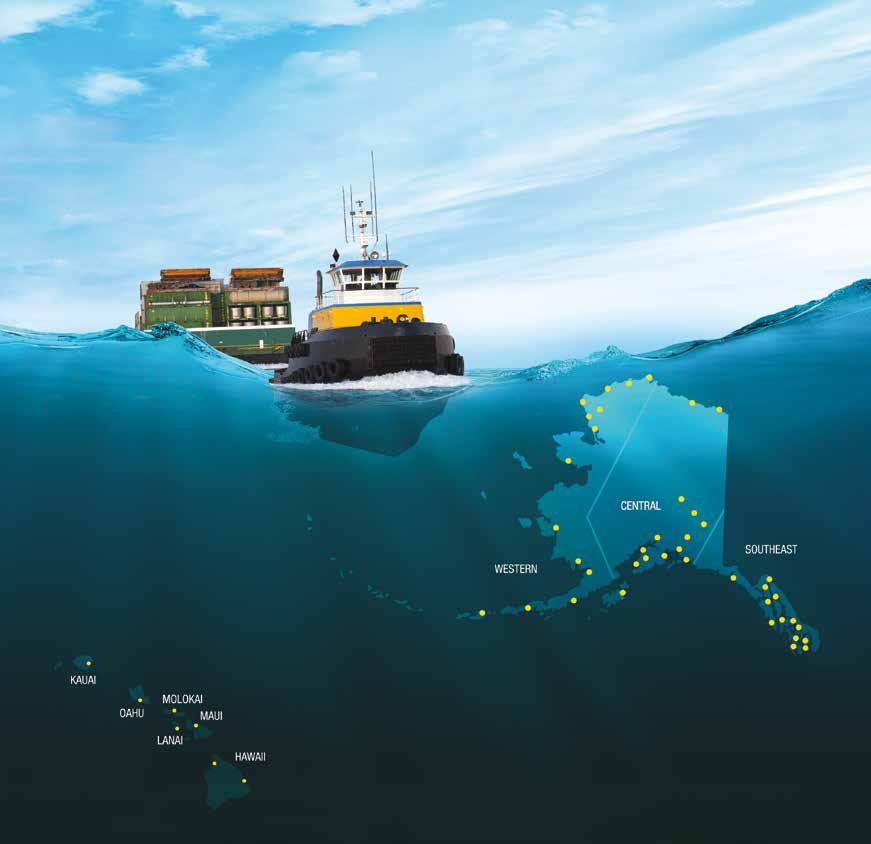What goes into a gallon of gas?


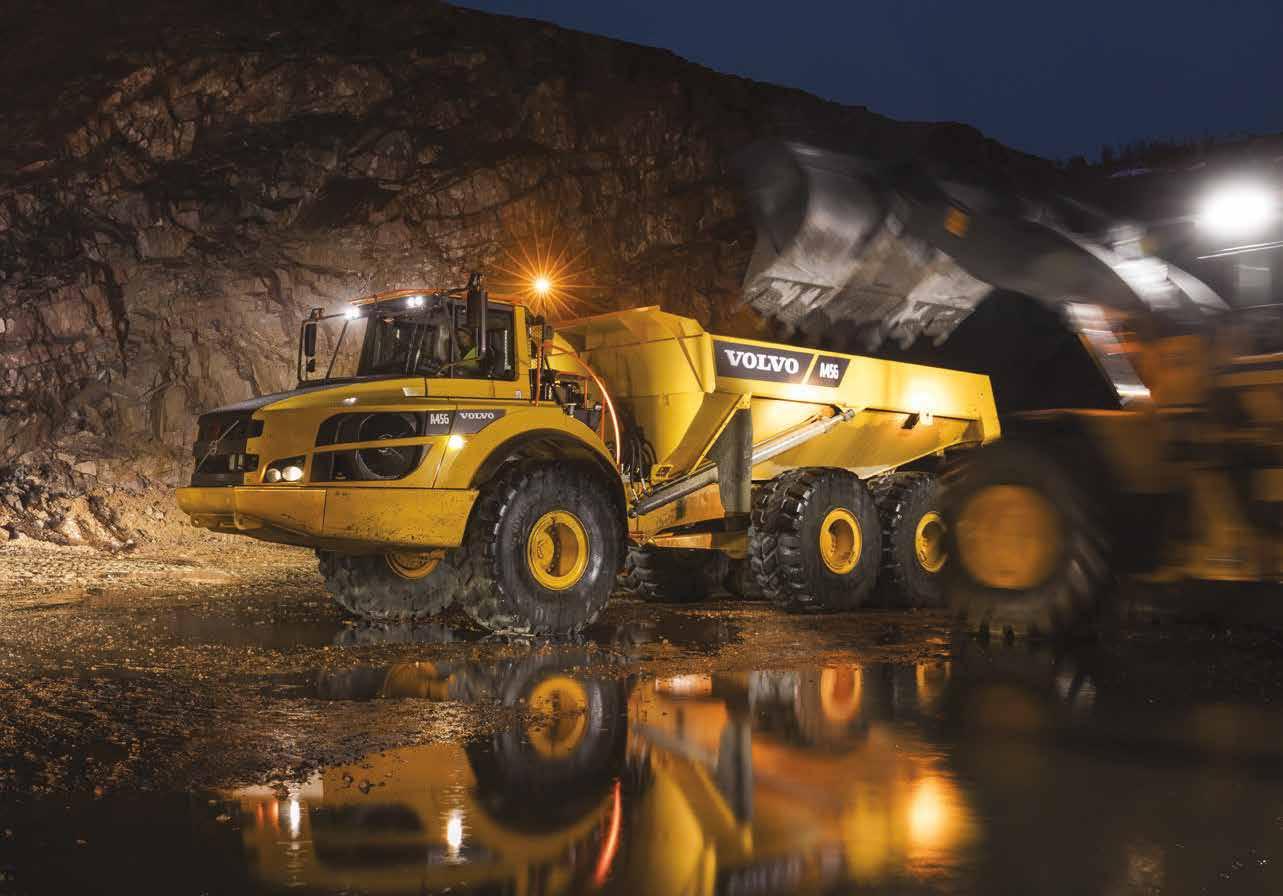






What goes into a gallon of gas?








As First National enters a second century of investing in Alaska, you and your financial needs will continue to come first. From buying a home to growing your business, you can count on our experienced team to deliver personalized service and innovative banking solutions to help you shape a brighter future.
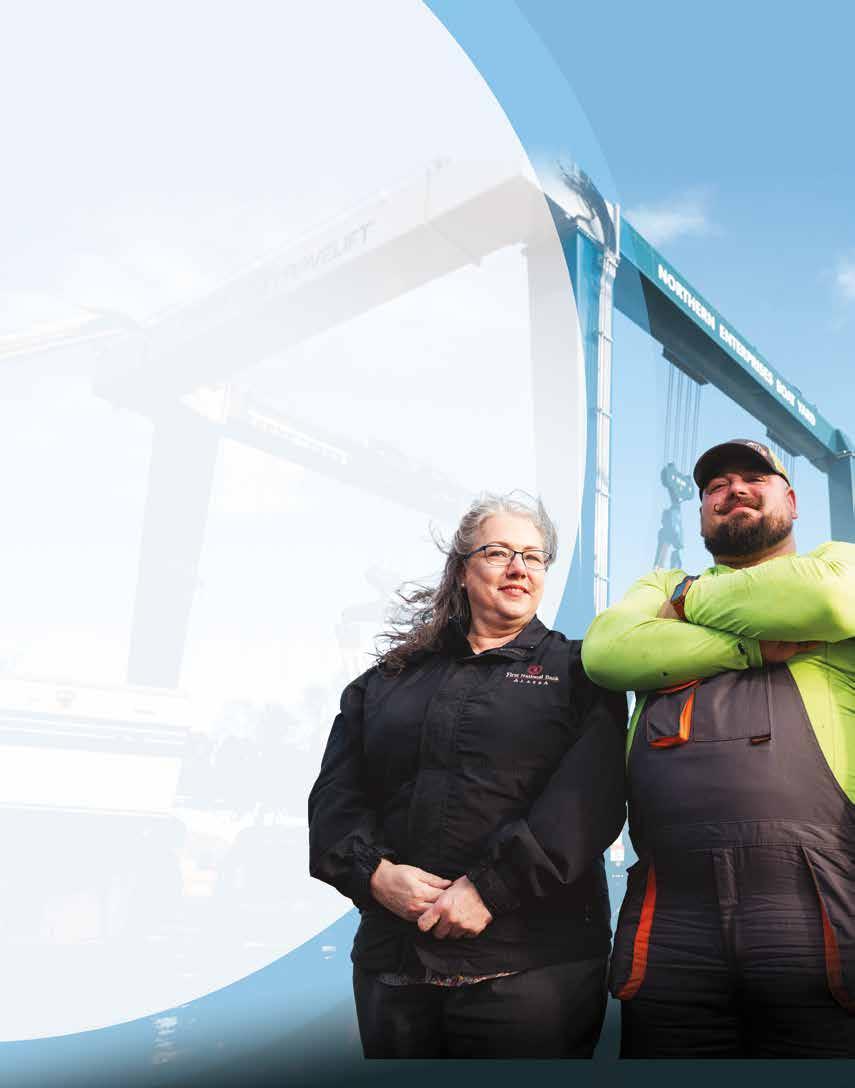
FNBAlaska.com
907-777-4362
A widespread misconception in Alaska is that the state’s crude oil is shipped away, refined Outside, and returned to be sold as fuel. The last part is not entirely true, so a fact reported in this month’s cover story bears repeating here: most of the gasoline in Southcentral Alaska (and thus, most gasoline sold in the state) is produced and refined locally.

The refinery in Nikiski does heroic work to keep Alaska’s

motors running, as do the state’s other refiners, distributors, and retailers. To better understand the unsung industry underpinning every mode of transportation, Vitus Energy granted us a closer look at its Midtown Anchorage gas station. We choose to light a candle rather than curse the darkness of another price hike.
But please don’t light a candle next to a gasoline pump.


I’m probably biased, but it’s my experience that Alaskans have very grounded conversations about energy. We won’t dive into a new energy technology unless we check the temperature of the pool or the chlorine content in the water—and, wait, is something living in there? We know that any transition from one energy source to another requires engineering services, construction labor and materials, transportation solutions, maintenance training, funding (probably from more than one source), community buy-in, and the understanding that a change in energy generation may bring a change—positive or negative—in jobs or economic activity. None of Alaska’s rural communities are pursuing solar, hydroelectric, geothermal, biomass, or wind power systems because they’re trendy. They have multiple goals to address, including the reliability of the energy source, the cost to the community, and how energy generation affects their people and their environment.
That thinking isn’t restricted to rural communities. Along the Railbelt, Alaskans are looking at all energy options to find what works best and when. All energy sources have pros and cons, and what Alaskans find in urban and Bush communities is that the best solution often is a combination of hydrocarbons and renewable energy sources.
This idea is exemplified by the Alaska Sustainable Energy Conference, taking place at the end of this month. The sponsor list for the conference includes many of the state’s energy utilities, agencies, and producers—including Usibelli Coal Mine, Hilcorp Alaska, the Alaska Oil & Gas Association, and the Alaska Gasline Development Corporation. Alaska’s oil, gas, and coal providers are investing in conversations about a sustainable future—as they should. Natural resource extractors are and should be held to high social and environmental safety standards. And since Alaska’s energy future includes hydrocarbons, even as it adopts other energy sources, those companies’ involvement in conversations about that future is critical.
May has historically been our oil and gas issue, but it’s evolving into an energy issue, which I find exciting. Alaska was built on energy and continues to be an energy testing ground and innovator. With potential geothermal and micronuclear projects on the horizon, Alaska is dipping its feet into every energy pool, testing the waters and exploring the potential of their depths. We’re highly qualified to do it.
VOLUME 39, #5
EDITORIAL
Managing Editor
Tasha Anderson 907-257-2907 tanderson@akbizmag.com
Editor/Staff Writer Scott Rhode srhode@akbizmag.com
Editorial Assistant Emily Olsen emily@akbizmag.com

PRODUCTION
Art Director Monica Sterchi-Lowman 907-257-2916 design@akbizmag.com
Design & Art Production Fulvia Caldei Lowe production@akbizmag.com
Web Manager Patricia Morales patricia@akbizmag.com
SALES
VP Sales & Marketing Charles Bell 907-257-2909 cbell@akbizmag.com
Senior Account Manager Janis J. Plume 907-257-2917 janis@akbizmag.com
Senior Account Manager Christine Merki 907-257-2911 cmerki@akbizmag.com
Marketing Assistant Tiffany Whited 907-257-2910 tiffany@akbizmag.com
BUSINESS
Tasha Anderson Managing Editor, Alaska BusinessPresident Billie Martin VP & General Manager Jason Martin 907-257-2905 jason@akbizmag.com
Accounting Manager James Barnhill 907-257-2901 accounts@akbizmag.com
CONTACT
Press releases: press@akbizmag.com
Postmaster: Send address changes to Alaska Business 501 W. Northern Lights Blvd. #100 Anchorage, AK 99503

AKBusinessMonth alaska-business-monthly
AKBusinessMonth akbizmag

In April, Alaska USA Federal Credit Union began operating under a new name—Global Credit Union— to symbolize its expanded service worldwide and bold aspirations for the future. The name change followed its August acquisition of Spokane, Washington-based Global Credit Union, which created one of the fifteen largest credit unions in the nation.
The rebranded financial institution now operates seventy-nine branches in Alaska, Arizona, California, Idaho, Washington, and Italy; has more than 2,200 employees and 750,000 members; and holds $12 billion in assets. A member-owned, not-forprofit cooperative, Global Credit Union offers a full range of financial services, including checking and savings accounts, consumer loans, real estate loans, mortgage loans, credit cards, business services, and personal insurance.

When the two institutions officially merged last year, Alaska USA was operating sixty-seven branches in Alaska, Arizona, California, and Washington, with nearly 2,000 employees serving more than 700,000 members. Spokane’s Global had 45,000 members, twelve branches in Washington and Idaho, and three additional branches on US military installations in Italy. Although Global was the smaller of the two entities, Alaska USA opted to assume its name for various strategic reasons.
The name “Global Credit Union” supports Alaska USA’s future growth, according to President and CEO Geoff Lundfelt. The appellation is also recognizable, easy to associate, and matches the credit union’s geographic trajectory. “The Global Credit Union name reflects our future and represents the diversity of our membership, which spans all fifty states and over twenty countries,” Lundfelt says. “The new brand is a better representation of the geographical diversity that our membership represents.”
Jettisoning a brand that’s so familiar to Alaskans comes with some uncertainty. However, Lundfelt accepts the risk: “We're changing our name because it's important for the longterm financial health and stability of the organization. This was an inflection point, and I promise you it was not an
easy decision. Important decisions are rarely easy in our personal or professional lives. We're going to be a 75-year-old company this year. We don't manage to financial quarters; we manage to quarter centuries so that we can continue to serve the generations to come.”
The name change ripples down to the credit union’s subsidiaries and other organizations. Alaska USA Insurance Brokers was changed to Global Credit Union Insurance Brokers, and Alaska USA Mortgage Company is now Global Credit Union Home Loans. Alaska USA Financial Planning and Investment Services has become Global Retirement and Investment Services. And the Alaska USA Foundation is now called Global Credit Union Foundation.
Likewise, Global Credit Union unveiled a new logo design that acknowledges and honors its deep roots in Alaska. The “A” in “Global” is a direct nod to the mountainous geography of the credit union's Alaska beginnings. The blue and gold colors are also a gesture to the colors on the Alaska state flag. And the gold “summit” of the letter is an arrow, pointing to the future of its members’ financial well-being.
Other than new signage and letterhead, services for the credit union’s members remain the same. Members can continue to access account information and normal products and services in the same way they always have—in branches, online, and through a 24/7/365 contact center.

Another key aspect that the credit union is not altering is the location of its headquarters. “We are proud of our Alaska heritage,” Lundfelt explains. “Our headquarters will remain in Anchorage. Six of our seven board members reside in Southcentral Alaska. I was born and raised here. Most of our key executives live in Alaska.”
With more than 1,100 Alaska employees, Global Credit Union is

“The merger with Alaska USA and Global allows us to offer membership to all service members, active duty and retired, wherever they may reside… This gives them greater choice when selecting a financial institution.”
Jack Fallis, Regional President of the Pacific Northwest and International Markets, Global Credit Union
a significant employer in the state.
It operates in fourteen distinct communities and maintains a separate foundation, a 501(c)(3) nonprofit that has given millions of dollars back to communities throughout Alaska. The institution also supports other nonprofits and charitable causes to help ensure that Alaska’s communities are better places to live, work, and play. “We run United Way campaigns and support smaller organizations that focus on needs-based charity work with children, including critical issues like food insecurity,” Lundfelt says. “And we support our junior enlisted men and women, making sure those families can put food on the table and provide school supplies for their kids. Our roots are firmly planted in Alaska, and that will not change,” Lundfelt says.
Established in 1948 as Alaskan Air Depot Federal Credit Union, the cooperative expanded into Washington under a merger with Whidbey Federal Credit Union in 1983. It began operating
in California with the acquisitions of High Desert Federal Credit Union in 2009 and Arrowhead Credit Union in 2010. The credit union continued to grow its presence in the Lower 48 with branches in the Phoenix, Arizona area, including seven branches acquired from TCF Bank in 2020.
Last year’s merger further enhanced Alaska USA’s strength in the United States and beyond. The calculated move enabled the credit union to leverage the positive attributes of another complementary institution with a similar focus. Global, like Alaska USA, was initially established to cater to military service members and later underwent a strategic transformation.
It was founded in 1954 as Fairchild Federal Credit Union to serve military and civil service employees on Fairchild Air Force Base. In 1988, the institution changed its name to Global Credit Union to better reflect its diverse membership and enhance potential for growth.
The recent merger expands the credit union’s presence in Spokane, in parts of northern Idaho, and on three

US military bases in Italy. “With that merger came something else incredibly significant: an opportunity to expand beyond our original charter comprised of military members who were on specific installations in Alaska to anyone who works in the US Department of Defense worldwide,” Lundfelt says. “That includes civilians, active-duty military of every branch of our services, reservists and their family members—a group of over 6 million people who can join our organization now.”
Growth means strength—and a strong credit union is good for its members and the communities where it operates, Lundfelt says. “From humble beginnings, Alaska USA—now Global Credit Union—is honored to serve over 750,000 members, a large number of whom live in Alaska,” he says. “We have members who live in all fifty states and in over twenty foreign countries, a growing number of people who understand the benefits of being a member of a financial services cooperative.”
Alaska USA’s consistent expansion has significantly enhanced its ability to

Credit Union 1 is continually growing and adapting to better serve our fellow Alaskans. Whether that’s through cutting edge online services or in-person financial support, we’re here to meet you where you’re at and help you reach for what’s next. YOU are our friends, neighbors and future!
In 2024, we’ll be opening doors at our new Wasilla location.
provide products, services, and other benefits to a broader membership base. Over the years, the credit union has always focused on providing value to its members through competitive pricing on products, as well as superior service in the forms of convenient branch and ATM locations, contact center, and state-of-the-art mobile products, according to COO Elizabeth Rense Pavlas. “Those products and services are expensive to provide, yet we are able to maintain that service model with incredibly competitive pricing because of the scale of our large member base,” she says. “The merger adds to that base and expands our member charter, allowing more people to choose us as their financial institution. It’s a symbiotic relationship where growth does allow for enhancements to what we can provide.”








However, Alaska USA does not grow just for the sake of growth, says Pavlas, a lifelong Alaskan who has worked at the credit union for fifteen years. “We don’t accept every merger opportunity and only expand when it strategically makes sense for our members and for the health of the credit union,” she explains. “I’m proud to be part of the team that is leading us through an interesting economic time with factors the banking industry has never seen before. Our growth is an important factor in our future.”
Former Global President and CEO Jack Fallis says he “could not be more pleased” with the merger with Alaska USA. “The members of Global Credit Union now have a greater number of world-class products and services that the smaller credit union simply could not afford to offer,” says Fallis, who currently serves as regional president of the Pacific Northwest and international markets for the merged credit union. “That—along with our 24/7/365, entirely US-based member call center—offers them personal


“We're changing our name because it's important for the long-term financial health and stability of the organization. This was an inflection point, and I promise you it was not an easy decision.”
Geoff Lundfelt President and CEO Global Credit Union
service and access to information when it’s convenient for them.”
Fallis also emphasizes that the consolidation of the two financial institutions enhances Global’s ability to provide products and services to a broader membership base. “The merger with Alaska USA and Global allows us to offer membership to all service members, active duty and retired, wherever they may reside,” he explains. “This gives them greater choice when selecting a financial institution.”
For seventy-five years, Alaska USA has instituted a variety of practices to help its members reach their financial goals. For example, it was the first Alaska-based financial institution to remove non-sufficient fund fees for members who choose overdraft protection, according to Lundfelt. “We have lowered those costs as well,” he says. “For members looking to save, there are no maintenance fees on savings and money market accounts, and we have increased dividend rates on money market and CDs. The combination of those changes will put over $12 million annually back in our members’ pockets.”
The credit union’s growth—its strength in members—allows it to provide exceptional value to the individuals it serves and give back to the community, Lundfelt says. Its members save on average $175 per year over traditional banks. The institution has raised more than $4 million through the Alaska USA Foundation for organizations supporting children, veterans, activeduty military members, and their families.
For example, the Cash for Cans program, initially created and trademarked by the Alaska USA Foundation, enables the credit union to help raise funds to fight food insecurities in all its markets. “A few years ago, we partnered with other credit unions in Alaska through the Alaska Credit Union League to broaden the reach of this muchneeded program,” Lundfelt says. “We love partnering with our fellow credit
unions in all the states we serve and do so on a regular basis. That’s a wonderful part of credit unions; their whole focus is ‘people helping people,’ which means we work together to better the communities we serve.”
Under its new identity, the credit union is capitalizing on its “strength in members” to provide better rates, lower fees, and the latest in banking technology with accessible, aroundthe-clock, entirely US-based member service. In fact, it recently opened a new 24/7 Member Service Center in Fairbanks—its second in Alaska. “Global Credit Union is positioned to grow with our members, to serve them wherever they are in the world,” Lundfelt says.
In addition, Global Credit Union is currently rolling out new technology in the form of a mobile app that allows users to complete transactions and aggregate all their accounts—even their non-credit union accounts—so they can see a global financial picture of their finances. The new app also provides a variety of budgeting tools to help members manage their money.
While Global Credit Union now represents an institution that is 750,000 members strong globally, its inherent strength stems from one key factor: its focus on each individual member and their specific needs. This includes offering competitive deposit and borrowing rates, reducing and eliminating fees, providing state-ofthe-art online banking technology, and being committed to member service, according to Lundfelt.
“During COVID, when many companies were giving up on providing contact centers staffed by humans, we doubled down, expanding our entirely US-based Member Service Center,” the CEO says. “We’re proud to say that if a member needs a problem solved, wherever they are in the world at any time of the day or night, they can reach us.”
As for the future, Global Credit Union aims to continue enhancing its services and expanding its geographic presence to better serve its members in Alaska and worldwide.

“It’s a symbiotic relationship where growth does allow for enhancements to what we can provide… We don’t accept every merger opportunity and only expand when it strategically makes sense for our members and for the health of the credit union.”
Elizabeth Rense Pavlas COO Global CreditUnion

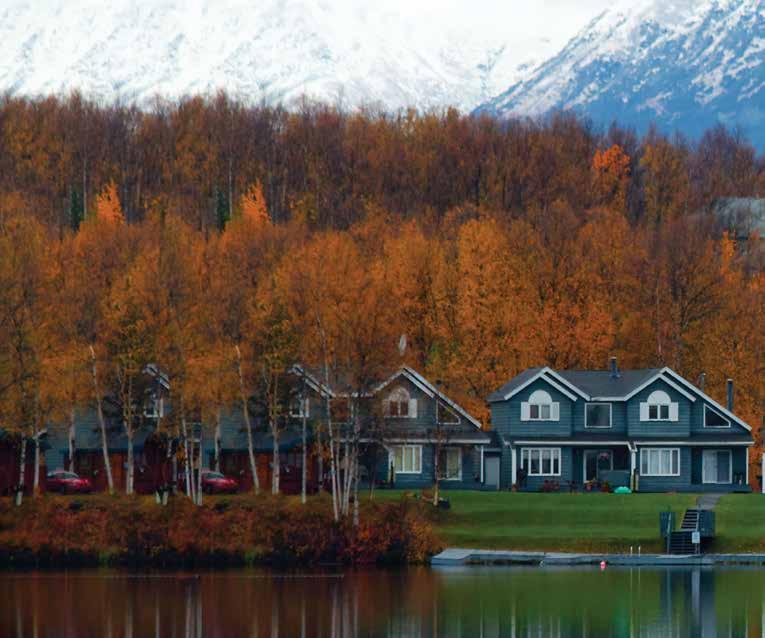
“People really want to look for a place that they can feel like it’s their home,” says Wasilla dentist Tyler Mann. “People want a personal connection to where they go, so we try to be part of the community and participate in community events. We don’t want to lose that connection.”
To keep the connection with his patients, Mann Family Dental had to expand last fall, keeping pace with the community’s growth. The population increase in the Matanuska-Susitna Borough has brought an increased need for all services, particularly healthcare. For decades, Mat-Su residents seeking medical care had two options: wait to get an appointment with one of the few providers close to home or make the trek to Anchorage, neither of which were always practical. But the Mat-Su’s growing population has allowed the number, type, and availability of service providers to begin catching up with demand.
“You sort of hit critical mass where people are going to want to get their healthcare services where they live,” says Joshua Arvidson, COO of Alaska Behavioral Health, which opened a clinic in Wasilla in April. “I think that’s an evolution in the community—and really a great thing, to have services accessible here. And that can happen now because there’s enough of a population.”
The Alaska Department of Labor and Workforce Development’s (DOLWD) 2016 “Alaska Economic Trends” report showed that the Mat-Su Borough’s population increased by 54 percent between 2000 and 2013. The US Census Bureau reports a 20 percent increase from 2010 to 2020. The 2022 “Alaska Economic Trends” estimated that as of July 1, 2021, the Mat-Su population was 108,805.
All indicators show that Mat-Su’s growth is expected to continue. DOLWD projects that the Mat-Su Borough’s population will increase by 35.6 percent between 2021

and 2050; only Skagway is expected to experience a greater percentage growth, at 45.3 percent. In absolute terms, the Mat-Su Borough’s growth will be the largest in the state, and all the projected growth in Southcentral Alaska over that period is expected entirely in the Mat-Su; Anchorage is projected to experience a 3.4 percent population decrease.
“We’re trying to be where the people need us to be to give them care that’s easy and accessible,” says Cyndi Cielsak, clinic manager for Providence ExpressCare, which opened its Wasilla clinic in 2021. “Being where they need us to be rather than us trying to define all the rules.”
Cielsak says offering care in the MatSu is a matter of meeting patients where they are. More healthcare providers closer to home also means providers can build stronger connections within the community and become more invested in their patients’ lives, which improves care overall.
Providence Alaska Medical Center’s ExpressCare clinic offers patients same-day, episodic care at five express care clinics—three in Anchorage, one in Eagle River, and its newest in Wasilla.


“Episodic care is the little episodes of care that you need to get dealt with that are very, very low acuity,” Cielsak explains. “That could be an ear infection, pink eye, a cold or fever, or maybe you have a rash or some minor irritation.”
Access to primary care services, especially same-day care, is difficult across Alaska, so the ExpressCare Clinic’s goal is to provide that access.
“Primary care is tough, and it’s especially tough if you need same-day or urgent care,” Cielsak says. “It can be something small, but if you need it today, it’s even more difficult, so that’s why we decided to expand our services to the Mat-Su area.”
After COVID-19 pandemic-related setbacks, the ExpressCare Clinic opened in 2021. In addition to treating non-acute conditions, the clinic offers flu, tetanus, diphtheria, and pertussis vaccinations, and it can test for COVID-19, strep throat, mononucleosis, tuberculosis, and pregnancy. Providers can also fill select prescriptions, draw any needed
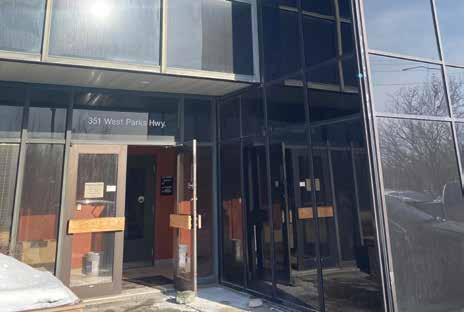 Mann Family Dental in Wasilla relocated its practice in October and moved into a new, larger building that’s more accessible and more comfortable than its previous location.
Mann Family Dental
Alaska Behavioral Health’s Wasilla clinic opened in April and provides comprehensive outpatient behavioral health services to children and adults.
Mann Family Dental in Wasilla relocated its practice in October and moved into a new, larger building that’s more accessible and more comfortable than its previous location.
Mann Family Dental
Alaska Behavioral Health’s Wasilla clinic opened in April and provides comprehensive outpatient behavioral health services to children and adults.
labs, and make referrals for diagnostic imaging or other care to its urgent care clinic or the emergency room.



The ExpressCare clinic is staffed by a two-person team—one provider and one assistant—or patients can choose to connect with its network of virtual providers. Appointments are scheduled for 20 minutes and can be booked online. Walk-in appointments are available, but because patients will be seen at the next available time slot, Cielsak recommends scheduling an appointment online and waiting at home rather than in the clinic’s lobby.
The clinic near the Wasilla Target store is open daily from 7:00 a.m. to 7:00 p.m. It accepts most commercial insurances, Medicare, Medicaid, and has a self-pay option.
“We like to have you in and out, registered in the door and then leaving within 20 minutes,” Cielsak says. “You can get it done on the way to work, get your prescription filled, and pick it up on your way home.”

On the other side of Wasilla Lake, another primary and urgent care option came to the Wasilla area last summer for patients in the Pacific Health Coalition.
The Pacific Health Coalition represents forty-five participating health plans across the Pacific Northwest and offers cost-effective alternatives to office visits through health centers. In Alaska, that care is provided through the Coalition Health Center (CHC), which has clinics in Anchorage, Fairbanks, and, as of July 2022, the Mat-Su.
“We are thrilled to bring our services to our many clients in MatSu, something we have hoped to do for quite some time,” says Amanda Johnson, CEO of Beacon OHSS, which operates the CHC. “As our clients and partners have grown along with us, it was important for Beacon to continue to offer a convenient and quality option for services close to home.”
Like its Anchorage and Fairbanks counterparts, the Mat-Su clinic on Bogard Road provides primary and preventive care and chronic and acute illness prevention and management, as well as prescriptions, X-rays, and laboratory services. CHC services are available to coalition plan members and





“Primary care is tough, and it’s especially tough if you need same-day or urgent care… It can be something small, but if you need it today, it’s even more difficult, so that’s why we decided to expand our services to the Mat-Su area.”
Cyndi Cielsak, Clinic Manager, Providence ExpressCare
their dependents on an appointment and walk-in basis.

“The time to provide someone with behavioral health services is the day they ask for it, not months later,” says Arvidson. With the April opening of Alaska Behavioral Health’s Wasilla clinic, Mat-Su residents can get comprehensive outpatient services as soon as they need it, without the need for weekly drives to Anchorage.
“It’s something we’ve been working towards for a very long time,” Arvidson says. “We’ve wanted to bring our care to our existing Mat-Su client population for quite some time and also respond to the needs for mental health services. We have families and individuals that drive in [to Anchorage] from the Valley, and that’s just really not realistic.”
The Wasilla clinic, Alaska Behavioral Health’s third in Alaska (it also operates clinics in Anchorage and Fairbanks), is a federally designated certified community behavioral health clinic, or CCBHC, Arvidson explains. CCBHCs operate under standards imposed by the Substance Abuse and Mental Health Services Administration, which focus on providing access to care and offering a full continuum of services centered around evidence-based practices and treatments.
The Wasilla clinic’s services are similar to those offered at Alaska Behavioral Health’s Anchorage and Fairbanks clinics, with slight variations to accommodate the community’s specific needs, Arvidson says. In the Mat-Su, the biggest identified need is for children’s mental health services.
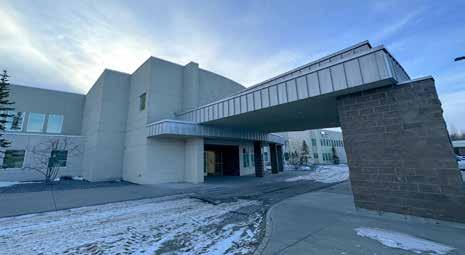
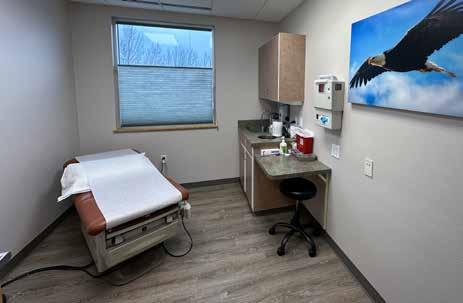
“A lot of needs assessments that have been done by the Mat-Su Health Foundation show a need for children’s mental health, and we’ve gotten that feedback from local providers as well,” Arvidson says. “We’re going to adapt to the needs of the community.”
Roughly half of the services provided at Alaska Behavioral Health’s Wasilla clinic focus on children, Arvidson says, though it continues to serve the whole life span. Most of Alaska Behavioral Health’s services are focused on therapy, “and we do that because that’s what the evidence says is the best frontline intervention for mental health challenges,” he says. The clinic
The Coalition Health Center, operated by Beacon OHSS, opened its Mat-Su clinic in 2022. It offers primary and preventive healthcare to coalition members and their dependents. Beacon OHSSalso offers integrated medical care, an on-site psychiatrist, and primary care for adults.
Having mental health services in the community means better access to services and increased opportunities for community outreach, which means better care overall.
“It allows us to build relationships with schools and the local physicians’ clinics and other things that are really beneficial to patients,” Arvidson says. “It’s not just more connections; it’s better care because it’s in your community.”


Deaths from accidental drug overdoses are increasing nationwide, but nowhere more so than in Alaska. In 2022, the Centers for Disease Control and Prevention National Center for Health Statistics reported that Alaska had a 75.3 percent increase in overdose deaths compared to 2020, five times larger than the 15 percent national increase. The Alaska Department of Health and Social Services’ Opioid Data Dashboard reports 169 overdose
deaths from September 2021 to August 2022. Between December 2021 and November 2022, the MatSu Borough led the state in opioidrelated emergency room visits, at 41.8 per 10,000 visits, nearly 1.5 times the rate of visits in Anchorage, which ranks second.
To help combat these numbers, in November 2022 True North Recovery opened Dylan’s Place, an eight-bed residential withdrawal management program. Located in Wasilla, Dylan’s Place is the first and only residential detox facility in the Mat-Su, and one of only a dozen in Alaska. The facility specializes in helping people with methamphetamine and opiate misuse disorders, but it can help patients detox from any substance, True North Recovery founder Karl Solderstrom said in a video posted to its Facebook page in January.
Located within True North Recovery’s Day One Center, Dylan’s Place offers same-day access and provides people dealing with substance misuse a safe, supervised place to go through withdrawal. In addition to the detox
“We’ve wanted to bring our care to our existing Mat-Su client population for quite some time and also respond to the needs for mental health services.
We have families and individuals that drive in [to Anchorage] from the Valley, and that’s just really not realistic.”
Joshua Arvidson, COO, Alaska Behavioral Health
facility, patients have access to crisis services, treatment assessments, peer specialists, and case managers.
Mann Family Dental opened an expanded dental practice in October 2022, just a few miles from the space it occupied since it first opened in 2017. The location in the North Lakes area, between Wasilla and Palmer, puts it in a community with a larger population than either of the Mat-Su’s main incorporated cities, yet nearly equidistant from both.
The new practice, which takes up the entire first floor of a two-floor building, improves accessibility and is larger than the prior location, making it more comfortable for patients and staff. The extra space also allowed Mann to bring on two additional dentists. He says the expansion was necessary if he wanted to continue to provide the same level of service to his existing patients and treat new ones.
“The practice was getting so big, either I had to cut insurances and become out-of-network for patients, or I had to expand,” Mann explains. “I felt like if I was going to become outof-network, to me it feels like breaking a promise, so I had to make a change.”
Mann Family Dental provides general dentistry to children and adults, which includes preventative care, restorative and cosmetic dentistry, and some orthodontic care. Mann says the clinic gets patients from as far north as Talkeetna, Willow, and Houston because of the lack of providers in those areas. All three of Mann Family Dental’s providers accept Medicaid, which Mann says is becoming a rarity; he estimates Wasilla lost half of its Medicaid providers in the last year.
The new space allows the practice to continue to serve its long-standing patients and accommodate the growing number of people moving to, and seeking healthcare in, the Mat-Su.


“There’s just a need,” Mann says. “There are lots of dentists, and lots of good dentists, in the Valley, but there’s still an influx of people every year.”
Mann practiced in Colorado and New Mexico before coming to Alaska in 2017. His initial plan was to take over a dental practice in Eagle River, but after arriving he chose instead to settle in Wasilla, becoming one of the many Alaskans adding to the Mat-Su Borough’s population growth.

“We felt like the Valley was better,” Mann says. “It felt more like home than anything.”

“You sort of hit critical mass where people are going to want to get their healthcare services where they live… I think that’s an evolution in the community—and really a great thing, to have services accessible here. And that can happen now because there’s enough of a population.”
Joshua Arvidson, COO
Alaska Behavioral HealthPrognosis: population growth of nearly 40,000 by 2050. Treatment: add more healthcare services to the Mat-Su Borough.




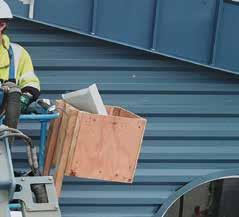
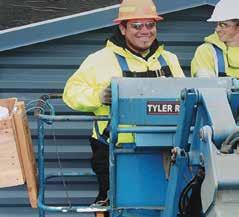







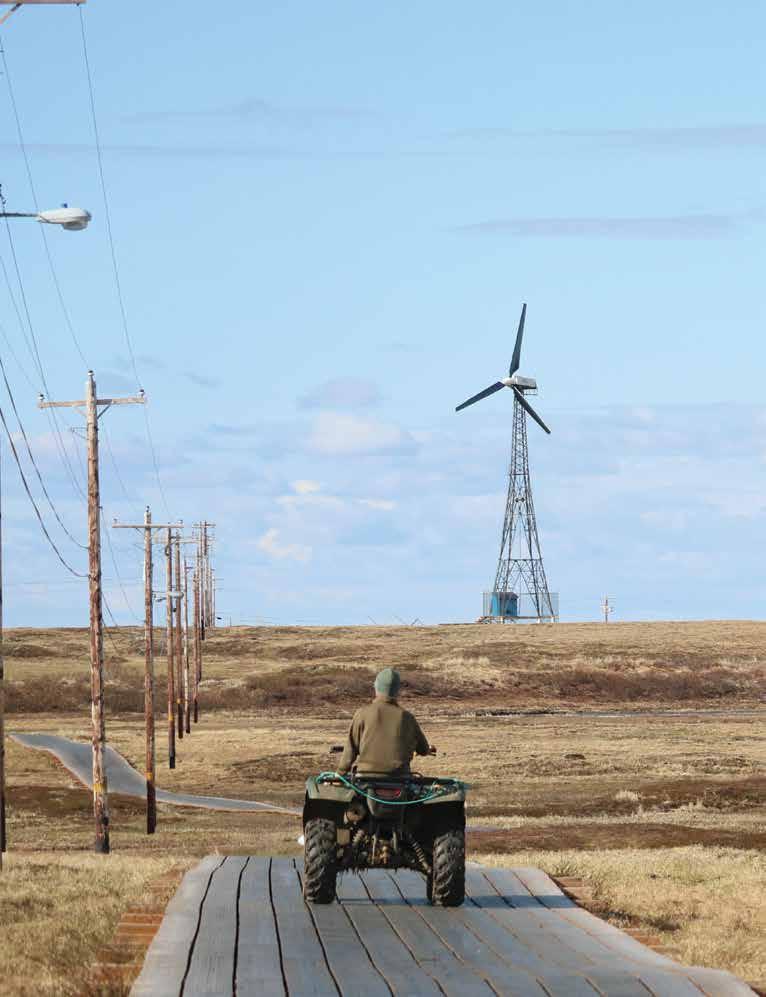 By Rachael Kvapil
By Rachael Kvapil
Leave a place better than you found it: the Campground Rule is well known and practiced by anyone who roams the outdoors responsibly. Given that the Latin word for camp is the root of the English “campus,” higher education has assimilated the same ethos.
The three main campuses of the University of Alaska system each have an Office of Sustainability to coordinate efforts to reduce the impact of the institution on the environment and to conserve resources for future generations.
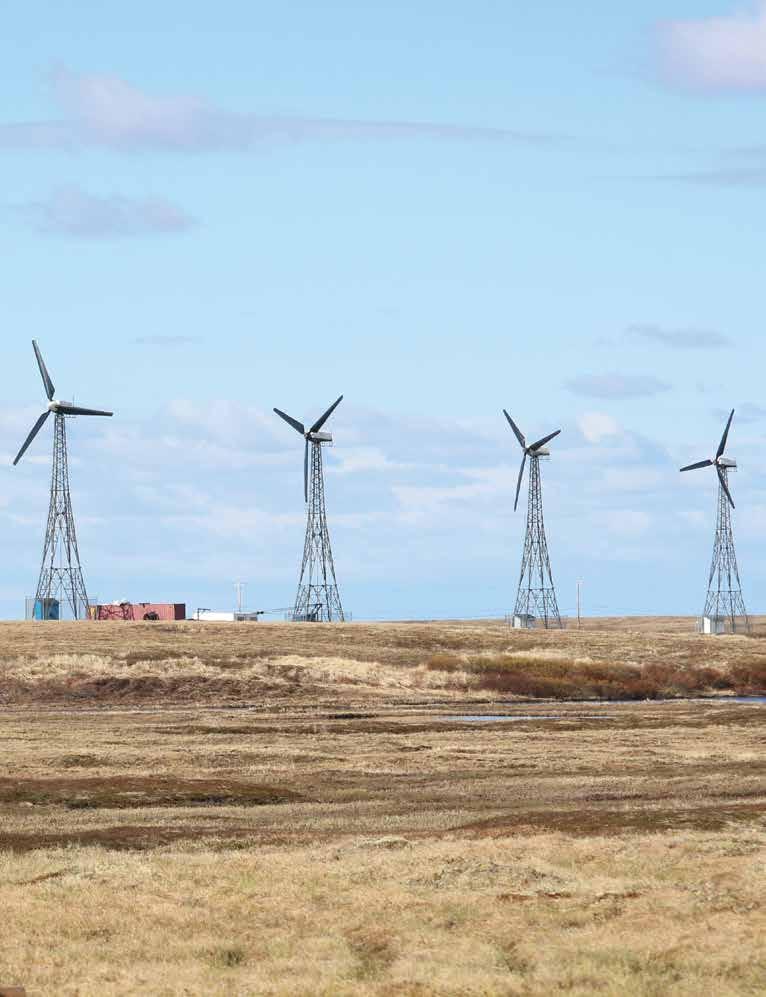
At UAA, the most visible program is gathering, sorting, and processing recyclable paper, cardboard, plastics, glass, aluminum, and even vegetable waste from student food services. The
office calls recycling a “gateway to sustainability.” Other initiatives include testing the efficiency of light fixtures, landscaping with site-appropriate plants to minimize maintenance inputs, and replacing disposable eating utensils with reusable tableware at the dining commons.
At UAS, three buildings at the Juneau campus are heated with air source heat pumps. Also, given the high rate of electric vehicle adoption in the capital city thanks to its abundant hydropower, the university hosts two charging ports.
For UAF, students are leading sustainability. In April 2009, the Associated Students of the University of Alaska Fairbanks (ASUAF) approved a $20 per semester Students Initiative
for Renewable Energy Now fee. They later shortened the name to the Student Sustainability Fee for clarity, and a student sustainability board formed to ensure student control of the fees collected. For five years, the Office of Sustainability funded more than fifty student-led sustainability programs and projects in the areas of energy, waste reduction and recycling, transportation, food, and education. As the budget landscape changed, steps were taken to restructure the program, and ASUAF voted to make the sustainability fee permanent.
The Office of Sustainability’s main mission is to make UAF a model for the Circumpolar North and beyond by incorporating sustainability into
Amanda Byrdcurriculum, operations, campus life, and the greater community. In 2014, the UAF Sustainability Plan outlined ways to develop sustainable practices across campus, and UAF Sustainability Coordinator Christi Kemper says at least half of that plan was implemented.
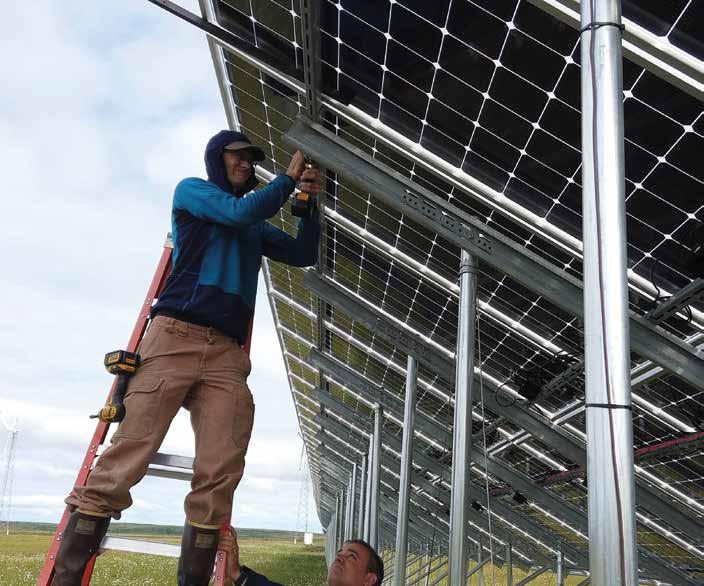
“Early on, we funded a variety of sustainability projects, including energy projects,” says Kemper. “Now our focus is on a handful of studentrun programs that advocate waste prevention and education.”
There are six main programs overseen by the UAF Office of Sustainability. The recycling program employs students to conduct bin pickups around campus, including the dormitories. A team of students collect paper, aluminum, #1 and #2 plastics, and other items for transportation
to the Fairbanks North Star Borough Central Recycling Facility.
The Green Bikes Program offers students a more affordable and sustainable source of transportation. Students are offered discounts for long-term rentals of commuter bikes, tandem bikes, and fat-tire bikes capable of handling winter snow and ice.
The Nanook Grown program provides gardening education to students each summer from peer mentors that work under the guidance of a horticulture professional. Students gain access to fresh produce through this program, and excess food is used at a weekly market table near the UAF Wood Center or donated to programs that feed community members experiencing food insecurity. The program also offers events like zerowaste cooking workshops and farmto-table dinners.
The Food Pantry program assists students on campus experiencing food insecurity by providing one bag of food per week filled with canned items and shelf-stable foods along with other hygiene products.
The Free Store Program is a central, organized location for the campus community to drop off unwanted items or pick up something without an additional charge. Working under the motto “Take what you need and leave what you don’t!” the goal is to reduce waste, save usable items from landfills, and get items to those who can use them.
Along these same lines, the Upcycle Annex program is a studentrun repair café where people can fix items rather than throw them away. Tools and supplies are provided to students along with the help of volunteers to restore things ranging from household appliances and
Alaska Center for Energy and Power’s Chris Pike installs a monitoring camera on a solar panel in Kotzebue, 30 miles north of the Arctic Circle. The solar panel is part of the 576kW bifacial array owned and managed by Kotzebue Electric Association.mechanical devices to computers, bicycles, clothing, and more.
In addition to their main programs, Kemper says the Office of Sustainability works with students to develop interdisciplinary internships that incorporate sustainability practices. She says that more businesses are looking for employees who have sustainability skills, whether it’s developing a zero-waste system or finding ways to better use resources on hand. Likewise, she says students are more aware of climate change and are looking for ways to make realistic lifestyle changes to counteract the problem.
Though “sustainable” and “renewable” are two terms used interchangeably when discussing alternative energy, they aren’t completely the same. Sustainability is concerned with living in a way that won’t jeopardize the needs or future generations, whereas renewable energy is any source that can replenish fast enough to keep up with consumption. Many of the popular sources of sustainable energy are also renewable and the primary focus of researchers at UAF, in particular at the Alaska Center for Energy and Power (ACEP).
Chris Pike, a research engineer at ACEP, will be the first to admit there is no magic bullet when it comes to offsetting fossil fuels. Sustainable systems that work well in one region of the state are difficult to implement in another. For instance, Juneau’s coastal environment allows the community to produce nearly all its electricity using hydropower while Interior locations near Healy and Delta Junction are more suitable for wind projects. Pike’s specialty is solar energy.
“What we’re looking at is different than a solar research institute like Arizona State University. Our focus is on cold region and high latitudes,” he says.
ACEP started solar data collection in 2012 when it produced a report on solar thermal systems in the Arctic. In 2017, ACEP published an Alaska solar technology review paper followed by the creation of the Solar Technologies Program, the publication
of "A Solar Design Manual for Alaska," and the construction of the UAF solar test site. Pike says much of this information came from tracking existing solar energy systems. The Solar Technologies Program also conducts field-deployable irradiance measurements, site feasibility assessments, and performance and cost analysis.
Part of the program’s mission is to make sure people have realistic expectations of solar technologies. In Alaska, solar technologies are great in

the spring and summer months but less so in the winter. Currently, there aren’t any feasible long-term storage options that allow people to harvest solar energy in the summer for winter use.
“This means solar panels aren’t generating solar energy during the darkest, coldest parts of the year when we need additional electricity to light and heat our homes,” says Pike. “Researchers are focusing on viable storage methods and have a few possibilities, but nothing that would work in this situation.”
He adds that snow covering solar panels also presents a challenge during the winter.
As the price of solar technologies has decreased, Pike says more people have installed systems. He estimates that most rooftop solar technologies have a ten-year return on investment. As a mature technology, there is already an established process for installing and successfully operating solar technologies. However, Pike reminds existing and potential users that solar alone won’t completely offset fossil fuels.
“If you can successfully implement a system in rural Alaska, you can probably implement it just about anywhere.”
Jeremy Kasper, Director Alaska Center for Energy and Power
“It’s going to take a combination of all the sustainable energies working together,” says Pike. “It might be that you use solar in spring and summer and wind in the winter to create consistent energy.”
ACEP is exploring all those alternatives. Jeremy Kasper, ACEP director, says the main mission of the program is to develop and disseminate robust, costeffective, resilient, and innovative energy solutions for Alaska and beyond by integrating renewable energy resources with existing traditional energy systems.
“Beyond our mission and vision, ACEP is focused on lowering the cost of energy throughout Alaska and developing economic opportunities for the state, its residents, and its industries,” says Kasper.
UAF founded ACEP in 2008. Over the past fifteen years, it has provided resources across a broad spectrum. In the education sector, ACEP works with and supports programs such as Teaching Through Technology, which is a "train the trainers" organization that works primarily with high school teachers. They also provide undergraduate education and internships as well as postgraduate and professional education.
Within the realm of research, ACEP has four primary programs that focus
on the responsible advancement of marine renewable energy; promote commerce and partnerships between Alaska and other Arctic and Pacific regions; optimize diesel-renewable hybrid energy systems for islanded electric microgrids to bring renewable energy options to small communities; and increase understanding of the
Alaska solar resource, identifying new technologies and novel configurations that can improve energy outputs and ease integration concerns.

ACEP also manages several facilities focused on testing energy systems, including the Energy Technology Facility, the Tanana River Hydrokinetic Test Site, and the Solar PV Test Site. Kasper says that the lessons learned through the research and testing process can benefit communities on a global scale.
“If you can successfully implement a system in rural Alaska, you can probably implement it just about anywhere,” says Kasper.
According to Kasper, the three metrics that ACEP prioritizes for any energy system it studies are reliability, resiliency, and economics. He says reliability and resiliency are key in Alaska, as extreme climates require an energy system that doesn’t fail or can be restored quickly. Likewise, high cost of living, in which a large percentage is allocated to energy costs, inhibits economic activity and the adaptation of alternative energy systems.
Kasper says, “By limiting and ideally lowering these costs, we can directly stimulate economic and/or subsistence activity, which increases the viability and sustainability of life in Alaska."
“It’s going to take a combination of all the sustainable energies working together… It might be that you use solar in spring and summer and wind in the winter to create consistent energy.”
Christopher Pike, Research Engineer Alaska Center for Energy and PowerAlaska Center for Energy and Power's Power Systems Integration Lab located in the Energy Technology Facility on the UAF Troth Yeddha' campus in Fairbanks tests renewable energy power systems in a controlled microgrid environment.
Our companies provide engineering, drilling, operations, pipelines, and remote camp services.




Together, they blend expertise and technological muscle in support of smooth, safe, and successful operations in the North Slope oil fields.

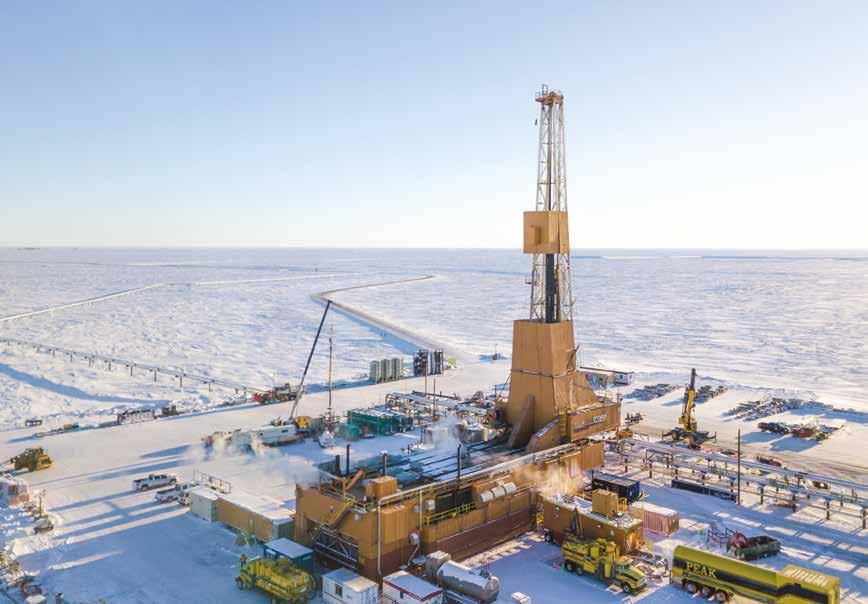
The 20MW reactor at Fort Greely was the state’s first— and, for the time being, only— nuclear energy project. From 1962 to 1972, SM-1A provided steam heat and electricity for Fort Greely. Operating costs were too high, though, so the reactor was shut down.

“The control rods, all the radioactive waste, all the radioactive liquids were sent to the Lower 48, but some of the lower-dose materials were left up there for our future efforts,” says Brenda Barber, program manager for the Environmental and Munitions Design Center at the US Army Corps of Engineers (USACE) Baltimore District.
Fifty years after SM-1A was mothballed, USACE is responsible for final cleanup. “These sites have to be fully decommissioned and dismantled within sixty years of initial shutdown. For Fort Greely, that’s 2032,” Barber explains. “Our clock is ticking.”
Engineers encased the SM-1A containment vessel and reactor components in concrete, which makes the decommissioning unusual. “We’re going to have to remove all that concrete so we can gain access to the reactor components and then remove them. So we do have some added complications at Fort Greely,” says Barber.
Last July, USACE awarded a $103 million contract for the decommissioning to Westinghouse Government Services of South Carolina. For comparison, the construction cost of SM-1A and its prototype, SM-1 at Fort Belvoir in Virginia, was approximately $20 million each, adjusting for sixty years of inflation. Who said it was easier to destroy than create?
To shrink the life-cycle cost of the next generation of nuclear power, a separate division of Westinghouse is working on a new system named eVinci. Whereas SM-1A is stationary and medium-sized (hence the designation), eVinci is mobile and smaller than small; it’s considered “micro,” a 5MW reactor that fits inside a 40-foot shipping container.
Westinghouse Vice President of New Plant Market Development Eddie Saab says eVinci is designed to be removed from a site and leave nothing behind. “We believe we will be able to accomplish that with eVinci by making
it transportable,” he says. “There’s more confidence in the back end because of the transportability.”
Instead of monumental edifices, microreactors look more like construction office trailers, and they could be just as temporary.
“Before, everybody was trying to make bigger and bigger reactors; they were trying to contain the cost by making large scale deployment,” says Cristian Rabiti, vice president of business development for USNC. “What happened was, you know, they were not able to control the cost on the building because it was always the first of a kind. So there was an upwards cost escalation, and the benefit of the economy of scale kind of disappeared.”
USNC is a Seattle-based startup that is developing its own microreactor, the Micro Modular Reactor (MMR). The core is buried underground, upright, next to another module that circulates helium coolant. The helium transfers heat to molten salt, which is pumped to a neighboring steam turbine to drive the generator. Molten salt also stores heat overnight to be released during daytime hours.
MMR and eVinci are both designed to be refueled by the manufacturer: reloaded after twenty years in the case of USNC and totally reclaimed and, if desired, replaced after at least eight years in the Westinghouse approach.
The form of the fuel, called TRISO, makes microreactors possible. Tiny spheres of uranium are coated with ceramic, and the composite grains are packed into pellets. “We think that it’s better to have the fuel safe rather than building a safety system around it,” Rabiti says. TRISO has been around since the ‘60s, but recent breakthroughs allowed for scaled-up manufacturing.
Westinghouse needed another innovation to make eVinci possible: heat pipes fabricated to very precise tolerance. “We quickly recognized that the capacity did not exist in the marketplace. To be able to solve that, we have to do it ourselves,” Saab says. The prototype uses heat pipes that are 4 feet long; earlier this year Westinghouse successfully fabricated 12-foot pipes for the next test unit. The commercial model will likely use 22-foot pipes,
assuming they are smooth enough.
Heat pipes are key to the eVinci design. “The air coming in absorbs the heat generated in the heat pipes and goes to a power conversion unit,” Saab explains. “When you pull the heat away from the heat pipes, the sodium goes back to its liquid state from gas and moves back to the other side.” A system driven by simple thermodynamics, with few moving parts, minimizes points of failure in the interest of safety.
USNC has a passive design that relies on high surface area to maximize heat dissipation, which it bills as “walk-away safe,” as bold a promise as the company’s name: Ultra Safe Nuclear Corporation. Confidence, or tempting fate?
“I always say, don't let engineers name a company,” says Mary Woollen, USNC’s director of stakeholder engagement. “And it's funny because we've had some people that love the name, but mostly it's just, sort of, there it is.”
conditions where permafrost is difficult or expensive to excavate.
On the other hand, USNC is using an underground approach. “The main reason is for a design requirement to withstand an airplane crash” or other external hazard, Rabiti says. “We have not yet built one, but from what we’ve discussed [with Alaska construction contractors], it is definitely possible to build the reactor.”

CVEA is interested in siting a pair of MMR reactors in Valdez, connected to its 3,800 customers. The co-op currently relies on the 12MW Solomon Gulch and 6.5MW Allison Creek hydroelectric facilities in summer.
“We have really low rates in the summer,” Million says. “Unfortunately, in the wintertime hydro is not really available. We can get about 20 to 30 percent of our needs with hydro in the winter, but we make up the rest with diesel.”
The CVEA board of directors approved a strategic plan in 2021 to reduce dependence on fossil fuel as backup. “My goal would be to not run it, but ultimately I will never be able to retire my diesel plants,” Million says. “With us being isolated like we are, if our transmission line to Valdez were to go down, I need to have my diesel plant up in the Copper River basin to support our members.”
Woollen and Rabiti were in Alaska earlier this year, making the rounds on wintry roads. They began visiting the state two summers ago, and they found an interested customer in Copper Valley Electric Association (CVEA). Last year, the Glennallen-based utility announced that it would explore the feasibility of deploying MMR as Alaska’s first civilian nuclear generator.
“They actually approached us,” says CVEA CEO Travis Million. “What we found with USNC that was really attractive to us is that they were truly looking to partner with somebody and work collaboratively to try to find a way to make this work.”
The Westinghouse and USNC products are both transportable 5MW modules, yet they differ in key respects. For instance, eVinci sits on a concrete pad, which suits Alaska
The feasibility study was completed last October. Million says, “We found that there are locations that'll work in our service territory where we could site a micromodular reactor. We found the integration into our system would actually work out very well, more or less. We found that social acceptability was pretty good in our service territory.”
However, the economic factors are complicated by the unknown variable of alternative energy grant funding. Furthermore, to make the finances add up, “We would have to sell excess heat in addition to generate electricity because we don't need electricity all the time. We would just need it in the winter months.”
The reactor’s excess heat could be tapped off for a major customer, such as community heat loops, fish processing, or industrial processes.
Until then, “It doesn't make sense and it's too risky for our membership to own and operate the facility,” Million says. “But if we can negotiate a power purchase agreement with USNC that benefits our membership, then we may go forward.”
Meanwhile, at the other end of the Richardson Highway, the US Air Force wants to bring nuclear power to Eielson Air Force Base. Both Eielson and CVEA are on track to have reactors operational by 2027, if at all, so the utility is watching the Air Force process. “We definitely are keeping an eye on it, just from a curiosity standpoint, just to see where they go and who they end up selecting, if they do select somebody,” says Million.
Eielson was selected in October 2021 to host a pilot project for the Air Force’s first (and so far only) microreactor, replacing the base’s coal-fired power plant. A request for proposals closed January 31, 2023, and the project is now in the source selection phase.

Among the potential sources is Westinghouse. “Our technology is
well suited for that application,” says Saab, although he has reservations about the process. “I think the Air Force is going through a first-of-a-kind procurement model; they’ve asked for a power purchase agreement, which for a first-of-a-kind technology can be challenging.” He says Westinghouse provided recommendations to adjust the process, so he hopes for good dialog with the Air Force.
Eielson, Fort Greely, Copper Valley… why is the Richardson Highway Alaska's nuclear neighborhood? Turns out to have the magic mix of off-the-grid and on-the-road.
“We definitely need a certain amount of people to be sure that we have enough demand for those reactors… That is part of the math,” says Rabiti. “And the other thing in this area, [with] the connectivity to the grid, the price of electricity is high. So essentially, it's a kind of mix of two components: the price of electricity and the presence of a large enough base of customers.”
Million also sees the region as a sweet spot. “The fact that we’re on the road system to where a unit could
be deployed and demonstrated and could be easily accessed, I think, was a big driver as well,” he says. “I think the manufacturers right now are wanting something that they can easily get access to and keep an eye on while they're deploying and testing.”
Saab concurs. “Typical first deployments are in areas that are accessible and have an immediate need,” he says. “I do anticipate, and I am hopeful that, as eVinci shows success in Alaska, it unlocks additional opportunities across Alaska, and those end-users or communities can benefit from the technology.”
The day before CVEA announced the feasibility study with USNC, Governor Mike Dunleavy requested legislation, Senate Bill 177, to facilitate the deployment of microreactors. It exempts reactors under 50MW from requiring legislative approval for siting. It also streamlines the requirements for studies, now spread across six state departments, relying instead on work done by UAF and the Alaska Center for Energy and Power.
The key to eVinci is incredibly smooth and durable iron-chromium-aluminum alloy pipes. Westinghouse achieved a milestone this year by manufacturing 12-foot heat pipes; the commercial version will be twice as long.A few months later, Dunleavy signed the bill into law at his first annual Sustainable Energy Conference, where nuclear energy was easily the most common alternative source represented at vendor tables. Westinghouse was there, drumming up interest in eVinci.
“When we look in Alaska, we see remote communities, we see industrial applications where there isn’t an easy connection to the grid to provide that power,” says Saab. Indeed, he says design started with those applications in mind, which led to the 5MW form factor.

Not many off-grid villages need a 5MW power plant, though. Of the fifty-eight communities in the Alaska Village Electric Cooperative, only Bethel uses at least that much power; the rest have generating capacity of 1MW, give or take.

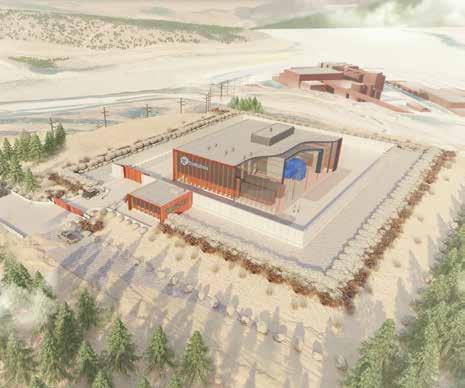
That’s fine, says Saab; eVinci can be throttled down. “The luxury of the technology is the output and the operational life are fairly linear: if there is a need for half the power, for 2.5MW, we can actually run the eVinci for about sixteen years,” he says.
For communities that already have (or hope to install) renewable energy infrastructure, a microreactor can fill the gaps. “It can load follow, so eVinci would make a great partner to a wind or solar



farm where you have some intermittent load and you need a technology to complement it,” Saab says.
But why should Alaska import uranium-fueled modules when the


eVinci microreactor would sit on a concrete pad and, when the fuel supply is exhausted after eight years, the entire site could be restored to greenfield, if desired. Westinghouse
state has more wind, hydrokinetic, and geothermal energy than it can use? Saab views microreactors as a bridge to decarbonization, which would include extraction of critical minerals. “If we want to unlock some of the natural resources in certain regions, you need a technology that can do it safely,” he says.
Partly for that reason, Westinghouse was invited to a recent luncheon at the Alaska Support Industry Alliance, a nonprofit mainly interested in oil and gas development. Alliance CEO Rebecca Logan welcomes nuclear energy to the state’s portfolio. “A huge driving interest is that we have less oil and gas work,” she says. “You’re always looking at where the next jobs are coming from and what new things are coming to Alaska.”
Nuclear energy is not welcome everywhere. Microreactor vendors are quite aware that the power source is a threshold some communities do not want to cross.
Yet pushback in Alaska has been relatively mild, according to Saab. “When we provide the facts and the science, people are open to listen,” he says, adding that skeptics are mainly waiting to see the technology tested somewhere else.
Million has seen a similar reception from CVEA members. “A lot of the people that were either on the fence or adamantly against it were either more open-minded or accepting of it. There are a few groups of people that are just adamantly against anything nuclear at all, and, you know, it's just how it's
gonna be,” he says.
“There will be no reactors anywhere unless you can gain public trust,” says Woollen. “We don't aim to try to change hearts and minds, but I do ask that, I mean, I hope that people can at least listen, try to understand, and then make their judgments.”
If USNC or Westinghouse bring microreactors to Alaska by 2027, Fort Greely’s SM-1A will still be in the demolition phase. Start to finish, the job is expected to take six years.


Meanwhile, the CVEA board is expected to decide late this summer whether to go down the reactor road. “We’re going to continue to have conversations with our membership and any stakeholders who are interested
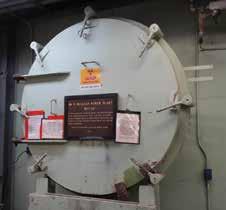 Above, the idled turbine of the SM-1A reactor at Fort Greely, and the exterior, below left. All remaining radioactive materials were sealed in the core, below right, in 1972, waiting for a demolition contract that was awarded last year.
Above, the idled turbine of the SM-1A reactor at Fort Greely, and the exterior, below left. All remaining radioactive materials were sealed in the core, below right, in 1972, waiting for a demolition contract that was awarded last year.




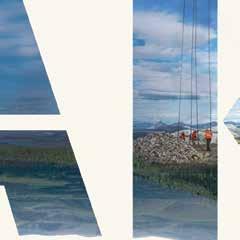




with our process, and we'll be working with USNC to see if we can develop a contract that works for them and works for our members,” says Million.
The only nuclear power plant to ever operate in Alaska is being decommissioned at the same time the new generation of microreactors is coming to the state. Is that a coincidence?
Saab doesn’t think so. “Our eVinci technology is on its own TRL [technology readiness level] pathway,
and we’re at the point now where we can proactively pursue opportunities in Alaska,” he says.
Yet Barber suggests a way USACE’s work might have contributed to commercial developments. “Likely why you’re seeing what you’re seeing in the microreactor arena is that we were able to demonstrate the lifecycle completion of a reactor,” she says. “When we decommissioned and dismantled the MH-1 on the Sturgis vessel, the Army could demonstrate
that full life cycle cost, so it did provide some input into potentially bringing reactors back online.”
Whichever vendor supplies Eielson, and whether CVEA brings nuclear energy to its Richardson Highway grid, the process is a learning opportunity for Alaska as a whole. Million says, “If it doesn't work for us, but the work that we've done on the front end helps benefit another utility to go forward with it, I look at that as a huge win.”






The cover story for this issue, “No One Likes High Gas Prices,” was inspired by this question: Who actually determines the price of gas? In an election year, the answer is obvious—whichever elected official a person doesn’t support is clearly responsible for unacceptably high gas prices. For those less interested in blame and genuinely curious about the factors behind the cost of retail gasoline, the article features insights from local gasoline retailers who explain that it’s a bit more complicated than the choices of any one individual.
Most conversations about oil and gas, refined or otherwise, require context to fully understand or find a resolution to an issue. “Gasline on Wheels,” for example, looks at how natural gas produced as a byproduct on the North Slope will finally get exported to another market. That market is the Interior, so it’s not quite as far from the Alaska Arctic as some have envisioned, but it’s still a milestone for an industry that’s been reinjecting a perfectly good commodity back into the ground for decades. Has the funding for a massive LNG export project finally come through? No. But it may just be that this step in monetizing North Slope gas will lead to fully utilizing the potential of gas in Prudhoe Bay down the road. Literally.
But oil and gas development is never rushed in Alaska, and the effects of oil and gas activities on Alaska’s economic development are equally long-lived. In “Hydrocarbons Pave the Way for Pick.Click.Give.” we look at just how oil royalties laid the foundation for a statewide charitable giving program that now provides millions of dollars to Alaska nonprofits every year.
To round out this special section, we also include an article on Pantheon's oil discovery and a look at Hilcorp's plans for 2023 in Cook Inlet. North Slope enthusiasts can check out our update on North Slope activity and, in their 2023 debut, our North Slope Operating Unit Baseball Cards. Like our nation’s talented athletes, it’s worth knowing the stats of the operations that drive much of our state’s economy.







In mid-2022 Hilcorp Alaska notified local utilities that it did not have enough natural gas reserves to commit to new contracts as current contracts expired. At the time, contracts with the oil and gas producer were up for renewal in periods ranging from two to eleven years. Many utilities are already taking action to reduce their reliance on natural gas or to secure contracts with other providers. The Fairbanks North Star Borough’s Interior Gas Utility, for example, has already announced its intent to power the Interior with North Slope natural gas.
Whatever plans Alaska’s utilities implement in the coming years to reduce their reliance on Cook Inlet natural gas, a smooth transition depends on ongoing production, which shouldn’t be a problem.
According to the “2022 Cook Inlet Gas Forecast” published in January 2023 by the Alaska Department of Natural Resources' (DNR) Division of Oil and Gas, there are “significant gas volumes potentially available through additional investment and development in currently producing fields” in Cook Inlet. It estimates 820 billion cubic feet of proved gas reserves in Cook Inlet that is “economic to develop.” The report notes there are “key uncertainties” that affect that estimate, such as costs, production rates, and the individual rate of return a company may need to invest.
The report also estimates that those gas volumes can meet the current level of demand for natural gas until approximately 2027, with this caveat: “This report is not intended to be a

prediction of how Cook Inlet gas supply and demand will play out in future years. Rather, it serves as a tool for understanding Cook Inlet’s capacity to meet natural gas demand under present conditions and assumptions.”
According to Hilcorp spokesperson Luke Miller, the company anticipates spending “hundreds of millions of dollars” in Cook Inlet over the next few years to produce additional gas, but still it urged local utilities to diversify their energy portfolios. Whether or not Hilcorp will be producing the lion’s share of Cook Inlet gas far into the future, it is still investing in its operations there and has submitted Plans of Development (POD) to DNR for 2023 laying out what some of that investment entails. [Editor’s note: As of press time in early April, the majority of the POD were submitted to, but not yet approved by, DNR.]



In its 2023 POD for the North Cook Inlet Unit (NCIU), Hilcorp indicated it had achieved several requirements of its 2022 POD, including mobilizing Rig 151 to the Tyonek Platform in May 2022 to drill several sidetrack wells, five of which were successful. The sixth was an unsuccessful sidetrack attempt of NCIU A-12, and as a result Hilcorp is planning the complete abandonment of the wellbore by the end of June, which is when the 2022 POD period ends. According to the POD, “The plugged back well will be utilized for a future sidetrack opportunity.”
Hilcorp also completed a wellwork and workover program and surface facility operations at the Tyonek Platform.
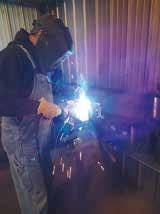

The 2023 POD, which covers July 2023 through June 2024, states, “In 2023, Hilcorp will continue to build an inventory of future development projects, including grassroots wells, sidetracks, and workovers to increase rate and reserves, specifically to focus on exploitation of potential gas resources within the Beluga and Sterling formations.”
In July it anticipates drilling up to three grassroots wells from the Tyonek Platform, potentially including NCIU A-17 and NCIU A-18, both targeting
Beluga sands. It’s also planning up to two sidetrack wells, one at NCIU B-01A and the other unspecified.
Hilcorp’s attempts to bring the North Trading Bay Unit (NTBU) back into production were frustrated by mechanical issues in 2022. Hilcorp made two attempts to drill NTBU A-10RD2 before notifying DNR in July 2022 that alternative drilling plans were underway


to redesign the sidetrack for another attempt. Hilcorp spudded A-10RD3 in mid-March, drilling operations were underway as of April, and the company anticipated drilling would be complete early this month. Hilcorp believes that NTBU production will be restored in Q3 2023. According to the POD, Hilcorp estimates A-10RD3 will cost more than $8 million. It continues, “At this time, Hilcorp anticipates that the A-10RD3 is sufficiently designed and located to efficiently drain remaining gas reserves associated with the NTBU's Tyonek
formation for the remainder of field life,” and “Hilcorp currently has no plans for further exploration or delineation in the NTBU.”
That said, work will continue in NTBU as Hilcorp executes a plugging and abandonment (P&A) program at the Spark and Spurr platforms in 2024, as they are “no longer suitable for drilling or production operations.”
Hilcorp’s Trading Bay Unit includes the McArthur River Field and the Trading Bay Field. In calendar year 2022, Hilcorp produced 1,049 thousand barrels of oil and 6,593 million standard cubic feet of gas at the McArthur River Field and 311 million barrels of oil and 431 million standard cubic feet of gas from the Monopod Platform that taps the Trading Bay Field.
The 2023 POD for the Trading Bay Unit anticipates that current oil and gas production will be maintained and/or enhanced, “particularly through the drilling of the A-10RD2 from the Monopod.”
According to the POD, “The anticipated sidetrack drilling of the A-10RD3 from the Monopod into the [NTBU], if successful, will restore production to the NTBU. Going forward, Hilcorp anticipates that gas volumes produced from NTBU via the A-10RD3 will satisfy the Monopod Platform's operational fuel demand and will thus eliminate the need to transport gas to the Monopod from the Steelhead platform. This, in turn, will result in a net increase of gas sales from the Trading Bay Unit and extend the operational life of the unit. After sustained production from the A-10RD3 is confirmed, Hilcorp anticipates submitting a formal proposal to DNR to merge the North Trading Bay Unit into the Trading Bay Unit.”
In calendar year 2022, Hilcorp produced 875,600 barrels of oil and 1.3 billion cubic feet of gas at the Granite Point Unit (GPU). In April 2022, Hilcorp added perforation in GP 2413RD2 in the C6 sands, attempting to
return the well to production. Other work conducted, according to the 2022 POD, included identifying rotary development wells targeting gas in the Tyonek formation from the Bruce platform and annual regulatory inspections on current GPU facilities.
For 2023, Hilcorp anticipates that current oil and gas production will be maintained and enhanced. Using Rig 151, it plans to drill up to three grassroots wells from the Bruce platform in Q4 2023 targeting the Tyonek formation. It will also continue to evaluate current GPU well stock for “various rig and non-rig well projects during the 2023 POD period,” which for GPU runs through June 2024.
In June of 2021, the Middle Ground Shoal Fuel Gas System, the subsea pipeline system that provides fuel gas from shore to Platforms A and C in the Middle Ground Shoal (MGS) Unit, developed a leak. DNR approved a suspension of production at platforms A and C as Hilcorp looked into options to repair or replace the system. In March 2022, at Hilcorp’s request, DNR conditionally approved an extension of the suspension of production through December 2022. In November 2022, Hilcorp provided a technical briefing to DNR on options for repair or replacement of the fuel gas pipelines. Hilcorp also introduced
concepts related to repurposing idle platforms, and DNR approved an additional suspension of production through June.
As of the 2023 POD, Hilcorp’s evaluation of the Middle Ground Shoal Fuel Gas System determined that the cost associated with its repair or replacement is not economic as a stand-alone project. In addition, the company found that Platform C has reached its economic limit and won’t be returned to production. Platform A does have potential for reactivation, but not as a stand-alone project. Hilcorp estimates that recoverable reserves associated with Platform A exceed 3 million barrels of oil equivalent, but that does not justify the cost of repairing the subsea system.
Instead, Hilcorp’s 2023 POD proposes a field study on a known gas structure north of the Baker platform, which is located within the current MGS Unit area but may potentially extend farther north to currently nonutilized state leases. The study will identify potential drilling targets and evaluate whether the Baker Platform is suitable for drilling the area or if a new platform would be required. If a new offshore platform is constructed, it would require installation of a new pipeline to shore, which may create a contingency to potentially reactivate Platform A.
Other 2023 POD work includes P&A on wells at the Dillon Platform. Once wells on the platform have been plugged and abandoned, Hilcorp plans to contract the MSG Unit boundary to exclude the leases associated with the platform.
As Platform A awaits the results of the field study, Hilcorp plans to utilize it as an unmanned lighthouse facility, maintaining current wells and production facilities in case the platform may be reactivated in the future. Platform C will also be managed as an unmanned lighthouse facility, and P&A work for wells there will be integrated into Hilcorp’s multiyear P&A program.
In 2022 Hilcorp maintained production from the Lewis River Gas
According to the “2022 Cook Inlet Gas Forecast,” 20 billion cubic feet of proved gas reserves in Cook Inlet are “economic to develop.”
Pool #2 as planned in its 2022 POD, producing 259 million standard cubic feet. Hilcorp’s 2023 POD does not include any exploration or delineation activities, but it does include drilling one well, LRU C-01, spudding in June and targeting Sterling, Beluga, and/or Tyonek Sands.
At its Beluga River Unit, in accordance with its 2022 POD, last year Hilcorp drilled three grassroots wells and one sidetrack, using Rig 147 to target Sterling and Beluga gas sands. In its 2023 POD, with the same goal, Hilcorp anticipates drilling up to five wells: BRU 223-34, BRU 241-23, BRU 213-26, BRU 214-27, and BRU 211-35.
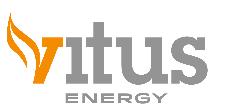
In an amendment to its 2023 POD for Beluga River Unit, Hilcorp requested authorization to drill two grass roots units on K Pad. That project would include the installation of associated tie-in infrastructure including gas flowing, electrical instrumentation, well cellars, and conductors. DNR approved the amendment, with the condition that a certified as-built survey of the project be provided to DNR within one year of placement.
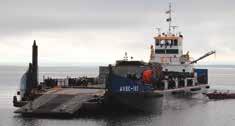
In February, Hilcorp submitted an amendment to its eighteenth POD for the Ninilchik Unit, which is effective through July 31. In the amendment, Hilcorp explains that a recent gas discovery in the Pearl Structure within the unit supports three additional wells to be completed in Q2 2023. The Paxton 12, Pearl 10, and Pearl 11 grassroots wells are being drilled from the Paxton and Pearl Pads, respectively, and will target the Beluga and Tyonek Gas sands located within the Ninilchik Unit.

The drilling requires expansion of the Pearl Pad, located 4 miles northwest of Ninilchik on privately-owned surface lands; the pad expansion will have a footprint of 1.62 acres.

DNR approved the amendment in March.
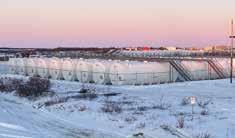
The following update of oil and gas activity on the North Slope is in no way comprehensive— that’s a tall order for any single article. Instead, we have chosen a few projects and drilling programs that highlight recently completed work from 2022 and anticipated work in 2023.
The biggest news on the North Slope for 2023 is that Willow got the green light from the US Department of the Interior (DOI). Following the DOI’s approval, an environmental group immediately sued to halt the project, challenging the Biden Administration’s decision. While the lawsuit is ongoing, a judge denied the group’s requested injunction to halt work. As of April, the Willow project has broken ground on construction of a gravel road. According to ConocoPhillips, its next steps are continuing a review of the DOI’s Record of Decision (ROD) and advancing an internal approval process, moving steadily toward a Final Investment Decision.
According to ConocoPhillips chairman and CEO Ryan Lance, “This was the right decision for Alaska and our Nation. Willow fits within the Biden Administration’s priorities on environmental and social justice, facilitating the energy transition and enhancing our energy security, all while creating good union jobs and providing benefits to Alaska Native communities.”
The DOI selected Alternative E from the Willow Project EIS, which reduces the project’s footprint from five potential drill sites to three: BT1, BT2, and BT3. In its ROD, DOI further
specified that it “disapproved, rather than defers, drill site BT5 and associated infrastructure.” The three sites may have a combined total of up to 199 wells. The “Approved Willow Project Description” sidebar gives a detailed account of ConocoPhillips Alaska’s authorized plans for Willow.
In February, ConocoPhillips Alaska submitted its twenty-fifth Plan of Development (POD) for its Colville River Unit. According to the POD, ConocoPhillips Alaska completed all approved development plans included in its twenty-fourth POD, including the CD4-597 opportunity well, the expansion of CD4, construction and start-up of the Alpine Power Expansion, and the CD133A disposal well, which replaces the now plugged and abandoned WD03. The company also completed an additional opportunity within the Fiord West Kuparuk participating area, spudding the CD2-361 producer in Q4 2022.
Much of the company’s plans for July 2023 through July 2024 are confidential, but ConocoPhillips Alaska did share that, at the Alpine Pool, drilling will continue for CD2-361 into Q2 of 2023. The company states: “With continued success on both the drilling and reservoir fronts, it is expected that a third well, the CD2-320 injector, will be spud within 2023.”
The POD also gave a summary of the now-completed Alpine Power
Expansion, whose purpose was to meet future power demand. The scope of the project included installing a 16.5MW gas turbine generator, upgrading existing switchgear from 2000A to 3000A, and debottlenecking the fuel gas system to increase flowrate.

ConocoPhillips Alaska’s Colville River Unit produced approximately 657 million barrels of oil in 2022.

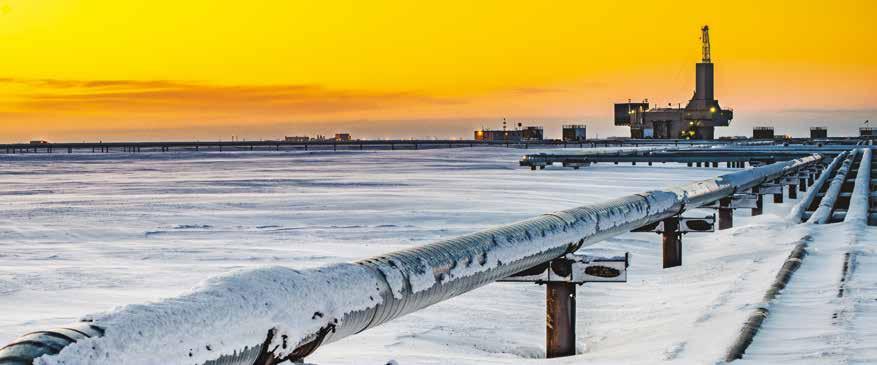
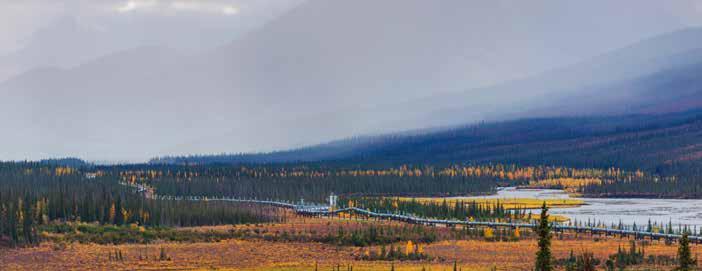
According to a March amendment to its 2023 POD, Santos has completed front end engineering and design and made a final investment decision in August 2022 to move forward with the Pikka project. It has updated its POD to include drilling forty-three horizontal wells at ND-B, split into twentytwo production wells and twentyone injector wells for enhanced oil recovery. Also at ND-B, Santos will drill a disposal well to accommodate a grind and inject facility.
In addition to the drilling, Santos will install an infield pipeline the connects ND-B to the Nanushuk Processing Facility. It also plans to construct an 80-foot telecommunications tower at ND-B. The project’s schedule called for constructing ice roads and pads for gravel and pipeline construction between January and this month; constructing a boat launch road and pad and a portion of the ND-A infield road from January through this month; drilling at ND-B this month; and pipeline construction starting in November, with operations starting in October to produce first oil in 2026.





Hilcorp Operates Prudhoe Bay on behalf of itself and the other working interest owners: ConocoPhillips Alaska, ExxonMobil Alaska, and Chevron. It’s a massive development, and Hilcorp submits POD by area, including the Greater Point McIntyre Area (GPMA), Western Satellites, and Initial Participating Areas (IPA).
The GPMA comprises the combined Niakuk, Lisburne, North Prudhoe Bay, Point McIntyre, Raven, and West Beach participating areas, and its 2022 POD is in effect through September of this year. From April 2021 through March 2022, GPMA produced approximately 146 billion cubic feet of gas and 9.6 million barrels of oil, with an average daily production of 29,797 barrels of oil per day. Hilcorp’s plans for GPMA for the end of 2022 and into 2023 included drilling up to four new wells, potentially including two coil tubing drilling sidetracks within the Lisburne and Point McIntyre participating areas, as well as a rotary well planned for the Raven participating area.
The Western Satellites comprise the Aurora, Borealis, Midnight Sun, Orion, and Polaris participating areas, which between January 2021 and December 2021 produced approximately 27.9 billion cubic feet of gas and nearly 10 million barrels of oil with an average production rage of 27,314 barrels of oil per day. According to its POD, “Hilcorp North Slope, upon taking over operatorship of the Western Satellites, has focused on returning idle wells to service, optimizing production through the existing surface infrastructure, targeting reservoirs that had been under-developed, improving voidage replacement, maximizing MI utility, improving operational efficiency, and a strong drilling program.” Together these initiatives led to a 24 percent year-onyear increase in overall oil production from 2020 to 2021.
For the Western Satellites in 2023, Hilcorp anticipates completing up to twenty-six producer and injector drill wells, as well as four workovers or recompletes. Also in 2023 Hilcorp is continuing a three-well polymer pilot program at the Polaris participating area,
which will “determine polymer’s impact on injectivity, [miscible injectant] utility, oil rate, and reserves.” Polymer injection may be used at Orion and Polar, if the pilot program data indicates it could be economic to do so.
At the IPA, which comprises the Gas Cap and Oil Rim participating areas, in 2023 Hilcorp anticipates an increase in drilling activity, completing up to thirtyeight wells; it planned eleven in 2022.

During calendar year 2022, IPA produced approximately 2,836 billion cubic feet of gas and 57 million barrels of oil per day, with an average daily production rate of 156,487 barrels of oil.
Hilcorp also saw success increasing output at IPA in 2022, producing an additional 157 million standard cubic feet of gas per day and increasing production by 35,000 barrels of water per day compared to 2021. According to Hilcorp, “These efforts allowed the IPA to remain on the improved production trend established in late 2020 and continued into 2021.”
In contrast to increased drilling, according to the 2023 POD, Hilcorp has
worked through its backlog of broken wells at IPA and anticipates a reduction in that activity this year, though “workovers will be completed on an asneeded basis as integrity issues in the well stock are identified.” Also this year at IPA, Hilcorp plans to work on pipeline construction for Drill Site 18 and H-Pad.
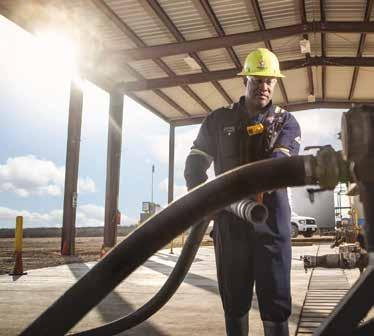
In February the Alaska Division of Oil and Gas approved Hilcorp’s proposed plan for the Raven Pad Development Project at Milne Point.
The Raven Pad, or R-Pad, will be a new drilling and production pad that will require the placement of 262,200 cubic yards of gravel fill over 30 acres of wetlands, as well as widening an access road to accommodate a drill rig. Hilcorp anticipates spudding sixty wells that will provide access to 5,200 acres within the Kuparuk and Schrader Bluff reservoirs. Other facilities for the project will include a test separator building, a pig launcher building, an electric submersible pump drive
building, jet pump infrastructure, gas compression module/skid, and primary fluid separation module. Pipelines from the pad will tie into an existing flowline that runs between Pads F and L.
Gravel placement was scheduled for the first two quarters of 2023, with gravel turning and compaction, culvert placement, and power and fiber installation anticipated to begin in June and finish by October. Work will continue at the end of the year, with flowline construction planned for December and running into June 2024. Other infrastructure construction is planned for March 2024, with drilling expected to commence in August 2025 and run to November 2025.
This year Accumulate Energy, which is 88 Energy’s operator, commenced drilling on Hickory 1 using Nordic Calista’s Rig-2 in March. Hickory 1 is an exploration well that will appraise up to six conventional reservoir targets. It’s located 400 feet west of the Dalton
Highway and approximately a quarter mile south of MP 382. The project’s schedule as submitted by Accumulate Energy in December 2022 called for construction of a main ice pad and road in January, followed by rig mobilization and camp and support ops in the same month. Drilling began March 9, and demobilization of the drill rig, camp, and support operations was slated for April. Accumulate Energy plans to remediate the ice pad and ice road in July and August.
Assuming the well results are promising, Accumulate Energy anticipates flow testing of Hickory 1 in the 2023/2024 winter season.
In December 2022, Narwhal applied to the Division of Oil and Gas to expand the West Harrison Bay Unit to include leases owned by the company. Narwhal wants to add a total of ten leases—six acquired in 2016 and four acquired in 2019—to the existing eighteen leases
The Department of the Interior, Bureau of Land Management provided this description of the Willow Project in its Record of Decision, issued March 23, 2023:
The Project as approved in this Decision—Alternative E as described in the Final Supplemental EIS, as modified to include only drill sites BT1, BT2, and BT3 and associated infrastructure—will include the Willow Processing Facility (WPF), Willow Operations Center (WOC), airstrip, and three drill sites (BT1, BT2, and BT3). Gravel roads will connect to all Project infrastructure and will extend from the Greater Mooses Tooth 2 (GMT-2) development southwest toward the Project area. As approved in this Decision, the Project will include up to 199 total wells, four valve pads, three pipeline pads, five water source access pads, pipelines to support Project infrastructure, and up to three subsistenceuse boat ramps. BT2 will be located north of Fish Creek to gain access to a portion of the target reservoir. The subsistence-use boat ramps were added to the Project by ConocoPhillips Alaska as mitigation to help offset Project effects on the community of Nuiqsut.
The access road alignment will provide direct gravel-road access from the existing gravel road network in the Greater Mooses Tooth (GMT) Unit and Alpine developments to the Project facilities. The full, all-season gravel road connection to Alpine will allow for additional operational safety and risk reduction by providing redundancies and additional contingencies for each development.
Ice roads will be used during Project construction to support gravel placement and pipeline construction, to access the gravel mine site, and to transport sealift modules from Oliktok Dock to the Project area. Separate ice roads will be used for pipeline construction, gravel placement, and general traffic to address safety considerations. A partially grounded ice bridge across the Colville River near Ocean Point will be used to transport sealift modules to the Willow area. The ice road will originate at the end of the existing Kuparuk road system at Kuparuk drill site 2P (DS2P).
Infield (multiphase) pipelines will connect individual drill sites to the WPF, and export/import pipelines will connect the WPF eastward to existing infrastructure on the North Slope. Diesel fuel will be piped from Kuparuk CPF2 to the Alpine Central Processing Facility and then trucked to the Project area.
The Project will include at least two Class I underground injection control disposal wells, both located at the WOC. The Project will use an existing mud plant located on the K-Pad, near Alpine CD5, to produce drilling mud, which eliminates the need to construct a new mud plant at the WOC. The existing K-Pad mud plant will be expanded on the existing gravel pad to support this use. The Project will also include installation of two additional modules on the existing GMT-2 drill site pad to allow for the possibility of transporting GMT-2 produced fluids westward to the WPF in case of future need.
Electrical power for the Project will be generated by a 98MW power plant at the WPF, equipped with natural gas-fired turbines. Power will be delivered to each drill site and the WOC via power cables suspended from pipeline horizontal support members.
Gravel will be primarily obtained from a new gravel mine site in the Tiŋmiaqsiuġvik area, approximately 4 to 5 miles southeast of GMT-1. The gravel mine site will be accessed seasonally via ice road; no permanent gravel road to the mine site will be constructed. There will be no activity at the mine site outside of the winter construction season. Small amounts of gravel will also be obtained from existing mine sites C and E in Kuparuk, to widen sections of existing Kuparuk roads that will be used for module transport.
Sealift module delivery will use the existing Oliktok Dock to receive the sealift barges. The modules will be transported over existing Kuparuk gravel roads using self-propelled module transporters from Oliktok Dock to Kuparuk DS2P. From Kuparuk DS2P, the modules will then be moved by heavy-haul ice roads to GMT-2, crossing the Colville River on a partially grounded ice bridge near Ocean Point. From GMT-2, the modules will be transported to the Project area over Project gravel roads to reach the WPF and drill site gravel pads.
that currently make up the West Harrison Bay Unit. According to Narwhal, “The subsurface resources extend across the current unit boundaries into the Narwhal leases. Expansion of the unit will expedite exploration and drilling activity, benefitting all parties.”
Narwhal states in its application that it has already invested more than $4.6 million on the leases, including the cost of the leases themselves as well as purchasing and reprocessing seismic data, ongoing technical studies, stakeholder outreach, and permitting programs.



Narwhal plans to drill up to four exploration wells in Q1 2024 in the expanded unit, if approved. Preliminary field activities—marine shallow hazard surveys, freshwater source lake surveys, an archeological survey, and gathering technical data—would take place this summer to support project permitting, planning, and engineering for the proposed 2024 winter program.
Expanding the unit “expedites exploration” in part because it would allow Narwhal to operate independently of Shell, which technically operates the West Harrison Bay Unit. According to its application, Narwhal says it has gone to “great lengths to try to reach an agreement with Shell to explore and develop the combined acreage that would be unitized pursuant to this proposal, but Shell’s unwillingness to engage in discussions with Narwhal makes it clear that action from DNR— specifically, involuntary unitization—is required to spur exploration drilling and development activities that are in the public interest.”
Those great lengths include six formal proposals from Narwhal to jointly explore oil and gas formations in West Harrison Bay common to the two companies or to buy Shell’s leases in the unit outright. “All of these proposals were summarily dismissed by Shell without comment or counteroffer,” Narwhal reports. “It is clear that involuntary unitization will be the necessary catalyst for exploration, development, and ultimately production activities on the combined acreage.”
As of press time, the Division of Oil & Gas had issued an extension on the public comment deadline to April 6 and a decision on the expansion had not been issued.
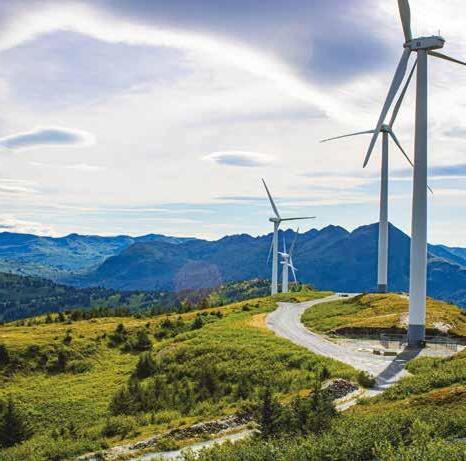



Can’t tell the players without a program. Alaska’s oil patch has so many names, even Bud Abbott couldn’t keep them straight. For instance, Duck Island is a unit, Endicott is a field—and they’re the same place! Add in the retirees, like the Sag Delta field that quit producing in 1985, and the minor leaguers waiting to be called up, like Pikka and Liberty, and the bench of exploration prospects with quirky monikers like Quokka, Alkaid, and Talitha, and… well, confusion is understandable.
Alaskans ought to have basic knowledge of the state’s biggest tax-paying industry, so to keep the lineup manageable, this primer focuses on producing fields on the North Slope. That’s less than a dozen, or as many as a baseball team (counting the designated hitter and manager). Two other active fields—Walakpa and Barrow, southwest and southeast of Utqiaġvik, respectively—produce natural gas for the North Slope Borough. But these eleven contribute to the flow of the Trans Alaska Pipeline System.

Next season, the Cook Inlet league!

Landowner: State | Federal | Native
Operator: ConocoPhillips Alaska
Discovered: 1994
First Production: 2000
Total Output: 636 million BOE
Oil Wells: 144
Average Output: 25,000 BOE/day
Ownership Interest: 100% ConocoPhillips Alaska
Also called Colville Delta or simply Alpine after the unit’s flagship Alpine field, a centralized production facility enables extended development into the National Petroleum Reserve - Alaska. Includes satellite fields Fiord West Kuparuk and Nanuq. Drilling pad CD2 tapped the Qannik pool in 2008. The CD5 pad began producing in 2015 from Native leases. The Doyon 26 rig set a record in 2022 for longest horizontal well drilled on land, 35,526 feet, at the Fiord West Kuparuk satellite field.
Landowner: State
Operator: Savant Alaska
Discovered: 1990
First Production: 1998
Total Output: 10.2 million BOE
Oil Wells: 21
Average Output: 1,100 BOE/day
Ownership Interest: 100% Savant Alaska
Connected by a 25-mile pipeline to Prudhoe Bay, but no permanent road. Colorado-based Savant redeveloped the field in 2008 for BP Exploration Alaska, ending a five-year production hiatus, and took over the unit in 2011. Savant is now a subsidiary of Glacier Oil and Gas, which was acquired in January by a Texas-based venture formed by Pontem Energy and Sweat Equity Partners. The unit contains an estimated 120 million barrels of oil equivalent (BOE) in recoverable reserves.
Landowner: State
Operator: ENI Petroleum US
Discovered: 2004
First Production: 2011
Total Output: 74.7 million BOE
Oil Wells: 63
Average Output: 17,200 BOE/day
Ownership Interest: 100% ENI Petroleum
Cold, viscous crude makes this a marginally economic field. Taps the Sag River formation, with an estimated 180 million BOE of recoverable reserves. Includes the Oliktok Production Pad, located at the northernmost drivable point in North America (not normally open to the public, naturally) as well as a cluster of wells from an offshore pad near a barrier island, connected by a 3.8-mile undersea pipeline bundle coated in concrete.
Landowner: State
Operator: Hilcorp Alaska
Discovered: 1978
First Production: 1986
Total Output: 498 million BOE
Oil Wells: 69
Average Output: 6,100 BOE/day
Ownership Interest: 74.24% Hilcorp Alaska
25.76% Chevron USA
Contains the Endicott field, the first offshore Arctic field to enter production. BP built an artificial island connected to the Prudhoe Bay Unit by a 2.5-mile causeway through waters about 15 feet deep.
Landowner: State
Operator: ConocoPhillips Alaska
Discovered: 1969
First Production: 1981
Total Output: 2.5 billion+ BOE
Oil Wells: 500+
Average Output: 74,000 BOE/day
Ownership Interest: ~92% ConocoPhillips Alaska ~5% Chevron USA | ~3% ExxonMobil Alaska
Next to Prudhoe Bay (literally due west), Kuparuk is North America’s second largest oil field. Other fields within the unit include the Tarn, West Sak, Meltwater, and Tabasco satellites, each sending oil to Kuparuk’s central production facilities.
Landowner: State
Operator: ENI Petroleum US
Discovered: 2003
First Production: 2008
Total Output: 47 million BOE
Oil Wells: 26
Average Output: 6,300 BOE/day
Ownership Interest: 100% ENI Petroleum
Located in shallow waters between the Colville River delta and a small barrier island. A 6-acre gravel pad is connected to shore by a 5.7-mile pipeline bundle. Pioneer Natural Resources initiated production, and ENI had 30 percent ownership until taking full control in 2019, pairing with the Italian company’s nearby Nikaitchuq unit. Oooguruk contains an estimated 90 million BOE of recoverable reserves.
Landowner: State
Operator: ExxonMobil Alaska
Discovered: 1975
First Production: 2016
Total Output: 15 million BOE
Oil Wells: 1
Average Output: 8,400 BOE/day
Ownership Interest: ~62% ExxonMobil Alaska ~37% Hilcorp Alaska | ~1% Other
Contains about one-quarter of known North Slope gas reserves. A 22-mile pipeline transports natural gas condensate to the Badami pipeline, with total production of 276 million cubic feet, vastly more than fields of comparable age like Nikaitchuq or Greater Mooses Tooth. The unit contains an estimated 200 million BOE of recoverable reserves.
Landowner: State
Operator: Hilcorp Alaska
Discovered: 1969
First Production: 1985
Total Output: 399 million BOE
Oil Wells: 246
Average Output: 39,500 BOE/day
Ownership Interest: 100% Hilcorp Alaska
The third North Slope field was developed by Conoco in the mid-‘80s, and BP took over as operator in 1994. A pipeline sends oil from a central pad south to the pipe that connects the Kuparuk River unit to Pump Station 1 at Prudhoe Bay. Hilcorp bought a 50 percent interest in 2014 before acquiring BP’s half in 2018.
Landowner: State | Federal
Operator: Hilcorp Alaska
Discovered: 1984
First Production: 2001
Total Output: 181 million BOE
Oil Wells: 22
Average Output: 3,700 BOE/day
Ownership Interest: 100% Hilcorp Alaska
Royal Dutch Shell found the oil pool northwest of Prudhoe Bay, near the boundary of state and federal waters 5 miles offshore. The pool couldn’t be developed until BP built an artificial island in 1999, connected by a subsea pipeline to shore.
Landowner: Federal
Operator: ConocoPhillips Alaska
Discovered: 2012
First Production: 2018
Total Output: 13 million BOE
Oil Wells: 12
Average Output: 15,400 BOE/day
Ownership Interest: 100% ConocoPhillips Alaska
A satellite of the Alpine field, fully within the National Petroleum Reserve-Alaska. The GMT1 project produced the first oil ever from the reserve, followed in 2021 by even more from GMT2. The Willow field, discovered in 2017, is being spun off as part of the neighboring Bear Tooth unit. Originally a partnership with Anadarko Petroleum, the unit was formed in 2008, and ConocoPhillips followed up on a discovery ARCO made there in the late ‘80s.
Landowner: State
Operator: Hilcorp North Slope
Discovered: 1967
First Production: 1970
Total Output: 13.2 billion BOE
Oil Wells: 800+
Average Output: 230,000 BOE/day
Ownership Interest: 36.4% ExxonMobil Alaska
36.1% ConocoPhillips Alaska
26.3% Hilcorp North Slope | 1.2% Chevron USA
The Babe Ruth of North American oil fields. Fifty well pads and seven major production facilities are connected by 1,300 miles of pipeline, all pouring into Pump Station 1 at the head of the Trans Alaska Pipeline System. The newest field within the unit began production in 2001. The current rate of production would take another twenty years to drain the unit’s 15 billion BOE estimated recoverable reserves.


The first pipeline to take natural gas off the North Slope has wheels. After decades of hopes and dreams, plans and schemes, the route to marketing the state’s stranded gas wealth runs not through Canada, Valdez, or even Nikiski but through Fairbanks. And it’s coming on trucks.
Interior Gas Utility (IGU), a natural gas distributor owned by the Fairbanks North Star Borough, is breaking the North Slope gas deadlock thanks to a confluence of constrained supply amid growing demand.
“Interior Gas Utility is in a rather steep growth trajectory,” explains Elena Sudduth, IGU’s Director of Public Relations and Customer Service/Marketing Manager. “In the last couple of years, we have pretty much doubled the number of customers that we have. We currently have about 2,200 customers, and we plan to continue adding customers at a rate of 600 customers per year for the foreseeable future.”
In 2022, IGU installed 635 service connections to new customers. However, one new customer on the horizon could ramp up demand considerably. As a result of the publication of the final draft Environmental Impact Statement for revamping the US Army’s oldest power plant—Fort Wainwright—it now appears very likely that IGU’s production demand will more than double within the next few years.
All of this is a business dream come true, right? Well, it would be—assuming an available supply of liquified natural gas (LNG).
Currently, IGU trucks its gas from the Matanuska-Susitna Borough, drawing from the same resource that powers much of Southcentral Alaska. In April of last year, however, Hilcorp notified its customers that, due to dwindling reserves, it might not be able to renew contracts for drilling in Cook Inlet after 2032. As IGU General Manager Dan Britton explains, “They indicated that they did not have a line of sight beyond their current contractual commitments that they have to us, ENSTAR [Natural Gas Co.], Chugach Electric [Association], Matanuska Electric [Association], and others, how they would meet the total demands that they are
today, in the future.” Given that Hilcorp supplies upwards of 80 percent of natural gas to the region, this was a cause for immediate concern, even though contracts won’t expire for years to come.
“Because we needed that additional liquefaction capacity, we needed to make a decision now,” Sudduth explains. “So we started looking at our options.”
At a board meeting in January, Britton gave a lengthy presentation of the different options available, including either expanding Titan, which is IGU’s existing liquefaction facility in Point MacKenzie, or adding a modular, temporary liquefaction facility there, called Titan II, at an estimated cost of $60 million. These expansions had first been considered in 2019 but became less likely after Hilcorp’s announcement because they would do nothing to solve the Cook Inlet gas slowdown.

“We’ve evaluated barging out of the Vancouver area into a port in Alaska, and then either trucking or railing the LNG from there,” Britton explains, but these options would have increased costs to IGU customers and increased the company’s exposure to potential future cost volatility.
Instead, Britton encouraged the board to look for gas from a new direction: north.
For decades, natural gas, a byproduct of oil production, has been stranded on the North Slope, as it has not been economically feasible to transport it to other markets. The high cost of building and operating a liquefaction plant, combined with the limited size of the Alaska market and an uncertain regulatory environment for exports, also made it uneconomical to build a plant in Prudhoe Bay. The supply pinch in Cook Inlet and IGU’s interest in trucking gas south changes the math.
Demand for natural gas in the Interior has grown in large part due to efforts to improve air quality. Especially during winter, Fairbanks can be one of the most polluted cities in the nation due to a trifecta of causes: high levels of particulate matter from wood-burning stoves gathers into the air, then that air is trapped close to the ground due to cold temperatures, www.akbizmag.com

and the mountains surrounding the valley prevent wind from carrying the pollution away. This phenomenon has had a direct impact on many businesses’ bottom lines through negative impacts on productivity, employees’ health, and the ability to retain top talent in the area.
For these reasons, the US Environmental Protection Agency (EPA) has been working to improve air quality in Fairbanks by steering homeowners and businesses toward the use of natural gas through a variety of programs. Incentives and rebates are provided to switch to cleaner-burning heating sources, and the EPA has also taken enforcement actions against companies and industries that violate emissions standards or fail to comply with EPA regulations.
Air quality is also a key factor motivating the replacement of Fort Wainwright’s coal-fired power plant with a new gas-fired plant. The existing power plant at Fort Wainwright is more than fifty years old and is one of the largest sources of air pollution in the area.
The upgraded plant will be able to generate the same amount of energy using less fuel while producing fewer emissions and having a smaller impact on air quality.
“If Interior Gas Utility is to sell natural gas to the Army, as it is described in the final Environmental Impact Statement [released in February], we will double the amount of natural gas that we sell. This fiscal year, we have sold about 1.1 billion cubic feet [bcf], and the contract with Fort Wainwright would be about 1.5 bcf,” says Sudduth. “So that’s a considerable amount of liquified natural gas that we would be able to bring to the community and sell to the Department of Defense.”
To fill this demand, IGU must increase capacity to 150,000 gallons of liquified natural gas per day—tripling its current rate of 50,000 gallons daily.
“We have signed two twentyyear contracts—each with two fiveyear renewal clauses—so they could be up to thirty-year contracts,” Sudduth explains. “Harvest Alaska is going to construct and operate a 150,000-gallon liquefaction plant in Deadhorse. Hilcorp is going to sell us the gas, then give it to Harvest
to liquify, and then we are going to transport it south to Fairbanks and North Pole.”
This is a significant milestone for the Alaska LNG industry, and it is expected to pave the way for further investment in natural gas liquefaction facilities in Prudhoe Bay and other parts of Alaska.
The decision to build the liquefaction facility was not without its challenges. IGU had to secure financing for the project, which was ultimately provided by the Alaska Industrial Development and Export Authority. The company also had to navigate complex regulatory requirements and environmental permitting processes.
Despite these challenges, the construction of the facility is now underway and is expected to be ready for operation in 2025. Once operational, the facility will have the capacity to produce up to 5 million gallons of LNG per day, enough to meet the natural gas needs of the Fairbanks area for many years to come.
From a business perspective, the best part of the option to move liquefaction
capacity to the North Slope from Cook Inlet is that costs will not significantly increase and customers will be able to budget for known expenses over the long term.
According to Sudduth, “There are three portions of cost to IGU that are blended into the overall cost. First is the cost of natural gas itself. The gas feed on the North Slope is significantly less expensive than it is in the Cook Inlet, for a comparison basis.” That savings offsets the higher cost for Harvest Alaska to liquify the gas and the more expensive transport over a greater distance. “But all in all, the cost to our customers is going to get modest increases, if any. So, it’s a very, very comparable cost,” Sudduth says.
Not only will IGU customers gain predictable pricing with these twentyyear contracts, but the stability lends itself to new opportunities for other businesses, as well. Along with increased demand for LNG supply comes increased demand for trucking to move that gas down the Dalton Highway, from Prudhoe to Fairbanks. Sudduth says, “Right now, from Cook Inlet, we bring about five trucks a day. Just for our regular customers [excluding the potential of servicing Fort Wainwright], we are going to have about six trucks going each direction at the beginning. By 2032, that will be twelve each way.”
As a result, the company is looking for competitive bids for trucking services for the North Slope, anticipating fifteen new LNG trailers. “The great part about it is, because this is such a long-term project, a company could amortize an entire fleet in the five years that the contracts are going to be set for, so it gives predictability of the amount of business that a trucking company can have,” Sudduth says.
If and when a full-scale pipeline is built to carry natural gas off the North Slope, or if efforts to ship the gas out via the Arctic Ocean are successful, those projects would exist alongside IGU’s trucking operation. There is plenty of gas to sustain any or all of those routes. But in the race to bring the gas to markets off the Slope, the Fairbanks utility is leaning ahead to break the tape.
“Harvest Alaska is going to construct and operate a 150,000-gallon liquefaction plant in Deadhorse. Hilcorp is going to sell us the gas, then give it to Harvest to liquify, and then we are going to transport it south to Fairbanks and North Pole.”
Elena Sudduth Director of Public Relations and Customer Service/Marketing Manager, Interior Gas Utility
Securing approval for the Willow project took tremendous effort from so many people who are committed to the prosperity of Alaska.
» Senators Murkowski and Sullivan and Representative Peltola
» Governor Dunleavy
» Alaska State Legislature
» Alaska Native communities
» Organized labor groups
» Our contractor community
» Our employees
ConocoPhillips Alaska appreciates their advocacy and collaboration.
alaska.conocophillips.com
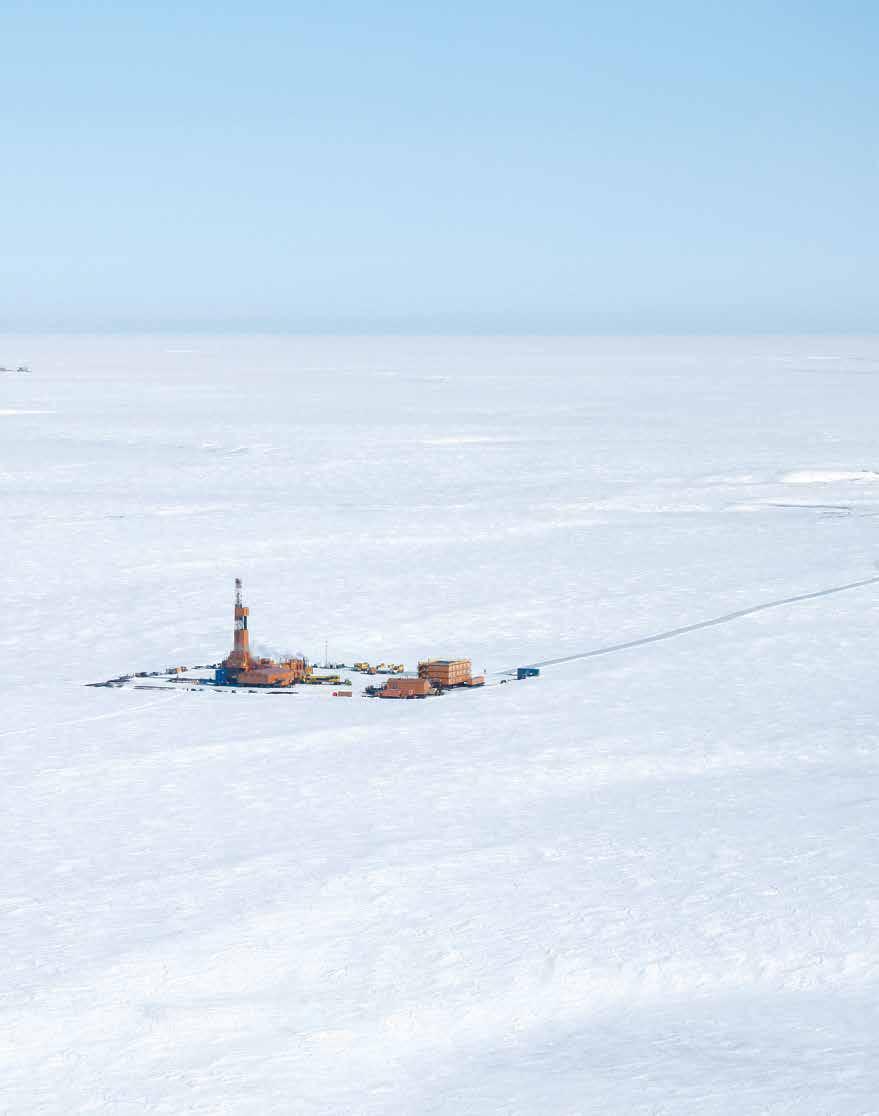
Ursa Major’s third-brightest star, at the tip of the Great Bear’s tail (or Big Dipper’s handle), is named Alkaid. The constellation contains two dimmer stars named Talitha Borealis and Talitha Australis that form the bear’s front paw. Alkaid and Talitha are also the names of two North Slope units held by Great Bear Pantheon, an oil exploration subsidiary of Pantheon Resources. While Pantheon Resources may be minor compared to some of the Slope’s larger players, its current drilling program is yielding some major numbers. In its most recent shareholder webinar held in March 2023, the company announced that oilfield services company SLB (previously Schlumberger) estimates that there are roughly 17.8 billion barrels of oil in place across the company’s reservoirs, including the recently drilled Theta West project area. Shortly ahead of the webinar, Pantheon also shared a Wood MacKenzie report that
described the company’s Theta West-1 well as the “fourth-biggest discovery well globally in 2022.” Though the area needs additional drilling and testing before potentially being considered commercial, this discovery put a positive spin on what has been a tumultuous year, which also included testing at the Talitha-A discovery well and a long-term production test at the Alkaid-2 well.
The Alkaid project’s location, right along the Dalton Highway and Trans Alaska Pipeline System (TAPS), allowed the well to be drilled from a gravel pad last summer, followed by the long-term production test this winter.
“Probably our biggest challenge this past year has been managing people’s expectations about what we’re seeing and doing at our Alkaid-2 well,” says Technical Director Bob Rosenthal of Pantheon’s dip in share prices because of what the company calls miscommunication and misconceptions. “But
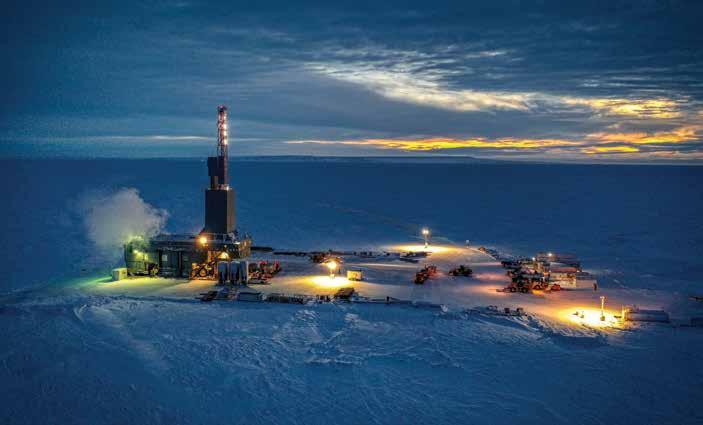
we’ve seen a lot of fluids and a lot of volume at Alkaid-2, and we’re extremely encouraged about the future.”


Pantheon Resources is an independent oil and gas exploration and production company incorporated in the United Kingdom. Following a 2019 merger with Great Bear Petroleum, Pantheon now holds a 100 percent working interest in a portfolio of high-impact oil projects focused on the Alaska North Slope, spanning more than 150,000 acres.


Through Alaska operating company Great Bear Pantheon, Pantheon has been on the North Slope in some form since 2010. The company originally drilled Alkaid-1 in 2015 but had to cut its winter season short when the Sagavanirktok River flooded the Dalton Highway. In 2019, the company resumed work.
“We perforated a 6-foot interval along with a small fracture stimulation that produced more than 100 barrels a day during flow testing,” says Rosenthal. “We were very happy with that result at that time.”
The company proceeded with an active exploration and appraisal program during the winters of 2021 and 2022, drilling and testing the Talitha-A and the Theta West-1 wells, which resulted in the discovery of an estimated 20 billion barrels of oil in multiple reservoirs and multiple pools, with more than 2 billion barrels of contingent resource, including a risk adjusted contingent resource of 76.5 million barrels at Alkaid, where the current long-term test well Alkaid-2 is located.
“To make these reservoirs effective, you need to do long laterals and stimulate the rock, and that’s what we did,” says Rosenthal of last summer’s work at Alkaid-2, which included drilling a 5,000-foot lateral with thirty fracture stages. “When we tested the well in early November, we were producing 325 barrels a day of condensate and natural gas liquids [NGLs] and 180 barrels of really high-quality oil. We produced IP30 [average oil production over the initial 30 days] calculated at 500 barrels of hydrocarbon fluids [oil,
Jay Cheatham, CEO, Pantheon Resources
condensate, and NGLs] out of the Alkaid-2 well.”
Rosenthal considers that a good result. “We expect to improve the performance of future wells because, historically, in every one of the reservoirs in the Lower 48 using this technology, they’ve seen improvements in terms of operating capabilities after initial wells. The design of completion and stimulation and how you place the wells can provide much improved reservoir performance,” he adds.
According to CEO Jay Cheatham, Pantheon is already selling oil out of Alkaid-2, which it trucks north to Milne Point near Prudhoe Bay. “This is an opportunity that most players don’t have on the Slope,” he says of the reservoir, which is located farther south than any other producing unit. The location provides a major competitive advantage in that it is easily accessible, making almost immediate evacuation possible for any discovered oil.
The location also gave Pantheon the advantage of being able to drill from a gravel pad next to the highway. “We had the opportunity to do what few others could do because they can only drill in the winter using ice pads and ice roads,” he explains. “We got permission from the state to put a gravel pad next to the highway.”
The project has not been without its challenges, however. While flowing Alkaid-2, the company saw higher gas production volumes than expected and worked with SLB and other consultants to determine the cause. The company now believes that a frack intercepted a small gas cap at the extreme updip portion of the Alkaid anomaly, leading to the higher numbers. To avoid this from occurring again, lateral sections of future wells will be positioned deeper into the reservoir.
“Operationally, we had some sand blockages in the well bore, and that took longer than expected to clear out,” adds Rosenthal, noting that it was difficult to get the right equipment on site to perform the roughly ten-day cleanout process. “As a small operator that doesn’t have long-term contracts with rig service companies, we’ve had challenges with equipment availability on the North Slope. It’s something
that we’re looking at ways to address in the future.”
In the winter of 2021, Pantheon began drilling at Talitha-A but ran out of time before the season ended. Crews returned in winter 2022 to test two other zones, including the Basin Floor Fan that extends into the Theta West project area. Combined, they found more than 600 feet of oil in the vertical Talitha-A well.
“With Theta West-1, we did a 10.5mile step-out from Talitha-A to test the Lower Basin Floor Fan from an updip location, and we found 1,000 feet of light oil-bearing reservoir,” says Rosenthal.
The company provided its data to SLB, which put together a static model estimating that there were more than 17.8 billion barrels of oil in place across all the reservoirs on Pantheon leases, with a dynamic model showing approximately 10.9 billion barrels in place on the Theta West leases.
Future operations in the Alkaid area will focus on moving up the well bore and testing the shallower Shelf Margin Deltaic (SMD) zone in a vertical section. According to a
Pantheon press release, analysis of these well results indicates that the SMD has superior reservoir qualities than the Alkaid zone of interest (ZOI) tested in the Alkaid-2 horizontal wellbore, and successful testing of the SMD would add another completely independent oil accumulation to the recently tested Alkaid ZOI. Both could be jointly developed using the same infrastructure from drill pads positioned adjacent to the highway.
“Part of the plan—hopefully this year—is to use the same bore hole to do a test on the SMD, which is estimated to have a resource of about 400 million barrels sitting right above the Alkaid ZOI that we just tested,” says Rosenthal. “This will have huge implications for the development of the Alkaid Unit. If we have a successful test on the SMD, we will have an even larger volume development project sitting along the Dalton Highway. The size and location of the SMD oil resource would significantly enhance the commerciality of the oil in Alkaid ZOI.”
In 2023 and beyond, Pantheon also plans to drill and test a new Alkaid ZOI well, drill and test a new Theta West well, and drill and test a new Talitha well.
In March, Pantheon announced that it had added two new members to its team to further enhance its capabilities. The company named David Hobbs as an independent director to the board and hired Tony Beilman, a petroleum engineer with decades of engineering and operations experience, to improve and optimize operational performance.
Hobbs, who graduated as a petroleum engineer from Imperial College London in 1984, started his career as a drilling engineer at British Gas. He has also held commercial and business development roles at Monument Oil & Gas and Hardy Oil and Gas, and he served as chief energy strategist at Cambridge Energy Research Associates, advising senior executives, government officials, and boards of directors across the energy sector.
“There’s still a lot left to do, and we recognize that we’re a small team,” says Cheatham of the company’s aggressive plans for the coming year. “But we’re more than halfway up the summit. We’ve already gone a long way toward it.”
“If we have a successful test on the [Shelf Margin Deltaic], we will have an even larger volume development project sitting along the Dalton Highway. The size and location of the [Shelf Margin Deltaic] oil resource would significantly enhance the commerciality of the oil in Alkaid [zone of interest].”
Bob Rosenthal, Technical Director Pantheon Resources










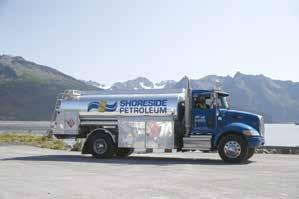

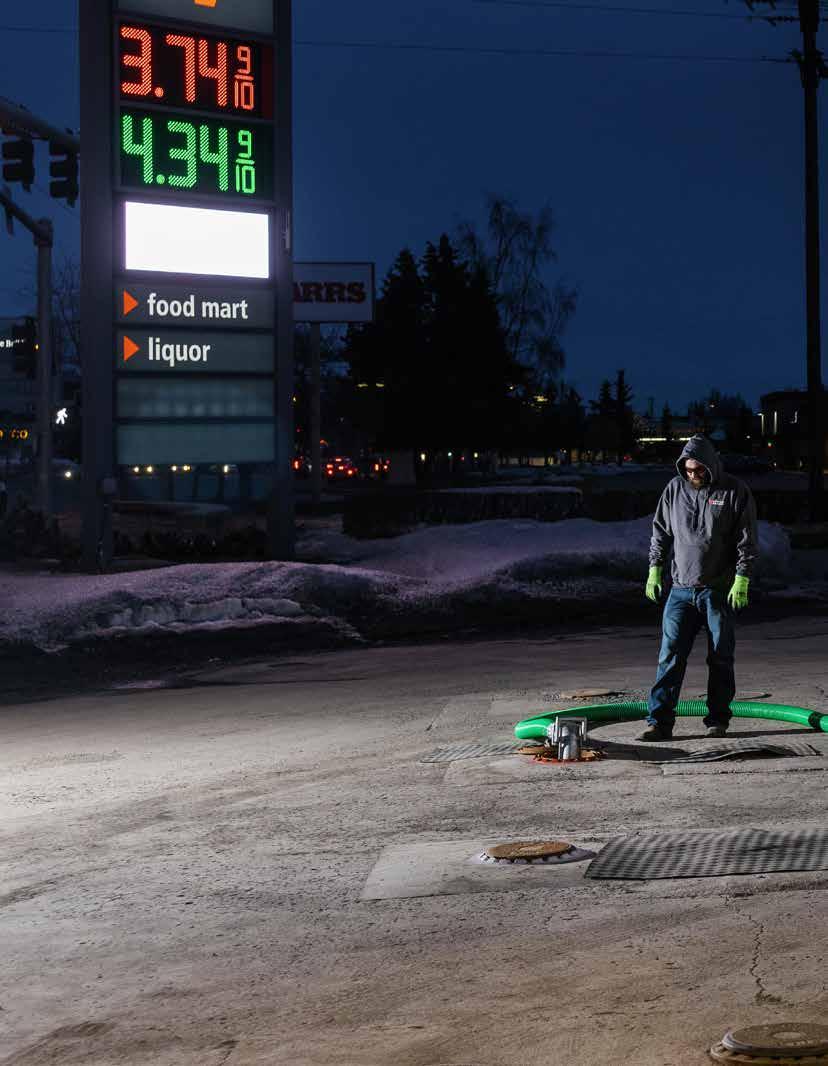

At the corner of Northern Lights Boulevard and Minnesota Drive in Anchorage, three gas stations face each other: Carrs Safeway, Chevron, and Vitus. From one spot, a consumer can read the price of each station’s key product on their illuminated signs. Fuel is one of the few goods whose price is advertised so publicly, to the tenth of a cent.
“It can be the same price for a week, and then sometimes it might change three times in one day,” says Vitus Energy co-founder and CEO Mark Smith.
If the price goes up three times in a day, customers get angry. So why provoke them? “You just want to have transparency. It is the price that it is, and you need to communicate that and let them make their own decision,” Smith says. “I guess if they're very angry, they'll drive somewhere else.”
At Northern Lights and Minnesota, drivers don’t have to go far, and that corner is hardly the only intersection where competitors are next door. Proximity is a function of traffic flow, according to Smith. “If you're going the wrong way, you're probably not going to go to the opposite side of the road. You're going to take the station on your side or wait until you're coming back the other direction,” he says.
Indeed, some drivers choose a gas station based entirely on location and ignore price entirely. “It's a strange business. Some customers will drive across town for a better price than other people. [Or] if you're on the correct side of the street for them on the way they happen to be going, you're going to get the business truly as a convenience,” Smith says. “You see both types of customers.”
Vitus Energy has been distributing wholesale fuel since 2011, and the company purchased its first retail station in Dillingham in 2013. Vitus has since acquired stores in Sterling, Trapper Creek, Tok, Healy, and a couple in the Anchorage Bowl.
Wholesale distribution is largely the same, whether by Vitus, Crowley, Inlet Energy, Sourdough Fuel, or Shoreside Petroleum, so each company distinguishes its brand through service.
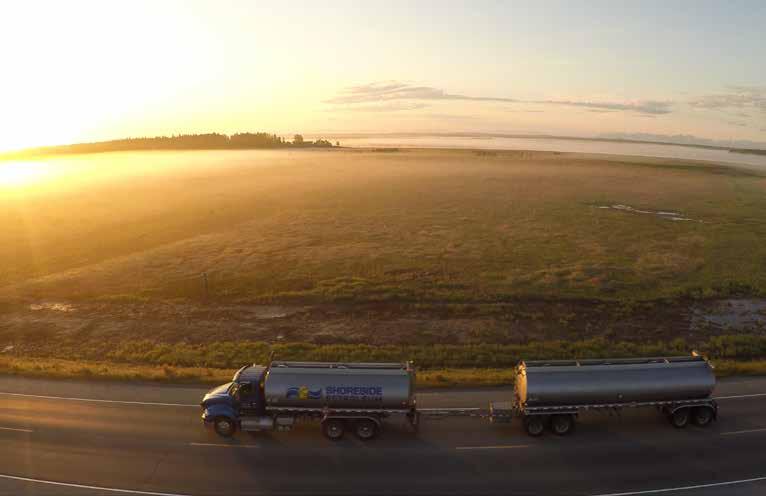
In the case of Shoreside, “We’re a family-run company, you know,” says Patrick Mulligan, director of supply chain management. “It's a smaller management team, and we like to think we're a little bit closer to the end user and the consumers.”
Shoreside Petroleum is one arm of Petro 49, which started in 1936 as Andy’s Oil Delivery in Seward. Delivery driver Dale Lindsey bought the company in 1959. His son Kurt got into the business
“Diesel drives the commercial sector almost 100 percent… I mean, everything from road equipment to all the construction equipment to the industrial equipment up on the Slope and the fishing fleet. It's really the lifeblood of the state.”
Patrick Mulligan Director of Supply Chain Management Petro Marine Services
in 1981, purchasing Marathon Fuel Service in Seward and turning it into Shoreside Petroleum, which became a subsidiary of Petro 49 alongside Petro Marine Services.

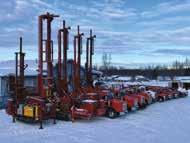
“We're transportation, but we're also procurement and purchasing,” Mulligan says. “Part of my job is working with the refiners and with the upstream folks to make those purchases, and then we distribute it through our network and ultimately to the end user.”

One side of the business Mulligan doesn’t oversee is Shoreside’s retail brand, Essential One. The logo appears on gas station convenience stores (“c-stores” in industry parlance) in Wasilla, Whittier, Anchor Point, Nikiski, Seward, and Bird Creek. The brand also has a toehold in the Anchorage Bowl, in a light industrial area along King Street. Essential One recently took over the Tesoro station at Arctic Boulevard and International Airport Road, half a mile from a Vitus station.
Renovating older rural stations and cautiously entering the urban market has also been Vitus’ strategy. Expansion into retail generates revenue in winter when barge deliveries are frozen at the dock. It also makes Smith, who grew up in his father’s fuel business, a merchant of burritos and energy drinks.
“We've had to embrace that as part of making a gas station work,” Smith says. “You have to be able to sell all these other things in order to keep them in the black. We have five liquor licenses, we sell propane, we have the suite of services you would see at normal c-stores.”
Mulligan likewise came up through wholesale distribution, scheduling fuel barges for Delta Western. When he joined the Petro 49 family in 2018, his expertise was fuel and lubricants, not food and condiments.


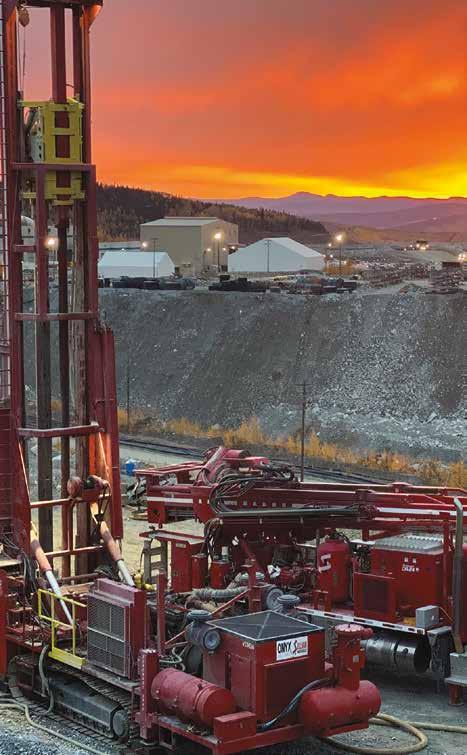
“Those air fresheners and candy bars and soda pop are a big profit source for a lot of gas station owners,” Mulligan says. “To a large extent, some of the gas that's sold there isn't their primary profit center. It's just an excuse to get people in the store to buy that other stuff.”
General merchandise is on the shelves because the margin on fuel is so thin. “These aren't cash cow businesses. They just aren't,” says Smith. “And I think that's true across the board: these gas stations, they struggle. That's why a lot

of the owner-operators, you see them leaving because it's just a very, very tough business.”
Gasoline and diesel prices fluctuate with the crude oil market and refinery capacity, and not always to the advantage of gas stations. “Whether the price of oil is low or high, it's not necessarily driving profit,” Smith says. “In fact, high prices consume more working capital, so we're not a big fan of high prices, either.”
Smith points to the example of a Vitus gas station in the Western Alaska village of St. Michael compared to a c-store like the Speedway Express on the Seward Highway at Girdwood. The highway station might sell more fuel on a busy summer day than St. Michael might sell in a year, yet both stores have similar overhead.
“The problem is that it's a fairly fixedcost business,” Smith says. “Whether you have a gas station that does half a million gallons a year or one that did 2 million gallons a year, your costs are probably very similar. And since Alaska

 The "1203" hazard tag indicates a tanker carrying a flammable liquid, such as any grade of gasoline. A tanker of diesel would be marked "1993."
The "1203" hazard tag indicates a tanker carrying a flammable liquid, such as any grade of gasoline. A tanker of diesel would be marked "1993."
doesn't have a lot of people, most of the gas stations up here don't have a lot of flow through.”
While rural prices are indeed notoriously expensive, the Railbelt region is hardly an outlier, in national terms. “On any given day, you can look at the GasBuddy prices here in Southcentral and, you know, Seattle or anywhere on the West Coast, and to a large extent they're very comparable,” Mulligan says.
Smith agrees, though he admits saying so might be provocative. “If you compare us to Hawaii or even California, Alaska has, I'm going to say, a profound discount over those two states and even Washington state on a retail level,” he says. “So we still have—relatively, all things considered— inexpensive petroleum here in Alaska.”
Contrary to what many drivers believe, most of the gasoline burned in Alaska comes from Alaska.
“The Marathon Nikiski plant has the lion's share of the gas that's consumed in Southcentral Alaska,” Mulligan explains.
“A little bit comes into Southcentral from Anacortes, but most of what we're looking at and what we're buying and consuming here in this market comes out of Nikiski.”
Marathon’s Kenai Refinery in Nikiski is the only gasoline producer in Alaska. The Petro Star refineries in Valdez and North Pole make asphalt, jet fuel, marine fuel, heating fuel, and power plant turbine fuel. But for gasoline, Marathon is the go-to supplier.
The market lacks the scale for a competitor, according to Sean Clifton, a policy and program specialist with the Alaska Division of Oil and Gas. “Where any given refinery on the West Coast has millions of customers within a short delivery radius, the Kenai refinery serves less than three-quarters of a million customers,” he says. “Any competing sources of gasoline must be shipped from Canada or West Coast refineries, which is not cheap, and then faces the same distribution cost challenges once delivered to an Alaskan port.”
However, the availability of imported fuel links the Alaska refinery economy to the Lower 48. “The refiners realize

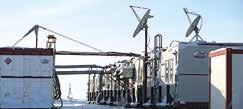


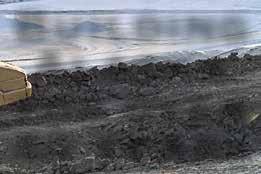
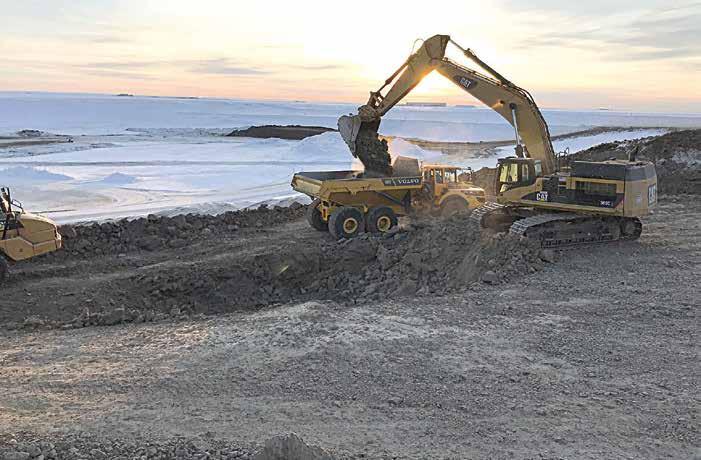
“Whether the price of oil is low or high, it's not necessarily driving profit… In fact, high prices consume more working capital, so we're not a big fan of high prices, either.”
Mark Smith CEO Vitus Energy
that they have to be competitive with product coming out of the Northwest or overseas or whatever in order to make it work. That works to our benefit,” Mulligan explains. “Nikiski realizes that just because they're up here in Alaska, they have to be competitive with other sources or else people are just going to say, ‘Well, why don't I just bring this product up from Anacortes or from Asia or wherever?’ It makes Alaska part of a larger network and gives us kind of an advantage that way.”

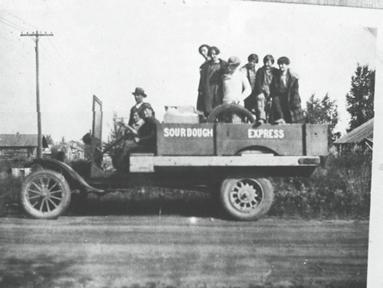
Another advantage Alaskans can be thankful for is the lowest gasoline tax of any state, at $0.0895 per gallon (held low partly because of high transportation costs). Federal taxes run $0.184 for gasoline, $0.244 for diesel. Altogether, taxes compose about oneseventh of the price of a gallon of gas.
Four-sevenths is dictated by the global price of crude oil. Another seventh is refining costs. That leaves one-seventh for distribution and marketing, including expenses and profit margin. Further details are hard to come by; Clifton
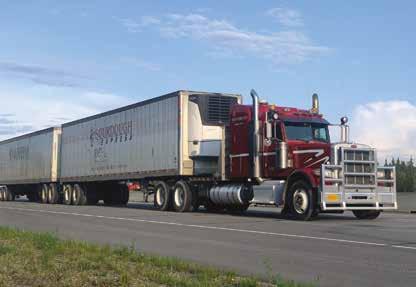
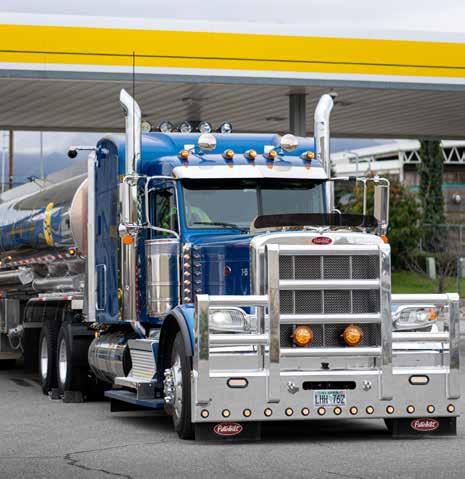
notes that pricing is subject to nondisclosure agreements, and Smith and Mulligan both abide by them.
Safe to say, though, that the distribution component is pegged to the miles traveled from a refinery. “Anchorage residents have the benefit of a products pipeline from the refinery to the port,” says Clifton. “Everywhere else in the state sees higher prices for gasoline because the cost of trucking it is necessarily a part of the price at the pump.”
Smith confirms that trucking accounts for much of Vitus’ operating costs. “Trucking has gotten substantially more expensive in the last eighteen months. The cost of a truck is through the roof, and the cost of a driver. There's just not enough drivers to go around, so they've seen substantial pay increases,” he says.
Mulligan notes that inflation has cut into Petro 49’s profits. “Every last person is making more money—the cost of all the stuff that we buy, the candy bars, the propane, and all the other things—all of those have gone up as well. So you just have a much
higher price environment but the same amount of gallons flowing through that business,” Mulligan says.
Consumers might feel a sense of control when they choose one of the three grades of gas at the pump, but the choice is limited. To begin with, so few vehicles require mid-grade 89-octane gas that auto manufacturers are lobbying to eliminate it altogether. The US Energy Information Administration shows just 7 percent of sales are from the mid-grade button; 10-percent are 92-octane premium, and 83 percent are the regular grade, 87 octane (which refers to the fraction of long-chain hydrocarbons in the refined product).
Except, as Mulligan explains, nobody makes 87 octane. “What you call regular unleaded gasoline is actually a blend of subgrade gasoline, which is 84 octane, and a premium grade, which comes out of the refinery at 92 octane,” he says.
The biggest selling fuel grade for Vitus is diesel in Western Alaska, mainly to electric utilities. With its marine services, the company delivers gasoline and diesel to more

“Anchorage residents have the benefit of a products pipeline from the refinery to the port… Everywhere else in the state sees higher prices for gasoline because the cost of trucking it is necessarily a part of the price at the pump.”
Sean Clifton, Policy and Program Specialist Alaska Division of Oil and Gas
than 100 different stops from the Arctic to the Aleutians and up the tributary rivers in between.
“Diesel drives the commercial sector almost 100 percent,” Mulligan says. “I mean, everything from road equipment to all the construction equipment to
the industrial equipment up on the Slope and the fishing fleet. It's really the lifeblood of the state.”
Alaska is a large enough state to have three different fuel markets. While the
central region depends on the Kenai Refinery, Southeast Alaska is largely supplied by US-flagged barges from Marathon’s refinery in Anacortes, Washington or the Burnaby Refinery near Vancouver, British Columbia.


“Western Alaska is primarily supplied by foreign-flagged tankers out of either Korea or Japan,” Mulligan explains, and the job of fuel companies is to carry the imported product ashore. “Barges bring all of that product into their tank farms and into some of the smaller rural villages directly off of those tankers.”
Smith adds, “It's a totally different supply chain than, say, a community on the Parks Highway where the boat piece of it is very small.” Smith grew up in Aleknagik, inland from Dillingham, and unloaded tankers for the company started by his grandfather, Smith Lighterage Company.
To this day, he’s still doing his grandfather’s job, albeit as CEO of Vitus. “We're continuing to provide a fuel supply line for Western Alaska,” Smith says, “and we are expanding our service offering, providing a choice and expanding our footprint here in Alaska.”
Mulligan also sees the rural Alaska market as an important responsibility, given that rural communities don’t have a lot of other options. “We really work hard to be able to make sure that we're meeting everybody's expectations out there, that nobody's gonna be left in the lurch or have to face any kind of hard choices or outages or anything like that. That can be just an inconvenience [in Anchorage] but it can be a matter of life and death for some of those smaller communities,” Mulligan says.
Alaska is so big that supplying fuel requires different solutions to energy and transportation needs, Mulligan adds. Even when the system works perfectly, customers might grumble, hardly realizing the effort that goes into putting fuel at convenient corner stops.
“This isn't really something that I think we do to get our names in the headlines,” Mulligan says. “When a fuel company or when anything fuel related shows up in media, usually it's not for a very good reason. So we kind of figured that, you know, no news is good news.”
The tug Dale R. Lindsey, named for the former owner of Petro 49, articulates with a chartered barge at the Petro Marine dock in Ketchikan. Judy Patrick | Petro Marine The Southeast Alaska fuel market, unlike gas stations on the road system, is supplied mainly from refineries in Anacortes, Washington and Burnaby, British Columbia, near Vancouver. Judy Patrick | Petro MarineAs of February 28, the market value of the Alaska Permanent Fund was $75.6 billion, of which $52 billion is principal, or the seed that grows investment earnings. Today, approximately one-third of the principal comes from earnings redeposited as inflation proofing, one-third comes from special appropriations, and one-third comes directly from the constitutionally required minimum of 25 percent of oil royalty proceeds.
Alaska Permanent Fund earnings come from investments in stocks, bonds, equities, and real estate, but the investment dollars come from— and started with—oil, specifically an initial deposit in 1977 of $734,000 that launched the fund.
Thus every dollar paid out of the Alaska Permanent Fund has ties to Alaska’s oil industry. The highly anticipated annual dividends are only possible because of the North Slope’s
vast resource wealth, and they disperse monies generated by oil operations through every community in the state.
Aside from Permanent Fund Dividends (PFD), direct and indirect jobs and wages, and other oil and gas industry spending, oil money also flows to Alaskans in the form of philanthropic donations directly from oil field owners and operators. ConocoPhillips Alaska typically contributes $3 million to $5 million each year. Hilcorp Alaska
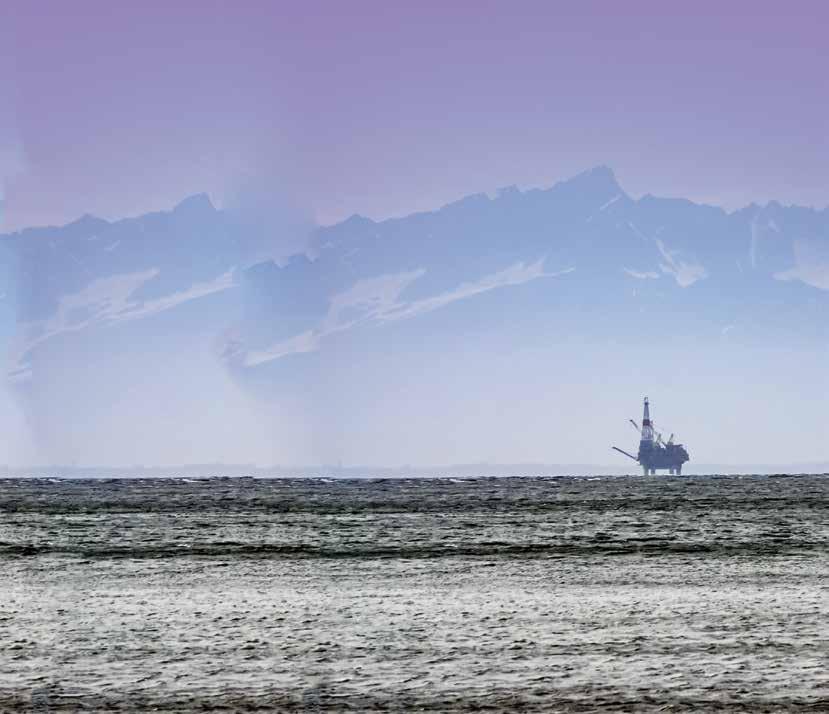
donates on a similar scale, but the company lets employees choose which causes to support. The 2021 Christmas bonus gave each Hilcorp employee $25,000 for individual donations, pumping an extra $16 million to Alaska nonprofits that year.

The same giving strategy lets every Alaskan, working for Hilcorp or not, support their favorite charities while applying for the PFD. Along with questions designed to confirm


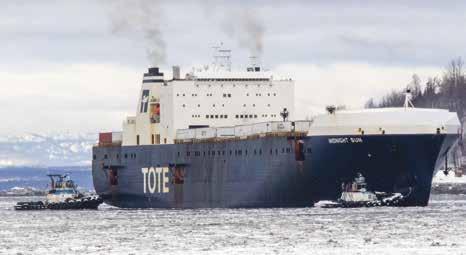
eligibility, applicants are asked one simple question that can have a huge impact:
Do they want to donate a portion of their PFD to an Alaska nonprofit?

The late Representative Bill Thomas of Haines introduced legislation in 2008 to create the PFD Charitable Contributions Program. The idea was to give Alaskans an easy and convenient way to support eligible nonprofit organizations, the University of Alaska campuses, and community foundations through their PFDs while capitalizing on the collective impact of those donations.
“We wanted to grow the total number of givers in Alaska, increase the amount that was given by Alaskans, and raise the understanding and knowledge of the power of individual philanthropy,” says Laurie Wolf, president and CEO of The Foraker Group, which drafted the legislation that became the Pick.Click. Give. program.
Former Governor Sarah Palin signed the bill into law in May 2008, and in 2009, the first time Pick.Click. Give. appeared on the PFD application, Alaskans donated $468,067 to 333
eligible organizations. In 2010 former Governor Sean Parnell signed a bill that removed the three-year sunset provision and made Pick.Click. Give. a permanent fixture in Alaska’s philanthropic landscape.
Fourteen years later, Pick.Click.Give. averages $2.3 million in contributions each year. The program is currently administered by the Alaska Community Foundation and the Alaska Department of Revenue (DOR), but its creation was a group effort.
“It was a team sport,” Wolf says. “It took government and for-profits and nonprofits all working together to make that happen. That’s something at Foraker we really believe in, and this is just such a great example of that. It’s never just one group, it’s always a team effort.”
Pick.Click.Give. was born from the Alaska Giving Coalition, a loose affiliation organized by The Foraker Group in 2005, says Wolf. It comprised an “intersection of
philanthropic organizations,” including United Way, community foundations, the Association of Fundraising Professionals, and the Alaska Funders Group, an informal collaborative of corporation and foundation funders that included the Rasmuson Foundation. At the time, Alaska had one of the lowest rates of charitable giving in the country, something the coalition wanted to change.
“One of our original goals was to raise the level of awareness of a culture of philanthropy, so really building that culture of individual philanthropy in Alaska,” Wolf says.
Wanting to impress upon Alaskans the collective power of individual giving, the coalition looked at creating a statewide campaign to increase individual philanthropy. The Foraker Group had begun researching statewide philanthropy campaigns in 2002, and the coalition realized that Alaska already had a successful campaign that was a natural fit for their philanthropic efforts.
“That was really the genesis of trying to come up with an idea,” Wolf says.
Dorsey & Whitney’s Energy & Natural Resources attorneys assist clients with a wide range of mining and oil & gas matters, providing timely and effective counsel to companies engaged in upstream, midstream, or downstream operations. Dorsey provides comprehensive representation, assisting clients in exploration, development, production, and reclamation phases of mining, litigation, and regulatory and environmental compliance.
“And a natural connection was the PFD. That was a uniquely Alaskan tool in our toolbox, so that seemed like an obvious connection.”

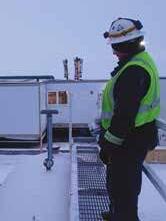


But first, the coalition needed to know whether tying a charitable contribution program to the PFD would achieve its desired goal. In 2008, the group commissioned the McDowell Group to research not just how Alaskans spent their PFD but whether they would use a charitable program tied to it.

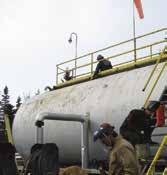

“Nobody had ever asked that question before,” Wolf says. “McDowell tried to figure out [whether] people would be charitable with their PFD. We got enough information back to tell us, yes, if we created this program, people would use it.”
At the same time the coalition was developing the program, the Alaska DOR was encouraging Alaskans to move away from paper PFD applications and instead apply online. Encouraged by the McDowell Group’s findings, the coalition tailored Pick.Click.Give. to align with the state’s efforts to increase online filings.
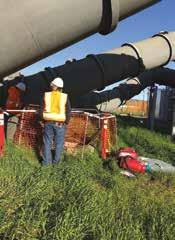
“We had the idea to make [Pick.Click. Give.] an online program so you couldn’t participate if you used paper,” Wolf says. “It met the state’s goals of trying to move people into the online application, and it met our goals of trying to connect it to giving philanthropically.”
Wolf and The Foraker Group took the lead in drafting the legislation. Foraker hired a lobbyist to garner legislative support, and the Rasmuson Foundation and The Foraker Group crafted the initial marketing campaign to name the fledgling program.
“We were calling it ‘Give cash, make change,’” Wolf says with a laugh. “We were not marketers.”

Administration and management of Pick.Click.Give. was parceled out in the early years, says Jessie Lavoie, director of programs and grants for the Alaska Community Foundation. The Foraker Group handled nonprofit education and outreach until 2019. The Rasmuson Foundation housed the program manager and covered the first three years of administrative costs, and United Way handled disbursements, she says. The Alaska Community Foundation stepped in to help with marketing and outreach in 2015 and assumed full control of the program in 2018.
“We brought all the pieces and the person managing the program into the foundation,” Lavoie says. “We realized that all the pieces needed to
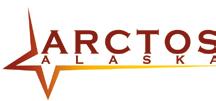
“Many parents use Pick.Click.Give. to teach their children about charitable giving, and a good percentage of our donors are young people.”
Ronnie Rosenberg Board President Fairbanks Animal Shelter Fund
come underneath one roof for the consistency of the program.”
But Lavoie says Pick.Click.Give. remains a group effort.
“Those partners from the beginning are still very much partners of ours,” she says. “Facilitation of the program all falls within the Alaska Community Foundation, but those partners go to Juneau to educate, or if there’s a big initiative coming our way, they’re there to back us up 100 percent.”
Program costs are covered by a “coordination fee” amounting to 7 percent of Pick.Click.Give. donations.
Though there was initially talk in the legislature of limiting the types of nonprofits that could participate in Pick.Click.Give., Wolf says the coalition worked to keep politics and ideology out of it.
“We worked pretty hard to keep it open to all charitable organizations,” Wolf says. “People are picking organizations from a wide variety of missions, and politics don’t have a place there. People are choosing what they
care about, and that’s what we cared about. We didn’t want it to be policed in advance. We didn’t want it to be censored in advance.”
While politics may not be part of eligibility, nonprofits must meet a set of statutory criteria, Lavoie says, and organizations must apply annually to ensure their continued compliance.
Every nonprofit included in Pick. Click.Give. must have been granted taxexempt status under 501(c)(3) by the IRS, Lavoie says. Organizations must be governed by a volunteer board of directors or advisory board, a majority of whose members must be Alaska residents; this allows local chapters of national organizations, such as the American Heart Association or the American Red Cross of Alaska, to participate. The services or aid that organizations provide must be instate, and a minimum of $100,000 or 5 percent of its total annual receipts, whichever is less, must come from charitable donations.
“If the organization is entirely grant funded, that knocks them out,” Lavoie says. “Private foundations are also not
eligible because they’re funded by one person.”
Donations made through Pick.Click. Give. are unrestricted, which allows organizations to use the funds however they see fit.
“That’s kind of the beauty of this program,” Lavoie says. “There’s no way for people within their PFD application to say they want their money to go toward a certain thing. Often, PFD contributions go toward keeping the lights on, paying the rent for their brick-and-mortar location, salaries, office supplies, things that don’t necessarily appeal to people all the time—they’re not the sexy things to fund. Pick.Click.Give. helps fill that gap for a lot of those programs.”
The Fairbanks Animal Shelter Fund is one of those programs that relies on Pick.Click.Give. donations to fill the gaps. The group uses funds to support the Fairbanks North Star Borough’s Animal Control Department.
“The money provides veterinary care, supplies, and equipment not included in the borough budget that directly helps the animals in our care,” says
» Operations and Maintenance
» Well Testing and Hot Oil Pumping
» Coiled Tubing
» Drilling Support
» Energy Construction
» Equipment Rental and Maintenance
» Pipeline Maintenance, Construction, and Management
» Well Plug and Abandonment
» Regulatory, Technical, and Environmental



» Engineering
» Remediation
» Executive and Embedded Sta ng
» Trainers and Training Programs
» Asset Lifecycle Expertise and Management










» Carbon Capture, Utilization, and Storage Project Support
» Professional Consulting

Board President Ronnie Rosenberg. “We are an all-volunteer charity with no paid staff, so for us this program is especially impactful.”

Animal welfare organizations are perennially popular recipients of Pick. Click.Give. donations, such as Alaska Dog and Puppy Rescue, Friends of Pets, the Alaska SPCA, and the Alaska






Zoo. “Animals” is one of six main categories in the program’s “Pick Tool,” along with Community, Education, Emergency & Humanitarian, Health, and Youth organizations.
Alaska Public Media, Abused Women’s Aid in Crisis, and Planned Parenthood often receive the biggest pledges each year.
Bean’s Café is also consistently one of the top recipients of Pick.Click.Give. funds. “Being local and grassroots, we
are heavily reliant on donor dollars,” says Diana Arthur, development and communication director for the Downtown Anchorage soup kitchen. “We usually provide about one meal per dollar that comes in the door, give or take. It’s something that we count on and that we are so grateful for because it just allows us to keep feeding more people.”
Arthur says that despite seeing annual donations dip by about $30,000
“Often, PFD contributions go toward keeping the lights on, paying the rent for their brick-and-mortar location, salaries, office supplies, things that don’t necessarily appeal to people all the time—they’re not the sexy things to fund. Pick.Click.Give. helps fill that gap for a lot of those programs.”
over the past few years, Bean’s Café still receives roughly $70,000 per year from Pick.Click.Give., all of which goes toward providing meals to those in need.
“All of our Pick.Click.Give. money is funneled to Bean’s Café, and it is used for operations in terms of food and supplies,” she says. “We never use donor dollars for administration fees. All of that money goes directly to feeding people, 100 percent.”
For the Alaska SPCA, Pick.Click. Give. is the organization’s single largest fundraiser; more than 800 annual donors help raise $40,000 annually on average, says Executive Director Kelly Donnelly.
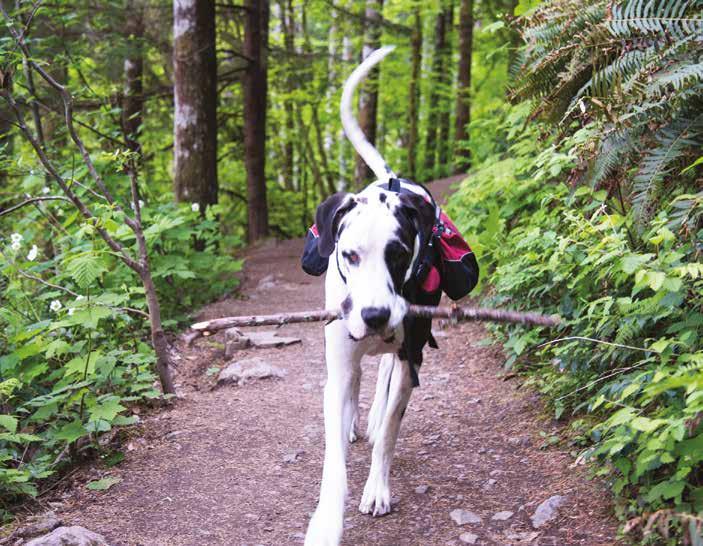
“We spend about $50,000 each year on shelter pet care,” she says. “Each pet that gets adopted out costs us about $1,440. Pick.Click.Give. picks up the lion’s share of those expenses, so it’s not an overstatement to say that it changes the lives of pets who come through our doors.”
Room to Grow Pick.Click.Give. donations have benefits beyond directly supporting nonprofit organizations. Donations remain in the community, which directly benefits the local economy, Rosenberg says, and the program is helping to build the next generation of philanthropists.
“Many parents use Pick.Click.Give to teach their children about charitable giving, and a good percentage of our donors are young people,” she says.
And there is room for growth: out of approximately 625,000 PFD applicants last year, less than 4 percent donated any portion at all, as little as the $25 minimum increment. Its best year, in both monies raised and the number of individual donors, was 2015, when 33,421 Alaskans contributed slightly more than $3.22 million, according to Alaska DOR statistics.
In an average year, 24,356 individual donors pledge roughly $2.33 million. The average donation per individual is
$103.86, with an average gift of $60.78 to nonprofits.
“[This year] being the exception so far, the higher the PFD doesn’t necessarily mean more in individual gives, but more individuals give,” Lavoie explains. “So we have more participation [in higher PFD years], but those that are participating with a large PFD don’t necessarily give as much as in the lower years.”
Through fluctuating PFD payouts, a statewide economic recession, and the COVID-19 pandemic, the program has proved stronger than statewide giving campaigns the coalition researched almost twenty years ago.
“Interestingly, those other statewide programs we researched in the early days, they don’t exist anymore,” Wolf says. “So Pick.Click.Give. has staying power that is unprecedented. It’s weathered all the economic storms, low PFDs and high PFDs, all the things.”
Pick.Click.Give. carries a Great Dane-sized chunk of Alaska SPCA’s budget as the organization’s single largest fundraising stream. About 800 PFD filers donate $40,000 annually.“Alyeska Pipeline Service Company is proud to have helped build a stronger Alaska with United Way for more than 50 years. By offering a corporate match program through our annual United Way campaign, we multiply the impact of every dollar our employees give. With our culture of giving and an eye to the future, we look forward to working with United Way for the next 50 years.
I invite you to learn about the work United Way is doing to remove barriers and create opportunities that improve lives in every corner of our state.”
 Betsy Haines, Interim President Alyeska Pipeline Service Company
Betsy Haines, Interim President Alyeska Pipeline Service Company
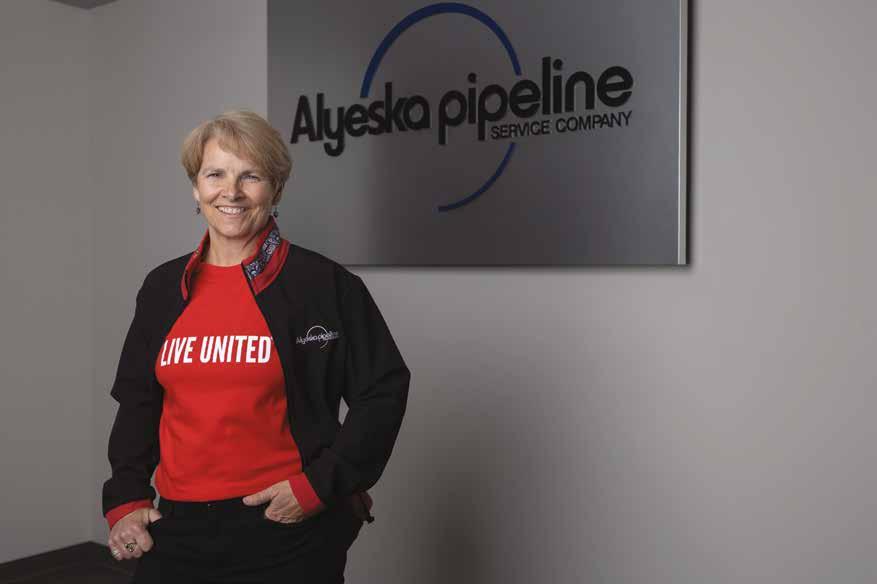
Solar energy is sizzling. Almost 2,000 customers of the four Railbelt electric utilities have tied solar installations to the grid, according to the Alaska Center for Energy and Power at UAF. Last year, 60 commercial customers of Chugach Electric Association and nearly 600 residential customers added photovoltaic (PV) installations.
“Solar PV is quickly becoming one of the lowest-cost options for energy or electricity generation in the world, and the same reflects in Alaska,” says Edwin Bifelt, founder and CEO of Alaska Native Renewable Industries, which has completed several large installations. “The projects that we’re doing show that solar is very doable from a conception standpoint. You don’t need a lot of heavy equipment assets involved. The biggest challenge for us is the foundation. After that it’s mostly just our labor crews involved.”
Alaska has been late to the party as far as installation cost is concerned, says Curtis W. Thayer, executive director of the Alaska Energy Authority (AEA), but that’s changing thanks to generous
federal credits. The value proposition of solar energy pencils out favorably for more utility customers and for power producers, too.
“Many of the utilities are currently talking to solar developers about potentially building large multimegawatt arrays in their service areas,” says research engineer Chris Pike, solar technology program lead for the Alaska Center for Energy and Power. “Chugach Electric has selected at least one for further review, and they’re doing studies for that array. The location and size are not public. The interesting thing is you’re starting to see a lot more private investment.”
New technology has helped raise the efficiency of PV projects, such as scaled-up manufacturing of bifacial solar cells in the last decade. Within the next few years, bifacial panels are forecast to eclipse the market share of older monofacial panels. Bifacial cells have the advantage of generating energy from light reflected onto the shady side of panels.
“They offer the option to orient the panel vertically, so the panel can
generate more in the morning and evening,” Pike says of bifacial panels, adding that Alaska’s long spring and summer days, with extra hours of low-angle sunlight, are well suited to vertical panels.
And interest in solar energy is rising as Alaskans seek alternatives to fossil fuels, whether to curb carbon dioxide emissions or to conserve nonrenewable resources. “There are also discussions of how rooftop solar can play a role in reducing the amount of natural gas that’s consumed in Southcentral Alaska, especially as the Cook Inlet gas supply is in question,” says Pike.
The largest solar energy generator in Alaska, for now, is located across the Parks Highway from Nancy Lake at the southern edge of Willow. Renewable Independent Power Producers (IPP) built the Willow Farm as a 140kW pilot project in 2018. It was the company’s first solar project and consisted of 340W panels—408 of them—laid out in two arrays, each the length of a

football field. The original configuration produced enough power for twentyfive to thirty homes year-round and offset 200,000 pounds of carbon dioxide per year.

Just one year after the Willow Solar Farm was built, IPP completed an expansion, financed in part by AEA’s Power Project Fund loan program. The other half of the funding for the project came from private capital. The expanded 1.2MW solar farm consists of 3,240 solar panels that offset 2 million pounds of carbon dioxide annually. “The facility produces enough power for 200 homes,” according to Thayer, “and sells to Matanuska Electric Association.” Its rated capacity is twice the size of Golden Valley Electric Association’s solar farm, the only other utility-scale project in Alaska.
The Willow Farm won’t be Alaska’s—or IPP’s—largest solar project for long. Last fall, construction began about 10 miles down the highway at the Houston Solar Farm. When complete, the project will cover 45 acres with ballasted bifacial PV panels. The farm is expected to provide enough energy for 1,400 homes, which
for

is more households than in Houston itself. Matanuska Electric Association has committed to purchasing all of the energy generated there. The 8.5MW solar array will be the largest utilityscale PV solar installation in the state when it’s complete, or about the same


The Houston Solar Farm is being funded in part by a $4.9 million loan from AEA’s Power Project Fund. The rest of the financing comes from New York-based CleanCapital, an investment platform which will be owner/operator of the project. IPP, working under contract to CleanCapital, will perform all construction as well as continuing operations and maintenance.
North of the Arctic Circle, sunlight wanes in winter but waxes strongly in summer, more ripe for harvest than might seem possible at those chilly latitudes. Kotzebue has been harnessing wind energy for more than twenty-five years, but Kotzebue Electric Association (KEA) has been transitioning to solar since 2020. A $1.9 million project replaced 532kW of firstgeneration wind turbines with 532kW of solar panels and inverters, co-located at the KEA wind site. The initial part of the project was funded by NANA Regional
“There’s no magic bullet when it comes to types of energy… Solar only works when the sun is out. Solar is only a piece of the puzzle.”
Chris Pike Research Engineer Alaska Center
Energy and Power
Northwest Arctic Borough, through the Village Initiative Fund ($600,000); and KEA ($700,000).
The next phase of the project swapped out eight obsolete 66kW wind turbines in favor of PV panels expected to produce 680,000 kilowatt hours (kWh) per year. This part of the project was funded by a $1.9 million Alaska Renewable Energy Fund grant.
North of Kotzebue, Noatak faces high energy costs due to its remote location. In July 2022, the average cost for electricity in Noatak was nearly $0.27 per kWh for customers using up to 500kWh of energy. Those who used more than that saw prices soar to $0.90 per kWh. A solar energy project in Noatak is underway to help reduce those costs.
Currently under construction, with an estimated completion date of June 2023, is a 280kW solar PV system and inverters and 500kW/460kWh of battery storage. The project’s total estimated cost is just under $3 million. It was funded with a 2021 award from the Department of Energy’s Office of Indian Energy (approximately $2 million), the Village Improvement Fund ($310,000), Denali Commission (approximately $134,000), NANA Village Economic Investment ($250,000), Teck Resources
($100,000), and the Northwest Arctic Borough (approximately $84,000).
When finished, Phase I of the project will include a main solar area of 900
feet by 300 feet and a fenced-in battery building of 30 feet by 20 feet. Construction began in September 2022. The first phase will consist of 432 Canadian solar bifacial 650W panels. The solar project’s rated output would supplement Noatak’s 1.5MW diesel power plant.
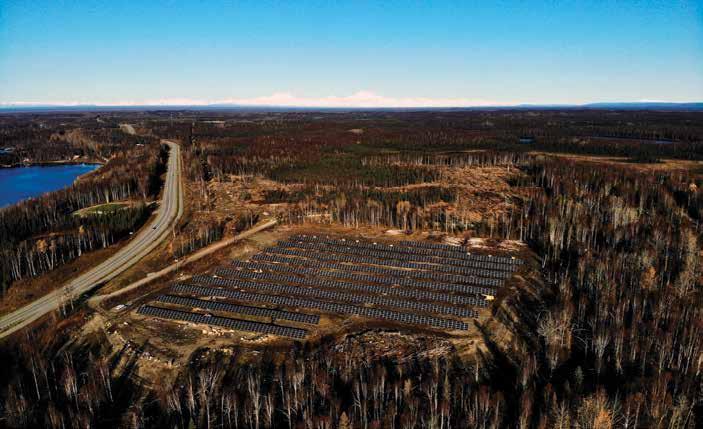
Villages inland from Kotzebue are in the planning stages for solar energy projects. Ambler, Kiana, Noorvik, and Selawik are joining together for a shared system.
Ambler is located on the north bank of the Kobuk River, 45 miles north of the Arctic Circle. Downstream, Kiana overlooks the confluence of the Kobuk and Squirrel Rivers. Noorvik is downriver from the Kobuk Valley National Park on the Kobuk River, and Selawik is located a little farther south at the mouth of the Selawik River, about 90 miles east of Kotzebue, near the Selawik National Wildlife Preserve.
All four villages share a low population and a remote location, which translates to high utility costs. The Northwest Arctic Borough was awarded a $590,000 grant from AEA’s Renewable Energy Fund (REF) for the final design and permitting of solar
“My vision is hopefully we’ll be able to get to the point where the solar industry in Alaska can scale significantly in the next five to ten years…
If we’re able to get five to ten projects per year in Alaska, that would be huge.”
Edwin Bifelt, CEO
Alaska Native Renewable IndustriesThe 1.2MW Willow Solar Farm is the largest in Alaska, at least until Renewable IPP finishes construction of an 8.5MW array in Houston.
PV and battery storage to service all four villages. The final two bids from engineering companies were being evaluated this spring.

South of the Arctic Circle, Galena is a village in central Alaska located on the Yukon River about 270 miles west of Fairbanks. All supplies get there by air or by water, including fuel to provide power. In the summer, fuel deliveries are transported by barge up the Yukon; in winter, by plane. As a result, “Fluctuations in global fuel prices can significantly increase the already expensive delivery costs,” according to a FEMA case study published in 2019. The study went on to note that energy costs $0.67 per kWh in Galena.
Thus, Galena officials are planning a 1.2MW solar PV system as well as a 500kW/800kWh battery energy storage system. The project is in the planning stage, with 95 percent of the final design completed. The City of Galena received a $2 million REF grant, and there is a $2 million anticipated cost increase. Once completed, the system is expected to save an estimated 80,000 gallons of diesel annually at
Galena’s 3.9MW power plant—and more than 2 million gallons in diesel savings over its projected twenty-five year lifespan.
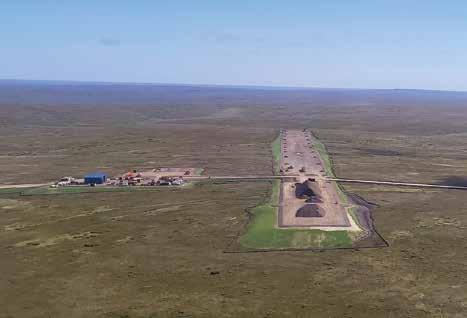
About 250 miles down the Yukon River in Holy Cross, the Alaska Village Electric Cooperative received a $135,000 REF grant to study the feasibility of its own potential solar energy and battery storage.
Grants from AEA are also helping to study possible future solar projects closer to the Anchorage area. Point McKenzie Solar, a venture of Anchorage realtor Fred Thoerner, received a $75,000 REF grant and is in the midst of a USDA Compliant Feasibility Study to explore a solar site with an expected 5.9MW capacity and delivery of approximately 500MWh monthly via an interconnection with Chugach Electric Association.
The Native Village of Eklutna is currently working on a solar feasibility study for Site One and Mohawk Camp properties in Eagle River in order to develop technical and economic

viability for the village. It received a $25,000 REF grant for the study.
Solar is attractive because it generally has low operation and maintenance costs and few moving parts that can break down. Add that to ease of installation and the fact that solar has been getting cheaper, and it becomes an energy savings win.

But other alternative energy methods are also being explored, things like wind and hydroelectric power—especially in Alaska where harnessing the power of the sun isn’t possible at all times of the year. “There’s no magic bullet when it comes to types of energy,” says Pike. “Solar only works when the sun is out. Solar is only a piece of the puzzle.”
“Long term, my vision is hopefully we’ll be able to get to the point where the solar industry in Alaska can scale significantly in the next five to ten years,” says Bifelt. “If we’re able to get five to ten projects per year in Alaska, that would be huge. There’s probably 150 rural remote communities in Alaska… and it would be a huge asset for these local communities.”
Greens at the Able Raceway minigolf course in South Anchorage look more verdant than the industrial park across the fence, but looks can be deceiving. Inside a nondescript building, Vertical Harvest Hydroponics (VHH) is pursuing a greener vision. From that office, VHH runs a manufacturing facility in Palmer than makes hydroponic systems for growing vegetables and herbs. Inside cabinets or containers, leaves bask in artificial light while roots soak up nutrients from pans of liquid.
Dr. William Frederick Gericke coined the term “hydroponics” after he developed a commercial means to grow plants in 1929. Until then, it had only existed as a laboratory technique. Hydroponics gained greater acceptance when the US Army used the method to grow fresh food for troops stationed on the Pacific Islands during World War II. By the ‘50s, viable commercial farms existed in America, Europe, Africa, and Asia.
Currently, hydroponics is primarily used by small farmers, hobbyists, and small to mid-sized commercial enterprises. VHH Vice President Jamie Boring says hydroponic enterprises are more common in the Lower 48 than in Alaska. He reasons that this has to do with the risk-averse nature of Alaskan entrepreneurs who contend with higher business expenses and greater logistical challenges.

VHH markets its own unitized hydroponic farm systems. Boring says products sell as fast at the Palmer factory can make them. Manufacturing is one of the company’s four core pillars, though. The others are workforce development, education, and community. VHH evaluates each of these areas as it works with clients and partners to assist them in becoming more resilient in the face of climate change and uncertain economic times.
“We are working with communities to create longlasting food production opportunities,” Boring says. “We are not just doing equipment drops and saying, ‘good luck.’”
Anyone shopping at a grocery store post-pandemic has probably seen an occasional string of empty shelves due to shipping issues.
“Long-time Alaskans have always known the risks to our state due to our geographical location,” says Boring. “Shipping costs have always been high and are increasing. We have always had supply chain instability for fresh food.”
Boring says disruptions to the supply chain caused by the 2018 earthquake and the COVID-19 pandemic, particularly for foods, only emphasized the importance of hydroponic farms in Alaska.

According to the Alaska Food Policy Council, a statewide source on local and state food systems, Alaska imports roughly 95 percent of food purchased, and most grocery stores are only able to carry a 3-to-5-day supply on their shelves. The "2021 Alaska Food Security Investment Recommendations" called for Alaskans to strengthen in-state food systems; to increase access to fresh, local, and healthy foods; to create economic opportunities; and to reduce food insecurity statewide.
Alaskans of all ages are affected by chronic food insecurity. According to Feeding America, a charity working to end hunger in the United States, 79,670 Alaskans (1 in 9) regularly face hunger. Of that number, 26,910 (1 in 7) are children and 1 in 10 are seniors. Several factors contribute to food insecurity. At the top of the list is poverty. The Center on Budget and Policy Priorities, a nonpartisan research and policy institute, shows 85,000 Alaskans receive federal SNAP benefits (formerly food stamps) annually, with children living in 67 percent of SNAP households. Though urban Alaska has a higher absolute number of people experiencing food insecurity, the rate of food insecurity is higher in rural areas.
As supply chains lag and the cost of food continues to rise, the issue of food security has moved to the forefront, with several manufacturers, retailers, and innovators advocating for increased use of hydroponics to supplement food supplies.





The US Department of Agriculture considers hydroponics to be any

technique of growing plants using a water-based nutrient solution rather than soil. The setup can include an aggregate substrate or other growing media such as vermiculite, coconut coir, or perlite. The benefits of hydroponic farming include less use of water compared to soil farming, less use of land, extended growing seasons, decreased carbon footprint and spoilage due to less travel to market, and increased nutrient density since it’s harvested closer to the point of consumption.
However, funding to purchase and set up farms is limited, and utility costs are sometimes too high for an economically viable hydroponic farm. This is generally the case for communities that are off the main road system.
To encourage farm financing, VHH started its Growing Farmers Program to gain better awareness of farmingrelated funding challenges and opportunities through collaboration. The program is a hands-on partnership between growers and VHH specialists as they work on a viable business plan and market analysis prior to approaching local lenders. Information gathered in the collaborative process is shared between program participants and community and government leaders in hopes of removing the barriers to success.
“Challenges, when reframed, become opportunities,” says Boring. “If we start at the 30,000-foot view and look holistically at the entire food system, we can affect change within our scope of influence and ensure there’s a viable financial revenue model.”
At no point does Boring suggest that hydroponics should replace soil farming. In fact, he says it’s unfortunate that a false bifurcation even exists between soil and hydroponic farming, where people see it as an either/or way to produce food. Instead, VHH advocates
hydroponics as a method that adds to what is produced by traditional soil and livestock farming, and as a way to let soil rebuild to insulate farmers from environmental disasters such as floods, hail, and droughts.
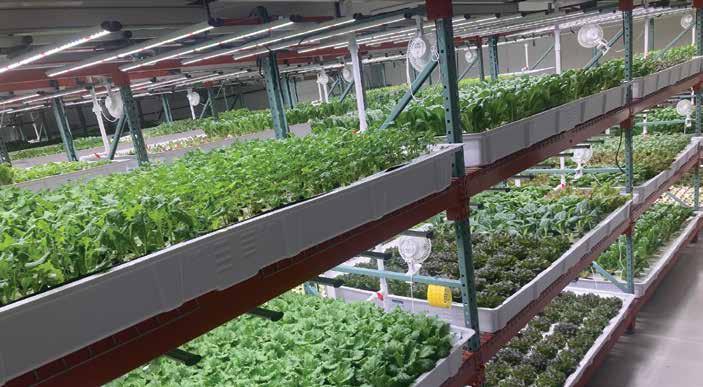
Hydroponic markets are already gaining ground in urban areas. A short walk across East 76th Avenue from VHH’s office, Anchorage Greens sells hydroponic produce at its onsite Garden Market and offers a weekly Green Bags subscription service that provides a rotating selection of premium greens and herbs.
In 2019 Anchorage Greens started growing and harvesting produce in a hydroponic farm to maximize product freshness, shelf life, and value while minimizing shipping, packaging, and food waste. Its mission was to create a pesticide-free cultivation using exclusively non-geneticallymodified varieties.
“Hydroponics is as important as any food production system,” says Trevor Kirchoff, owner of Anchorage Greens. “It is another option for specific crops that can grow in a specific situation.”
Even though Anchorage Greens experiments with a variety of greens, Kirchoff isn’t planning on investing in new technology soon. He says the basic hydroponic equipment is capital-
“Hydroponics is as important as any food production system… It is another option for specific crops that can grow in a specific situation.”
Trevor Kirchoff Owner Anchorage GreensAnchorage Greens sells produce from its hydroponic farm at its onsite Garden Market and offers a weekly Green Bags subscription service that provides a rotating selection of premium greens and herbs.
intensive, and plants sometimes grow differently than expected. Bouman adds that growing plants without sunlight does require a large amount of energy, but he foresees a time when indoor farming will become a major way that Alaskans acquire fresh produce.
Also in the Taku-Campbell neighborhood, CityFarms Alaska started growing produce indoors in a warehouse in 2017, selling it locally to Alaskans through Natural Pantry, New Sagaya Midtown Market, New Sagaya City Market, Fred Meyer, and Carrs Safeway. Its mission is to make healthy food available to everyone regardless of the season.
Currently, CityFarms Alaska grows and sells arugula, spring mix, kale, basil, mint, dill, rosemary, thyme, chives, and sage. Nik Bouman, owner of CityFarms Alaska, says the only difference with growing food in a hydroponic farm is that the nutrients are dissolved in water instead of being tied up in organic matter. Most of the routine work is related to managing nutrients and the water system, improving space efficiency, lighting, and labor productivity to increase crop quality and yield.
“At the end of the day, we believe the quality of our food is just as good as that grown outdoors in soil,” says Bouman.
For CityFarms Alaska, hydroponic farming is more labor efficient; large indoor systems are easier to clean and maintain versus the labor-intensive management of soil farms. However, Bouman says the nutrient solution does need to be actively maintained and often flushed and refilled at frequent intervals to maintain good nutrient balance.
“You can’t just set and forget and expect to grow healthy crops,” says Bouman.



There are currently six main types of hydroponic systems: wicking, deep water culture, nutrient film technique (NFT), ebb and flow, aeroponics, and drip system. There are also several variations based on these six types, including the Kratky Method, Fogponics, and Dutch/Bato Bucket. Commercial growers tend towards the NFT method because it’s often considered the most efficient technique.
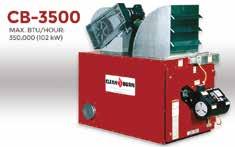

Depending on available space, commercial growers will use either a horizontal or vertical setup. In general, horizontal NFT systems are best suited for larger spaces and maximizing the growth of plants, while vertical NFT systems are better for smaller spaces and faster yields, as they limit the maximum growth of the plant. Each system has its advantages and disadvantages, such as initial investment, power consumption, risk of flooding and clogging, and light requirements.

Wasilla inventor Cecil Ellsworth saw the need to develop a growing system that brought together the best parts of a vertical and horizontal NFT. During the 2022 UAF Arctic Innovation Competition, he conceptualized a rotating rack system that would maximize the growth of plants in small spaces at a high rate. Each round rack was designed to hang arrays that allowed forty-eight rows per fixture. Based on a 260-by-260-foot growing room, Ellsworth determined that his HydroSlats system would produce approximately 547,000 heads of lettuce per month, or 18,000 per
day, double the entire state’s daily lettuce demand.
“No one has created an automated system at this scale,” says Ellsworth. “Hydroponics is a proven technology.
Now we just need to make it more energy efficient.”
His design earned HydroSlats third place in the Main Division of the competition in addition to recognition in the Sustainability Kicker category. Ellsworth is preparing to pursue funding for a prototype; he estimates that he needs $275,000 to manufacture all the components and create a small pilot facility. He plans to start actively seeking funding this summer.
Boring says any successful hydroponic movement is going to take a combination of manufacturing, education, and workforce development to create a localized food production system that can offer the variety and quality at the needed quantities. He says creating a vision and an action plan is key to adapting existing food production methods with hydroponics farming for maximum output.
“Changing the status quo won’t be easy,” says Boring. “But considering the benefits of sustainability, it will be worth it. Food is part of us. We must work together to solve food accessibility issues.”
“Changing the status quo won’t be easy…
But considering the benefits of sustainability, it will be worth it. Food is part of us. We must work together to solve food accessibility issues.”
Jamie Boring Vice President, Vertical Harvest HydroponicsCityFarms Alaska produces a variety of greens that are sold widely in Alaska supermarkets. Owner Nik Bouman says hydroponic farming is more labor efficient compared to traditional soil farming.
With over 40 years of experience, Carlile continues revolutionizing logistics solutions for Alaska’s oil and gas industry. Together we move forward.
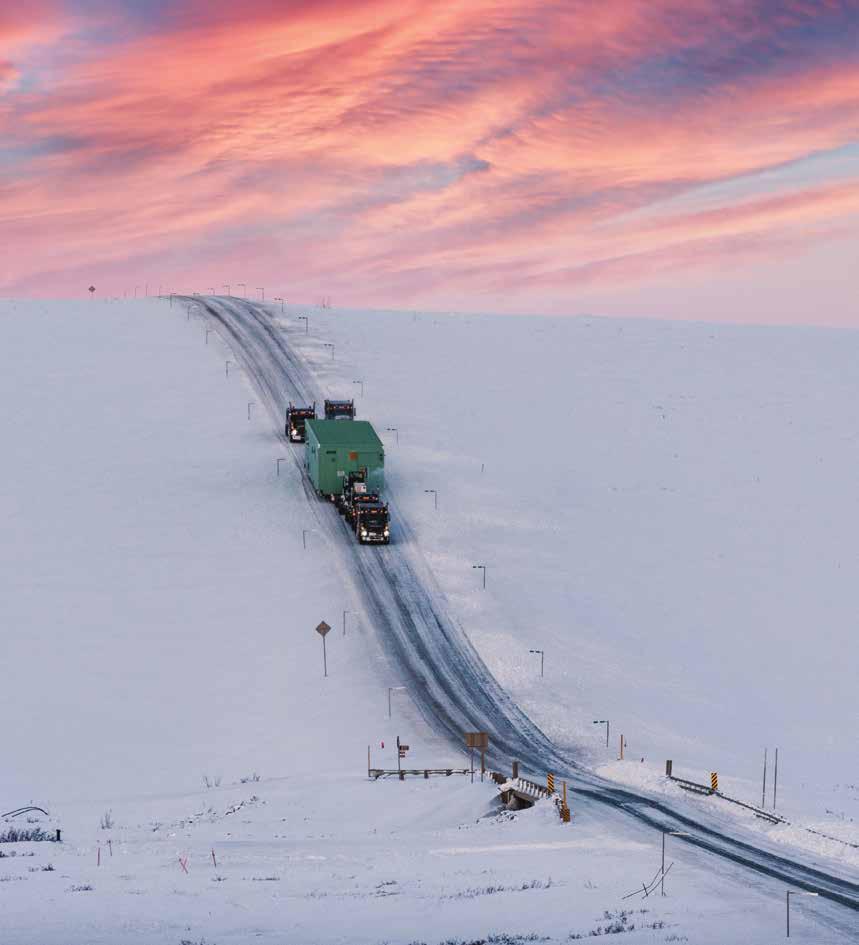
“One does not resist the invasion of ideas,” said Victor Hugo, and one idea whose time has come has been bubbling underneath the Aleutian Island arc. Fifty million years in the making, visionaries now are taking active steps toward energizing Unalaska’s electrical grid with geothermal energy tapped from nearby Makushin Volcano.
An exploratory test well in 1983 determined the Makushin resource can supply enough geofluid to generate 500MW for 500 years. The geothermal
resource at the base of the active volcano 14 miles from the Aleutian fishing community of Unalaska/Dutch Harbor is well documented, according to Dave Matthews, program manager with the joint venture Ounalashka Corporation/Chena Power (OCCP).
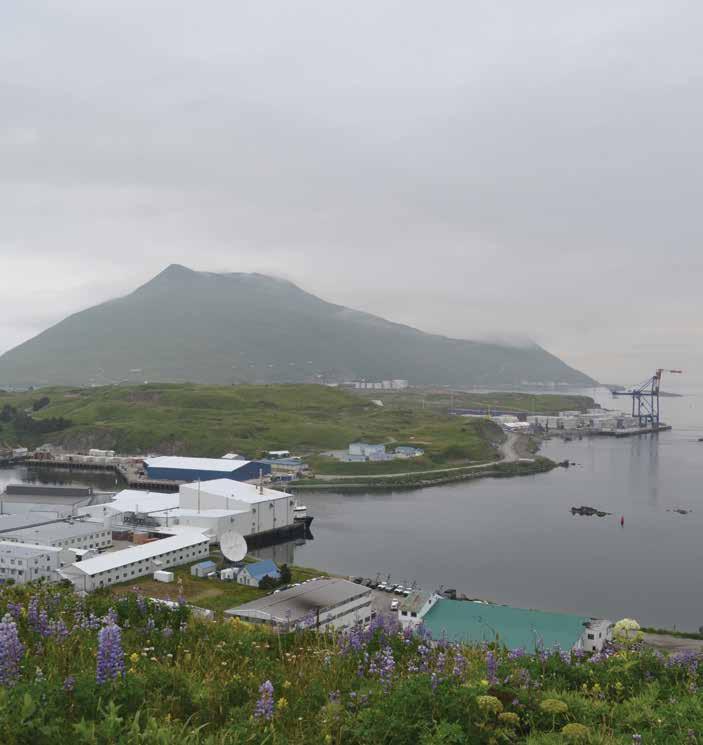
“Tens of millions of dollars have been spent in the past forty years investigating this resource, with Alaska Division of Geological & Geophysical Surveys, Republic Geothermal, Alaska Energy Authority, and the University of Alaska investing time and research
into the value of the resource,” says Matthews. “Multiple PhDs have been earned based on resource investigations. The Makushin Geothermal Resource is hence a verified resource that is wellknown in the geothermal world.”
After several failed attempts by others at developing the utility resource, the joint venture between Unalaska’s Native village corporation, Ounalashka Corporation, and Chena Power, a privately-held Fairbanks-based entity that installed the first geothermal power plant in Alaska, is scaling the
hurdles of also being the first in the state to transform the volcano’s thermal energy into green energy for residents of Unalaska.
Ownership of the land and subsurface rights around the volcano has been a roadblock for previous developers. That is no longer the case.
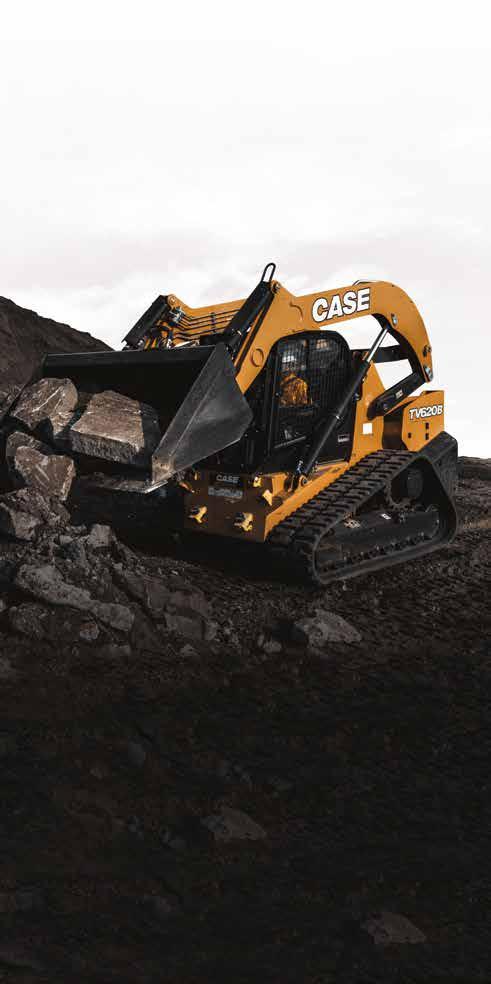
“There are no land ownership/access issues,” says Matthews. “The entire project corridor and facilities are on our 51 percent partner’s land, made possible by a key 7,037-acre purchase by Ounalashka Corporation in 2019.”
High capital costs were also an issue that the joint venture has overcome. “OCCP has contributed significantly via in-kind contributions in order to keep the development costs low,” Matthew says.
Another boost was the City of Unalaska committing in 2020 to a thirty-year annual payment starting at $16.3 million, increasing 1 percent per year, according to Steve Tompkins, director Public Utilities for Unalaska.
“We’re going to change the world. Unalaska and Dutch Harbor will be the poster child for the world,” says Bernie Karl, co-founder, president, and director of OCCP.
Also labeled as inventor, serial entrepreneur, “imagineer,” and a longtime advocate for geothermal energy, Karl is the founder and developer of Chena Hot Springs Resort outside Fairbanks. Not only does geothermal energy provide 100 percent of heat and electricity for the resort, but it also heats greenhouses that produce lettuce and tomatoes for the resort’s restaurant and refrigerates the Aurora Ice Museum at a cool 25°F year-round.
Karl is scaling up his vision for geothermal in Alaska as he works to advance the Makushin Geothermal Project, which taps energy from a much larger geothermal source: the Pacific plate subducting under the Aleutian chain.
Considered the gateway to the Aleutian Islands, Unalaska lies approximately 900 miles southwest of Anchorage and is home to the Port of Dutch Harbor, the busiest fishing port in North America by volume. The
island has roughly 4,200 year-round residents but can bulge to 10,000 when the fishing season is in full swing.
“Unalaska/Dutch Harbor will be the first community in the United States to have zero emissions,” Karl envisions. “We’ve done a heat pump study to put heat pumps in every home using 1kW of geothermal energy and you get 4.5kW of heat out, so it’s 4.5 to 1.”
The city typically purchases up to 3 million gallons of diesel per year, Tompkins says. The price per gallon fluctuates widely: the average price in May 2020 was $1.12 per gallon, and July 2022 saw an average price of $5.27 per gallon. Overall price for FY22 was $3.39, according to Tompkins.
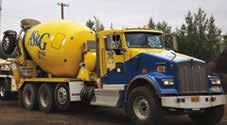

Totally dependent on diesel for its two generating plants, the City Power Division supplies 22.4MW, less than 40 percent of the power generated on the island, according to Tompkins. Six entities, including local fish processors, run their own diesel generators.
“We’re looking at November 2027 for delivering 30MW of power to Unalaska/ Dutch Harbor, and it’s going to change the world,” Karl says.

The plan for the Makushin Geothermal Project is to construct a plant that uses artesian hot geofluid (390°F) that boils an organic fluid (such as propane, butane, or more exotic hydrocarbons) into vapor to turn a turbine generator. Electricity is generated and the geofluid is reinjected into the ground, while the vapor is sent through cooling towers, converting it back to liquid for re-use.
A lot has been accomplished since the City of Unalaska’s commitment to purchase power from the geothermal project.
“We have a 50-year lease for the geothermal resource. We have all the necessary permits to proceed for the infrastructure installation for the 10 mile stretch from Broad Bay to the plant site,” Matthews says.
Broad Bay is the location closest to the base of the valley leading up to the 6,000-foot volcano, whose eastern slope is the proposed site of the project’s geothermal plant.
Matthews adds, “We have completed the basic engineering, enabling bidding of certain phases of the project.
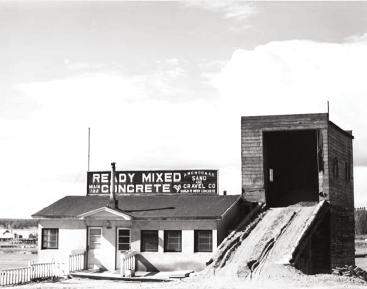
“The Ormat EPC contract is by far the largest and most technically complex part of the overall project… Having secured a fixed result contract in this important area of the project is indeed an important milestone.”
Bernie Karl, President, OCCP
We have completed a significant mobilization of equipment and camps and have constructed 2.3 miles of the utility access corridor.”
Several contractors have already added their expertise to the project.
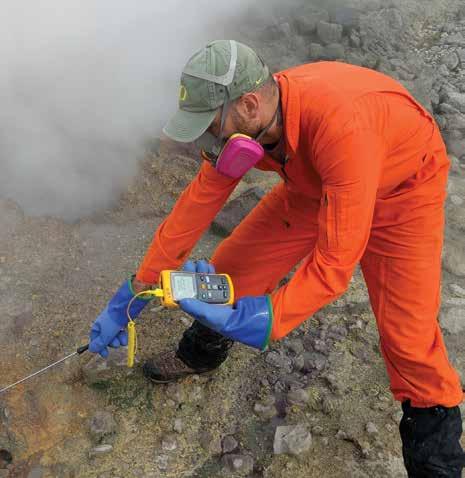
Ormat Technologies signed an engineering, procurement, and construction (EPC) contract with OCCP in January worth approximately $100 million. The Nevada-based company will build the Makushin power plant and remote gathering system that collects hot geofluid and then re-injects it into the ground. Ormat will also be responsible for supervisory control and data acquisition of fiber optic control integration from the entire plant to the City of Unalaska dispatch center.
“The Ormat EPC contract is by far the largest and most technically complex part of the overall project,” Karl says. “Having secured a fixed result contract in this important area of the project is indeed an important milestone.”
Ormat’s history in Alaska began with the Trans Alaska Pipeline System, selling power units for remote gate valves along the pipeline route. It has built
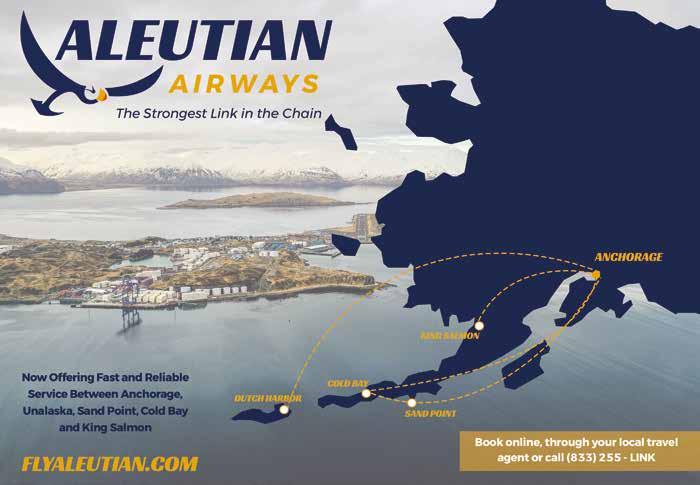 Geochemist Allan Lerner of the US Geological Survey measures the temperature of a bubbling pool in the upper Glacier Valley south of Makushin Volcano.
Geochemist Allan Lerner of the US Geological Survey measures the temperature of a bubbling pool in the upper Glacier Valley south of Makushin Volcano.
more than 190 power plants around the world and is now the secondlargest thermal power producer in the United States.
The joint venture selected Power Engineers of Hailey, Idaho as an independent engineering firm to represent OCCP in specification writing, design criteria, bid evaluations, and guidance in various technical areas.
OCCP signed a contract for utility access corridor and transmission line routing and design in 2020 with 3-Tier Alaska, Travis Peterson Environmental, and Northern Land Use Research Alaska. The contractors will assist in routing delineation; wetland, biological, and archeological resource identification; and design of the utility access corridor (road) from Makushin Bay to the powerhouse site. Anchoragebased CONAM Construction has been chosen to install land-based power and communication transmission cables, substation modules, and the battery energy storage system.
TerraSond Precision Geospatial Solutions commenced work in 2021 with F/V Miss Alyssa, performing

geophysical route surveys for the two power and communication subsea cables over a 4-mile route, connecting the geothermal plant’s electrical output and control to the City of Unalaska.
Data collected was analyzed by Wopschall Consulting for route selection, with a marine archeologist performing archeological studies. That effort enabled J.F. Brennan Company, a marine specialty contractor based in Wisconsin, to develop an installation plan and estimate for the subsea installation for its contract piece. That same data is utilized for the subsea permit application.
The punch list for this year’s construction season includes resuming utility access corridor construction through the Makushin Valley up to the power plant site and mobilization of a large drill rig at the production well site, Matthews says.
The concept of harnessing energy from a volcano to power an electrical grid 14 miles away sounds challenging, yet Tompkins says the city is excited
“In order to take power from the Makushin Geothermal project, the island electrical distribution system has to be significantly upgraded and formed into a unified grid… The project needs significant participation from many of the selfgenerators in order to be economical to the city.”
Steve Tompkins Director of Public Utilities, City of Unalaska
about geothermal power becoming a reality. And while many aspects of this project are expensive, Tompkins sees getting everyone connected as the most expensive portion of the project.
Geothermal project installation has high capital requirements, and the facilities are normally located where they can supply output to a large electrical grid at full capacity around the clock, says Matthews. Unalaska is a small, isolated grid with a plant designed to follow the load as demand fluctuates, which increases the initial installation costs.
“In order to take power from the Makushin Geothermal project, the island electrical distribution system has to be significantly upgraded and formed into a unified grid,” Tompkins explains. “The project needs significant participation from many of the selfgenerators in order to be economical to the city.”
“Upgrading the existing distribution and installing additional distribution to connect to all self-generators in preparation for hooking into geothermal power is the most expensive portion of
the project for the city and has been slowly ongoing while OCCP has sought funding for the project,” he adds. “By combining all self-generators on to one power grid, we will have more robust, reliable service.”
“We have letters of interest but no commitments from them, and I don’t blame them,” Karl says of local facilities that generate their own power. “They want to wait until it’s built. Seeing is believing.”
“Unalaska is a perfect place to demonstrate this conversion,” says Matthews. “It’s next to the Makushin Volcano. It’s the largest seafood port in Alaska and it’s on the shipping lanes. Another point is that geothermal capital requirements are high but, at the same time, it includes the cost of thirty years of fuel [the thirty-year design life of the plant]. Therefore, it adds stability to the area in terms of predictable energy.”
Key to any major project is funding.
OCCP is working with the US Department of Energy’s Tribal Energy
Loan Guarantee Program, thanks to Ounalashka Corporation owning 51 percent of the joint venture. It also hopes to involve the Alaska Industrial Development & Export Authority, the Alaska Energy Authority, and/or other preferred equity groups to get funding in place.
There have been eleven proposals to make Unalaska geothermal a reality, Karl recalls, and no one has been able to put it together. Karl is undaunted.
“We were the first. It doesn’t take money and it doesn’t take brains. It takes vision and it takes passion, and these jobs have always been lacking in vision and passion,” says Karl. “I bring vision and passion to this job.”
Victor Hugo also said, “A day will come when there will be no battlefields, but markets opening to commerce and minds opening to ideas.” Karl’s mind has been open for a while, and now the markets are opening.
“First, you have to go where the need is,” says Karl. “Then you have to go where the resource is. Then you have to marry the two together, and that’s what we’ve done.”
Why Replace? Our patented technology creates a new pipe within the original pipe restoring it to a “better than new” condition for a long-term solution—without digging or tearing up walls, ceilings or floors. 50-year life expectancy. Certified Green Technologies, NSF 61 certified. Used in host pipes consisting of copper, clay, concrete metal, iron, clay, concrete, metal, iron, steel, PVC, and fiberglass. Pipe diameter applications range from 1/2” to 12”. Applicable use in the following piping systems, in any infrastructure, in every market sector:
• Potable hot & cold drinking water lines
• Potable water distribution mains


• Industrial pressure applications
• Compressed air systems
• Process pipes
• Fire suppression sprinkler systems
• Hydronic systems (air & water)


• Heating and cooling lines
• Natural gas & petroleum product lines
• Electrical conduit
• Collection, Hold & Transfer (CHT) systems in maritime vessels
• Storm drains
• Rain & roof leaders
• Drain & sewer lines

• Vertical & vent stacks
• Industrial pressure applications
• Repair broken pipes
 2” HVAC Steel Line Before & After Spray in Place on High Temp Polyurea Coating
2” HVAC Steel Line Before & After Spray in Place on High Temp Polyurea Coating
World War II wrought lasting changes in Alaska. The town of Whittier was built from scratch as a rail port, for example. The Alaska Highway, constructed in a single season, connected the territory to the Lower 48 through Canada. And military interest in oil reserves led to exploration on the North Slope.
The war also gave the state its only currently producing coal mine, now marking its 80th anniversary.

Emil Usibelli, an Italian immigrant, worked in Interior Alaska’s underground coal mines throughout the ‘30s. In 1943, he and his friend, Thad Sandford, obtained a coal lease from the US Army to produce 10,000 tons of coal within a year for Ladd Army Airfield, today’s Fort Wainwright. Rather than tunnel underground, Usibelli worked with a TD40 dozer and a converted GMC logging truck to till soil away from outcrops, and then he pushed exposed coal into the truck bed.
Some mining traditionalists were skeptical, but this overground method worked. Usibelli continued to develop tools and technology as he formally incorporated his company in 1948. By 1950, Usibelli’s overground mining strategy had the company’s annual coal output exceeding all others in Alaska combined. Usibelli purchased the nearby Suntrana coal mine in 1961, a final step in leading the Interior coal market in the military, commercial, and municipal sectors.
Today, Usibelli Coal Mine (UCM) produces more than 1 million tons of coal per year, all of which is burned at six Interior power plants. From its rustic and humble beginnings, steered by the vision of its pioneering founder, Usibelli is a true powerhouse in the Interior—not just literally, for the valuable coal it supplies, but for its economic impact and community investment.
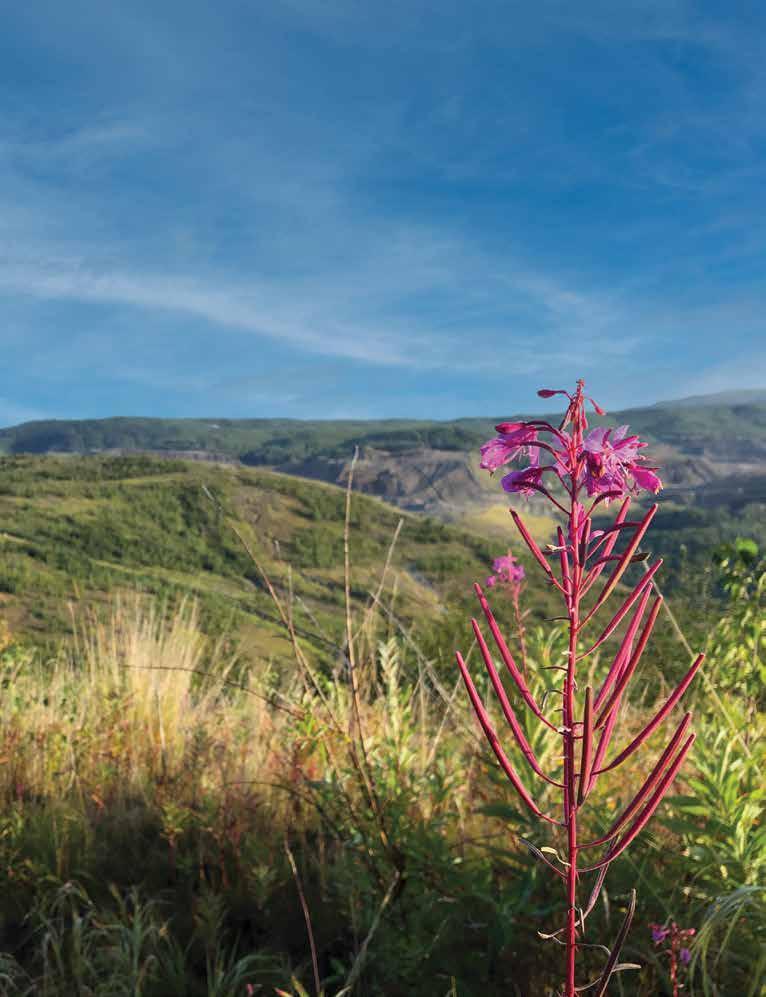


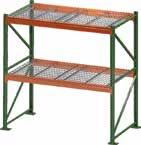

“Usibelli has a great story,” says Lisa Cassino, UCM vice president of public relations. “We remain family-owned and operated and the longest continually operated mine in the state.”
Leadership of the company passed from Emil Usibelli to his son, the late Joseph Usibelli Sr., and now to his grandson, Joe Usibelli Jr.

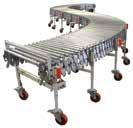







Approximately 322 direct and indirect Alaska employees rely on coal to make a living, according to Cassino. About one-third of those are UCM’s year-round employees, earning wages more than twice the statewide average. The mine’s statewide employment multiplier is about three—meaning that for every job created at the mine, two indirect and induced jobs are created elsewhere in the Alaska economy, according to McKinley Research Group.
“More than $48 million can be attributed to statewide wages related to coal mining,” Cassino says. “Onethird of our workforce are second, third, or fourth-generation coal miners. Whenever possible, UCM strives to do business locally or within Alaska.”



The impact is especially notable in the company’s hometown of Healy, about 115 miles south of Fairbanks and 10 miles north of the entrance to Denali National Park and Preserve. At Milepost 248 of the Parks Highway, the town has a history deeply entwined with mining, its largest year-round employer. About 10 percent of Healy’s population works at the mine, and those account for 85 percent of the mine’s total year-round jobs. It is the largest private-sector, yearround employer in the Denali Borough.
“There is a uniquely close bond between Usibelli Coal Mine and Healy,” says Borough Mayor Clay Walker. “In many ways, Healy is here because of the mine.”
If UCM is an economic backbone for Healy, it is a vital component of the energy generation strategy for the entire region.
“Interior Alaska already pays some of the highest energy costs in the nation. Without Usibelli coal, the ratepayers in the Interior would be paying an additional $240 million to $300 million



“We are also proud to support the resiliency and readiness of the Interior’s military installations. For eighty years, UCM has been supplying coal to support military operations.”
Lisa Cassino Vice President of Public Relations Usibelli Coal Mine
more in energy costs,” says Cassino. According to McKinley Research Group, Interior Alaska residents face annual energy costs more than double the national average: $5,300 annually for Fairbanks North Star Borough residents compared to the US average of $2,307.

The region’s energy producers rely on coal due to its affordable and stable pricing, well-developed local
 Todd Paris | UAF
Todd Paris | UAF
 The power plant on the UAF campus is one of Usibelli Coal Mine’s steady customers.
Emil Usibelli immigrated to the United States from Italy and came to Alaska in 1935 to work in mines near Palmer and in Suntrana, near Healy.
The power plant on the UAF campus is one of Usibelli Coal Mine’s steady customers.
Emil Usibelli immigrated to the United States from Italy and came to Alaska in 1935 to work in mines near Palmer and in Suntrana, near Healy.
production and supply chain, and the ability to stockpile quantities needed to ensure reliable energy supplies.
“Coal is a reliable fuel source that Alaskans can count on,” Cassino says. “When the wind doesn't blow or the sun doesn't shine, Usibelli coal is there. You can’t live without heat and power when it's cold and dark outside.”
In 2023, UCM expects to produce more than 1 million tons of ultra-low sulfur coal from its Two Bull Ridge and Jumbo Dome mines. From that annual haul, it provides fuel for six power plants: UAF, Aurora Energy in central Fairbanks, Fort Wainwright, Eielson Air Force Base, and Golden Valley Electric Association (GVEA) Healy Units 1 and 2.
These six coal-fired plants have a combined capacity of 165MW. In 2020, the coal-fired plants accounted for 50 percent of electricity generation in the Interior region, followed by naphtha and diesel fuel sources, at 26 percent and 12 percent respectively.
GVEA's Healy Units 1 and 2 are considered mine-mouth power plants. “Instead of transporting coal via the Alaska Railroad as we do with the power plants in the Fairbanks North Star
Borough, Usibelli directly hauls coal to GVEA's power plants via our haul trucks,” Cassino says. After Healy Units 1 and 2 burn the coal, trucks return ash to the mine for burial.
This stability of on-hand resources protects Interior populations from shortages and further price surges, Cassino adds. Interior communities are connected to the Railbelt grid via a 75MW electric transmission line. However, availability of power over the intertie is not guaranteed, according to the 2022 McKinley Research Group “Energy and Economic Impacts of Coal in Interior Alaska” report, so a local energy source adds resilience.
“Each power plant has an uninterruptible coal supply due to the stockpiles near the plants, averaging between forty and ninety days,” Cassino says. “We are also proud to support the resiliency and readiness of the Interior’s military installations. For eighty years, UCM has been supplying coal to support military operations.”

In terms of delivering coal to customers, UCM enjoys some
convenient and strategic partnerships that strengthen operations and support mutually beneficial business strategies.
One of those best-known business partnerships is the close tie between UCM and the Alaska Railroad, dating back to when train cars moved Emil Usibelli’s coal to Ladd Field in 1943.
“Both UCM and the Alaska Railroad have the same goal: to serve Alaskans in the Interior by providing heat and electrical power on a reliable and affordable basis,” says Christy Terry, director of external affairs for the Alaska Railroad Corporation.
“Our mission is to support and grow economic development within the state of Alaska,” Terry says. “This lines up with UCM’s objective, serving communities’ heat and power needs. To achieve that objective, UCM produces tons of coal best transported via rail service to Fairbanks and beyond. Using the Alaska Railroad is the most cost-effective means of moving mass quantities in a manner that ensures uninterrupted supply. Railroads can offer the most fuel-efficient way to move freight over land, each ton able to move up to 500 miles per gallon of fuel.”
Usibelli Coal Mine sponsored the 2023 Junior Nationals Cross Country Ski Championships interval start classic race in Fairbanks in March.Some UCM customers contract with the mine for delivered coal, and Usibelli subcontracts with the Alaska Railroad to make those deliveries. UAF and Aurora Energy contract for delivery directly with the railroad. Coal accounted for 27 percent of total freight tonnage in 2020 and 14 percent of total operating revenues earned for the railroad, according to the McKinley Research Group report, naming the railroad as one of the mine’s largest vendors.

The University of Alaska is another steady customer. UAF consumes about 80,000 tons of coal each year to heat and power campus buildings and facilities, according to UCM. If UAF were to generate this level of energy with only heating oil, UCM estimates that its energy costs would triple.
In 2022, Fort Wainwright and Eielson Air Force Base spent an estimated $27.5 million on coal purchases.
The abundance of coal deposits in Healy allowed UCM to begin exporting the resource in 1984 to South Korea via the Alaska Railroad’s terminal in Seward. Chile started buying Usibelli coal in 2003, and Japan began taking exports in 2008. Exports peaked in 2011, but then Chile and South Korea shifted away from overseas suppliers. By 2021, every bit of coal mined in Healy remained in Alaska for domestic consumption.
While UCM’s business is all about powering others, it must contend with how to power its own expansive operations.
According to Cassino, the mine’s largest piece of equipment is the “Acein-the-Hole” dragline, the largest landbased machine in Alaska, weighing just over 4 million pounds.
“The bucket on the front of the dragline can move approximately 33 cubic yards of dirt at a time,” she says. “The dragline operates on electricity, and in 1977 when we first ‘plugged in’ the machine, the power plant in Healy could not support both the dragline and the town of Healy. It caused power outages and flickering lights.”
Thus, a flywheel system was installed that operates parallel to the dragline and helps stabilize the power drawn from GVEA’s Healy power plants.
“Essentially, the cables and bucket are lifting a load, or dragging, using
“UCM is not only a major employer in the area, providing well-paying year-round jobs, but also a reliable contributor to community events and community needs.”
Clay Walker, Mayor, Denali Borough
large amounts of power,” Cassino says. “However, after the bucket has been emptied and the cables are swinging the bucket back out, they are generating power. The flywheel allows us to store the power that is being generated by the cables, until the dragline needs it.”
Other equipment in the UCM fleet—all the haul trucks, dozers, and excavators—use diesel fuel. To aid in maintaining the fleet, several of the mine’s trucks now carry technology that provides UCM with real-time data on oil levels, engine issues, and other diagnostics, allowing the maintenance department to schedule service with the least impact on operations.
Over the last several years, UCM has implemented other new technology, such as drone aircraft. More recently, the mine has been studying and engaging in opportunities to implement carbon capture, utilization, and storage. The company believes this technology can further assist power plants in burning more efficiently and cleaner.
Visitors to Healy would have a hard time finding the spot where Emil Usibelli
dug his first overground mine. UCM has a longstanding reclamation program that was implemented years before the government required it, restoring mined areas to something close to the original untouched terrain.
Cassino describes the company as stewards of the land, environment, and people.
“UCM is not only a major employer in the area, providing well-paying year-round jobs, but also a reliable contributor to community events and
community needs,” says Mayor Walker. “The family wage jobs at UCM drive school enrollment and positively impact all aspects of our local economy.”
UCM’s economic impact includes support of more than 100 nonprofit organizations through contributions by the mine and The Usibelli Foundation. Founded in 1991, The Usibelli Foundation has distributed more than $3 million to local charitable organizations over its thirty-year history, including $150,000 in 2022.
“One of my best days in the office is when I can volunteer at some of the community events and activities we support,” Cassino says. “I recently spent the day celebrating the incredible athleticism of more than 400 athletes at the 2023 Junior North American Cross Country Ski Championship races. It’s safe to say that you can find Usibelli Coal Mine supporting just about every signature event in Interior Alaska.”
With proven reserves of approximately 450 million tons, UCM could continue extracting 1 to 2 million tons every year and, after another eighty years, the mine would still have barely scratched the surface.
 Sundogs encircle the sunrise over the dragline at Usibelli Coal Mine.
Alex Legrismith | Usibelli Coal Mine
Sundogs encircle the sunrise over the dragline at Usibelli Coal Mine.
Alex Legrismith | Usibelli Coal Mine
“There is a uniquely close bond between Usibelli Coal Mine and Healy… In many ways, Healy is here because of the mine.”
Clay Walker, Mayor, Denali Borough








Kwethluk, a Yup’ik community of 812 residents about 12 miles east of Bethel, has some of the highest energy costs in Alaska.
The village on the Kwethluk River in the Yukon-Kuskokwim (YK) Delta is only accessible by boat or plane.
“The YK Delta pays 40 percent more than the national average for energy,” says Sean Glasheen, executive director of Nuvista Light and Electric Cooperative. “Almost all utilities here run and are powered by diesel… The YK needs to integrate some type of
alternative energy to survive, but it needs to do it in a way that’s sustainable.”
When planning that alternative, Glasheen says the first thing he asked himself was, “Can we build a meaningful system that will lower the cost of energy in a significant way for the utility and the people of Kwethluk?”
The solution that Nuvista hit upon is harnessing the abundant wind that blows across the delta.
Four wind turbines, each higher than 150 feet tall, will replace 50,000 gallons of diesel fuel and are expected to last

twenty to twenty-five years. Kwethluk’s new wind turbines will power half of the community’s electricity needs, as well as burning 50 percent less diesel and reduce residents’ electric bills by up to half.
Nuvista has been planning since 2016, when the Calista Energy Management Assistance Initiative was created with a grant from the US Department of Energy’s Office of Indian Energy. The initiative had to take a hard look at the grid as it is.

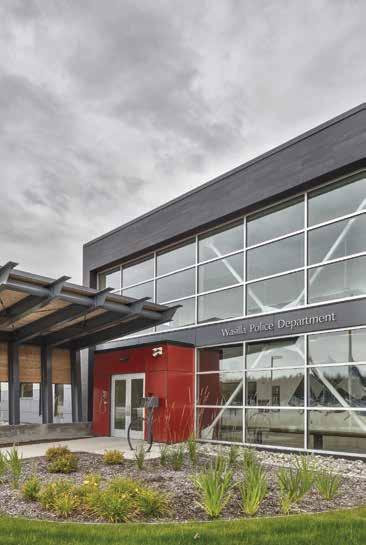
“Western Alaska local utilities are barebones with limited resources; most of the time they are struggling to run and poorly maintained,” says Glasheen. “Engineering a new system to come in and overlay/work together can be very challenging and almost always requires a significant update or replacement to the base original equipment. The design of the new system also needs to be simple enough that the local operators can understand and operate or troubleshoot the system.”
Wind turbines have been spinning for years in Bethel, downriver from
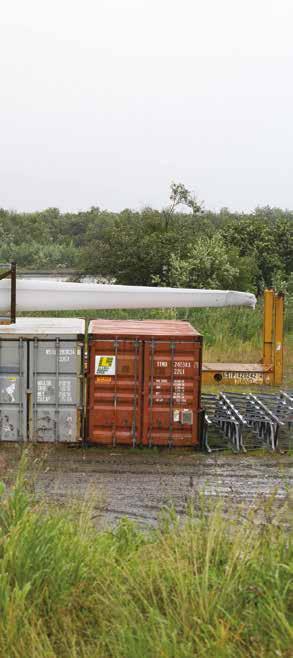
Kwethluk. On the coast, ocean breezes power Hooper Bay, Toksook Bay, Mekoryuk, Kwigillingok, and Kongiganak. And Nuvista is moving ahead with more alternative energy projects in YK Delta villages.
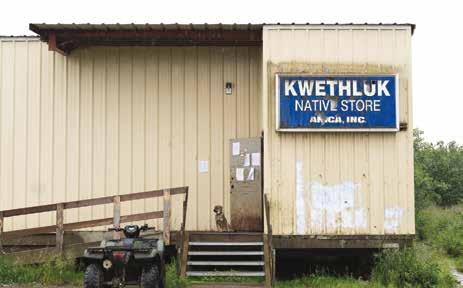
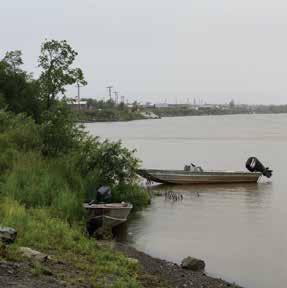
“We are currently working six different communities in the YK Delta to engineering renewable energy systems,” Glasheen says. “These systems will be a mix of solar/wind paired with a battery storage device.”
Blades for the new turbines arrived in Kwethluk in 2021, and they’ve been awaiting installation until this year. Another component arrived earlier: a lithium-ion battery capable of storing 675kWh, more than one hour’s worth of Kwethluk’s 450kW peak power demand. In addition to providing a backup during main generator outages, the battery allows for integration of renewable sources.
“Renewables like solar and wind become variable when the wind doesn’t blow and the sun doesn’t shine. Then energy storage is important to enable more renewable energy production in communities,” says Lee Bolling, senior project engineer with Coffman Engineers.
Storage is especially important in Nuvista’s service area, where each village is isolated from the next, unable to draw power from a wider grid. “The utility power systems in Alaska, for the most part, are microgrids and require extensive planning for equipment upgrades to confirm the economics
and the impacts of integrating new generation systems into the power grid,” says Jacob Pomeranz, a project engineer with Electric Power Systems (EPS) in Anchorage.
When integrating a new generation source into an existing power system, Pomeranz says, “Many renewable energy sources such as wind and solar provide intermittent power output that can cause issues on microgrids and small-scale power systems. These renewable sources need to be designed and integrated into the existing system without causing damage or outages to the customers.”
Wind and solar, in particular, contrast with other generation options that provide constant power output such hydro, oil, gas, or geothermal. Engineers blending multiple energy sources must design generation step up, transformers, switchyards, and station service for the new power generation auxiliary equipment.
Not all microgrids are isolated, and not all isolated grids are microgrids. The entire state of Texas, hardly micro, is famously its own grid. There are about 160 microgrids nationwide, some as small as a single self-sufficient building or a military base, but they may be connected to a regional grid by highvoltage transmission lines.
Bush Alaska’s isolated microgrids, the most extreme examples, are serving as models for distributed power systems globally.
“We have been doing microgrids way before microgrids were cool,” says Gwen Holdmann, UAF associate
“All utility projects have their own challenges, and that's what keeps most power engineers interested… Large or small design projects all have challenges to overcome before the design and implementation of the design is complete.”
Jacob Pomeranz Project Engineer Electric Power SystemsKwethluk Native Store is the only grocery store in the village of 812 residents.
vice chancellor of research for innovation and industry partnerships. “One of the ways that we’re moving, in terms of our energy supply and generation, is toward more distributed models, more decentralized models. There’s no place in the United States that’s more naturally decentralized than Alaska.”
Holdmann spoke at a panel during Arctic Encounter 2023 held
in Anchorage in March. The panel was moderated by Isaac Vanderburg, CEO of Launch Alaska, a nonprofit technology accelerator specializing in decarbonized energy and processes.
Vanderburg credits the state’s microgrid vanguard to inter-agency cooperation. “A lot of the projects that we’ve done in Alaska have a variety of players involved,” he says. “It’s the university, it’s a project developer, it’s a

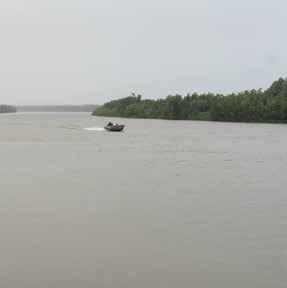
local community, village corporation. There’s a long laundry list of partners involved to get some of these projects done.”
One essential partner in any microgrid project is the engineer, an expert in the finicky physics of electrical circuits who brings together hardware to balance voltage,

WOW! We asked and you certainly delivered! Every March, the staff here at Alaska Business asks you to speak up and cast your ballot on the best businesses in various categories to create our annual Best of Alaska Business awards, published in July. And every year, you outdo yourself. This year we received a record number of votes. As you may know—especially if you voted— these awards have become a competitive benchmark for companies statewide.
“Winning the Best of Alaska Business award for ‘Best Accounting Firm’ is a source of pride for Altman, Rogers & Co. The award represents our staff’s achievements translating into a high level of client satisfaction. It boosts our camaraderie, and we look forward to every spring when we can vie for the privilege again!” says Chief Operating Officer Heather Garland, Altman Rogers & Co.
It’s nice to be recognized publicly and across the state. “The Best of Alaska Business bug goes out on every email I send,” says Development Director Jason Manalli of SetFree Alaska. “If we are viewed as a top place to work, that translates to hiring the best people, which means our clients will receive the best care.”
Thank you to everyone who voted for this year’s Best of Alaska Business award winners. In doing so, you’ve left an indelible mark on many Alaskan businesses that do the hard work daily to become what it takes to be the best. Now, all that’s left is waiting with anticipation for the July issue of Alaska Business to see who the 2023 winners are!
Lots of winners means lots of eyes on the July magazine; we’re so looking forward to sharing the results with you in the Alaska
Business July issue. To reserve ad space in this highly anticipated issue, contact us before the May 22 deadline!
Christine has worked in Anchorage media for almost 20 years. Her writing talents have earned her top honors as a recipient of the Alaska Broadcasters Association Goldie Awards. Her sales and marketing skills have helped countless clients connect with their target audience to achieve annual goals. She unapologetically lures clients in with her homemade raspberry jam and lives with her salmon slaying beau and a ferocious cat named Maggie.
Nuvista Light and Electric Cooperative’s 675kWh lithium-ion battery waits for wind turbines to start spinning in Kwethluk. Katie Basile | Nuvista Light and Electric Cooperativefrequency, phase, load, losses, and even economics.
EPS is an engineering consulting firm that provides a full range of services, from planning studies, design, construction, and start-up/ commissioning to periodic testing and maintenance. The company covers not only Alaska but also Hawaii, the Pacific Northwest, and the South Pacific.
The key elements EPS considers before proceeding with the design are project requirements, scheduling, and economics. Pomeranz says, “Project budgets are also key not only from a design cost but a construction cost as the project progresses. The project costs impact the utility ratepayers’ ability to pay utility bills, and producing cost effective designs is critical. Additionally, most utility projects require large, specialty equipment that needs to be specified early on in the project and designed around to facilitate timely procurement.”
At Coffman Engineers, Bolling’s team for a utility project includes the civil engineer who does the site evaluation, the structural engineer who considers any structures on site, and the electrical engineers who deal with the wiring and the transformers to convey power.
As a mechanical engineer, Bolling also deals with heat recovery and biomass energy systems, which are important technologies for providing heating to communities. For instance, Coffman provided upgrades to the heat recovery in Bethel that serves the hospital and other community buildings.
In Galena, Coffman provided multi-phase planning and engineering support for a project focused on modernizing the power plant in the Yukon River village and integrating solar photovoltaic and battery energy storage.
Pomeranz explains that utilities typically plan large capital improvement or replacement of critical assets after five to ten years. “The plan’s development is based on existing equipment age, utility load growth, new and alternative generation options, as well as retiring transmission or distribution lines. This allows the utilities to prepare budgets and plan for the future to provide
reliable cost-effective power to its customers,” he says.
The state’s isolated microgrids range from tiny to not-so-tiny, which makes each one a custom job.
“Utilities across Alaska vary in size, and how the new project impacts that utility varies greatly and therefore creates challenges,” says Pomeranz. “If I had to say what the most challenging project or projects are, it would have to be trying to reduce energy costs for Alaskan rate payers through new technology or efficiencies in modern equipment. If we can reduce energy cost, while providing reliable energy, we will increase jobs, reduce energy bills, and create a sustainable energy future for Alaska.”
One step down from that high-level view are the more pragmatic concerns that engineers face. “The most difficult hurdle when preparing an engineering plan is successfully understanding the utilities requirements and then
incorporating the requirements into a design that meets utilities' needs and budget,” Pomeranz says.
His colleague at EPS, engineer Chris Davis, works with power distribution and transmission. Davis says rightof-way (ROW) issues can complicate any project. “Generally, the most difficult problems have been right of way and clearance issues,” Davis says, “specifically when the ROW has been undersized for future development.”
Utility projects also must be designed for resilience despite a changing climate posing hazards from landslides or floods. “The simplest solution for telecom in areas with avalanches and landslides is to simply underground the infrastructure below the expected avalanche scour,” Davis says. “This unfortunately increases the project expense.”
In Bush Alaska nothing is ever simple, and work there can throw some unexpected curve balls. “All utility projects have their own challenges, and that's what keeps most power engineers interested,” Pomeranz says. “Large or small design projects all have challenges to overcome before the design and implementation of the design is complete.”
In Kwethluk, Glasheen is looking ahead to wind turbine construction, as parts arrive and the team comes together.
“The construction phase has been the most challenging for sure,” Glasheen says. “We live in rural Alaska where you have to improvise to make things work. This can add a significant amount of time to the project; if you need any parts to move to the next step, you are at the mercy of the weather and the next plane/boat coming in.”
The Kwethluk wind power project cost $6.5 million with grants from state and federal funding. Glasheen expects the turbines will be up and turning later this year.
Still, he stays flexible because, in Alaska, anything can go sideways.
He says, “The systems needed to be built in a phased approach. As technology and funds became available, we wanted the flexibility to adapt to these changes to get Kwethluk the best product.”
“Western Alaska local utilities are barebones with limited resources; most of the time they are struggling to run and poorly maintained… The design of the new system also needs to be simple enough that the local operators can understand and operate or troubleshoot the system.”
Sean Glasheen, Executive Director Nuvista Light and Electric Cooperative
EL E CT R I C P O W E R C O N S T R U C T O R S , I N C .

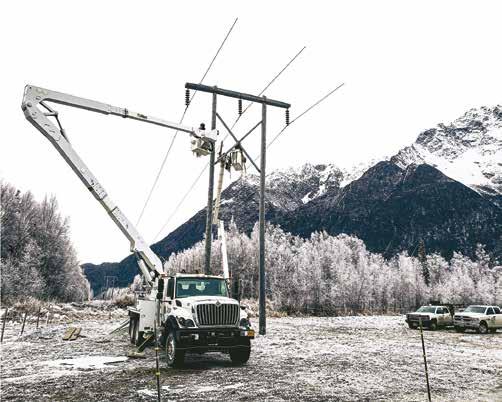
In de p e n d en t L i c e ns e d A l a s k a n E le ct r i c al C on s t r u ct ion C o n t r a c t or


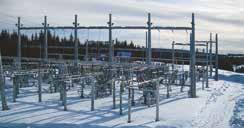



Two institutions that span Southeast Alaska are now one. Tongass Federal Credit Union (TFCU) merged with ALPS Federal Credit Union, keeping the TCFU name. The organization combines assets worth $233.4 million serving 13,163 members with eight branches (Ketchikan, Sitka, Petersburg, Metlakatla, Klawock, Wrangell, Haines, and Juneau) and four community microsites (Thorne Bay, Hydaburg, Kake, Hoonah). TFCU President and CEO Helen Mickel continues to lead the merged credit union. tongassfcu.com
The Point Hope Native Store (PHNS) is becoming the thirty-sixth Alaska Commercial Company (AC) location in the state and the chain’s third store in the North Slope Borough. Tikigaq, the village corporation for Point Hope, has been operating the PHNS but is handing over the store to AC. Throughout 2023, AC plans to invest in renovations, such as added refrigeration to expand the availability of fresh food, while planning for construction of a new grocery store in Point Hope. alaskacommercial.com
Every Alaska resident is part owner of the Three Bears Alaska supermarket chain, through an investment by the Alaska Permanent Fund Corporation. Most of the fund’s earnings come from out-of-state assets, but managers set aside $200 million in 2018 to boost in-state
businesses. Last year, Three Bears received a capital injection from a Seattle-based private equity firm, and recent reporting found that the firm was handling the Permanent Fund’s money. Other Alaska companies receiving Permanent Fund capital include All Alaska Tours, Fleetzero electric cargo ships, and Macro Oceans seaweed products. threebearsalaska.com
Anglers in need of an all-in-one cooler can find an Alaskan solution at Bass Pro Shops and Cabela’s. The national chains reached a distribution deal with PacBak, maker of the P88-MK Cooler/ROAM 18-V Vacuum Sealer Combo invented by Brian McKinnon of Wasilla. The invention already had national distribution through Army Air Force Exchange Stores. The deal with Bass Pro Shops and Cabela’s puts PacBak in 177 locations, starting with Alaska stores this month. pacbak.com
Alaska Behavioral Health is opening a new Certified Community Behavioral Health Clinic (CCBHC) near downtown Wasilla. CCBHCs offer crisis services, screening and evaluation, outpatient mental health, primary care screening and monitoring, client-centered treatment planning, targeted case management, psychiatric rehabilitation services, and peer and family supports. “We’ve been painfully aware of the shortage of behavioral health services in the Mat-Su for a long time,” COO Joshua Arvidson says. alaskabehavioralhealth.org
Alaska Auto Rental is expanding its service area to a new location near Valdez Airport. The shop at 300 Airport Road offers a selection of cars, SUVs, trucks, and vans for rental and leasing services in Valdez, as well as one-way rentals between Valdez and any other city in Alaska. Alaska Auto Rental has been operating since 2011 and now has the largest independent car rental fleet in Alaska. alaskaautorental.com
Stretching beyond its home territory, Alaska Rubber Group is rebranding with a less geographically specific name. ARG Industrial is the new moniker for the company, which previously consolidated with Alaska Rubber & Rigging Inc. and Arctic Wire Rope & Supply. The supplier of belts, hoses, and chains has also acquired subsidiaries in Washington and Oregon, and the rebranding retires those historical trade names. alaskarubbergroup.com
Australian oil and gas company 88 Energy is proceeding with an exploration well at a North Slope unit formerly named Icewine East. The Alaska Oil and Gas Conservation Commission granted permission to drill the Hickory-1 well at the renamed Project Phoenix, straddling the Dalton Highway and Trans Alaska Pipeline System corridor. The Alaska Division of Oil and Gas also approved partial unitization of Project Phoenix acreage, forming the Toolik River Unit. 88energy.com



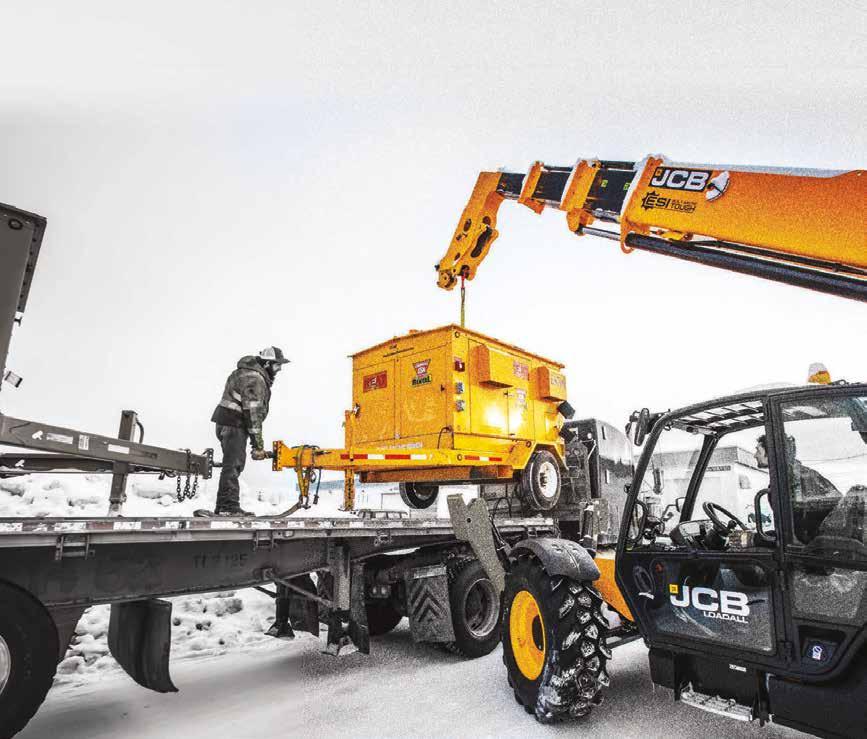


The holding company for Ahtna, Inc. regional corporation, Ahtna Netiye’, has a new CEO. Chief Operating Officer Roy Tansy Jr. is promoted to CEO, succeeding Tom Maloney, who is retiring after eight years with the company. As CEO, Tansy is responsible for providing strategic leadership for Ahtna subsidiaries. An Ahtna shareholder, Tansy is originally from the Ahtna village of Cantwell and a member of the Caribou (Udzisyu) clan. His professional background includes management in facilities, security, oil and gas, and construction. He has held positions with the Ahtna family of companies for thirty years. Tansy currently sits on the boards of the Alaska Native Heritage Center and the Alaska Chamber of Commerce.



The executive board of the Alaska World Affairs Council (AKWorld) named Lisa Eyler as its new President and CEO. She succeeds Lise Kristiansen, who led AKWorld for sixteen years. Eyler has been with AKWorld for fourteen years as a volunteer and board member, sharing its mission to advance international understanding and engagement, “bringing the world to Alaska” by stimulating interest in world affairs and inspiring members to be involved in world events. Eyler brings more than twenty years of executive leadership in nonprofit, natural resources, and cross-
cultural communications fields. She holds a JD from the University of Oregon Law School and has consulted for nonprofits, industry, and governmental entities. She served as Alaska program director of the Conservation Lands Foundation, senior project manager of Environmental Resources Management, and executive director of The Great Land Trust.


Denali State Bank named Myron Dosch its Senior Vice President and Chief Financial Officer. As the CFO, Dosch oversees the bank's assets and liabilities, securities portfolio, and finance department. Dosch has extensive experience with accounting, finance, and management. He holds a bachelor’s degree in accounting from Gonzaga University and an MBA in capital markets from UAF. He is also a certified public accountant.
The oldest and largest full-service local community bank in Fairbanks, Mt. McKinley Bank, promoted several team members to executive positions.

Kaye Kingkade is now Executive Vice President and COO. Kingkade joined the Mt. McKinley Bank team thirty-five years ago as a teller and has worked her way up through the department to become its newest leader. Having worked side-by-side with the previous COO for many years, Kingkade brings invaluable

knowledge and experience to the position.
Stephanie Smith is promoted to Vice President, Operations Development Officer. Smith has been an integral part of the Operations Department since joining the bank in 2009. She has proven herself as a “go-to” person, willing to fill any role asked of her, and excels at her primary responsibilities within the New Accounts area. Smith holds an associate degree in business administration and is very active in the Fairbanks/North Pole communities.
Linda Benson becomes Mt. McKinley Bank’s Assistant Vice President, Mortgage Lending. Benson has been a key member of the Mortgage Loans Department since she joined the bank in 2012. Her unique background in law and her degrees in political science and business administration have proven their value to the team, and her keen eye for detail and vast knowledge of bank regulations provides borrowers with top-of-the-line customer service.
Matt Bradbury is now Assistant Vice President, Branch Manager. Bradbury has been an important member of the Operations team since coming to Alaska and starting his career at Mt. McKinley Bank in 2014. He has been a key person at the North Pole branch for many years and is active in the North Pole Rotary Club and North Pole Chamber of Commerce. Bradbury also serves on the employee wellness

committee, encouraging coworkers to enjoy the great outdoors with summer hikes.
Employees at engineering firm R&M Consultants have been promoted to senior level positions, reflecting years of experience and expertise in their respective fields.
Ryan Goentzel is now a Senior Project Engineer.
Goentzel has been with R&M since 2007, starting as an intern in the firm’s Engineering Department. His most recent position is Surface Transportation Project Engineer. With seventeen years of experience, his focus has been leading and coordinating the design of highways, roundabouts, pathways, culverts, grading, drainage, and signing and striping plans. Goentzel has worked on projects for clients at the local, regional, and state level across Alaska.
Josh Chaney is promoted to Senior Project Engineer in R&M’s Structural Engineering Group. Chaney has been with R&M for two years. He has sixteen years of structural engineering experience, with thirteen years in Alaska's oilfield services industry. Chaney’s engineering responsibilities have included producing engineering calculations, creating design drawings, providing budget estimates, generating scopes of work, creating material requisitions, reviewing fabrication drawings, conducting field visits and preparing reports, building inspection, and providing construction support.
Lisa Morris is now a Senior Graphic Designer. Morris has twenty-two years of professional design experience, eighteen of those in Alaska’s A/E/C sector. She has been with R&M since 2020 and specializes in developing custom graphics that persuade and inform end user audiences. Morris’s skills include corporate and project branding, collateral design, project visual identities, report design, infographics, historical displays, copywriting, and editing. She has a proven ability to efficiently execute simple or complex ideas in graphic form and enjoys collaborating on projects from concept to completion.

Courtney Maillet has been promoted to Senior Project Accountant. Maillet has sixteen years of financial experience and has been with R&M for twelve years. She is knowledgeable in all aspects of business accounting. Maillet’s responsibilities include maintaining contract compliance, managing and reporting project financials and budgets, managing accounts receivable and payable, and assisting with database configuration.

The founder of an Anchorage aerospace firm is lending his business acumen to aspiring entrepreneurs. The University of Alaska Center for Economic Development at UAA signed Ben Kellie to serve as Entrepreneur-in-Residence. In this role, the CEO of The Launch Company can apply his years of experience to

coaching, mentoring, and broader entrepreneurial ecosystem building. Kellie has a bachelor’s degree in mechanical engineering from UAF and a master’s degree in mechanical engineering from The Ohio State University. Kellie worked in rocketry at SpaceX, designing and operating launch sites. His startup, The Launch Company, was acquired by Voyager Space in 2021, and he remains its CEO.


The Juneau Arts & Humanities Council (JAHC) began 2023 with new leadership. Phil Huebschen is the organization’s new Executive Director, responsible for fund development, grant and fiscal management, program management, community relations, advocacy, strategic planning, and supervising JAHC staff. Huebschen returns to his hometown after working as associate director of the UCLA Chancellor’s Society in Los Angeles. He succeeds the organization’s longtime leader, Nancy DeCherney, who retired in May 2022, and interim executive directors Reggie Schapp and Jennifer Quinto.
Another Juneau native with experience in the Lower 48 is JAHC’s new Technical Director. Zachary Pease is responsible for mounting events at Centennial Hall and the Juneau Arts and Culture Center, such as maintaining equipment, ensuring safety of the facilities, and supervising the event crew. Pease has experience in event productions from freelancing at numerous festivals, such as running event technology for Anime Expo 2022, Burning Man, and D23 Disney Convention 2022.
For more information, please visit us at www.nac .aero.


Northern Air Cargo is committed to getting your cargo where it needs to be, on time, so you can worry about what really matters.Goentzel Chaney Morris Maillet Kellie
Before Ship Creek in Anchorage became a railroad construction base in 1915, the largest community in upper Cook Inlet was Knik. What people might not appreciate is that, although the population crown has shifted across the arm, Knik still comes in second.
It’s true: Knik-Fairview is the most populous censusdesignated place (CDP) in all of Alaska, with 19,297 residents in 2020, more than double the 9,054 residents in neighboring Wasilla. Fellow unincorporated areas North Lakes and Meadow Lakes likewise dwarf their incorporated neighbor, while the city of Palmer has fewer people than the non-city of Tanaina. The Gateway, South Lakes, and Fishhook neighborhoods rank among the state’s most populated places, too, despite having such a low profile that some residents never heard those names before. (The US Census Bureau split the “Lakes” area into north and south tracts for the 2020 census.)
The Matanuska-Susitna Borough is surprisingly vast. The watersheds of its namesake rivers encompass as much land
as West Virginia, stretching the borough’s boundaries from Lake Louise in the east to the headwaters of the Skwentna and Yentna Rivers in the west, and from Susitna Glacier on the north side of the Denali Highway to the river delta just outside Chugach Electric Association’s Beluga power station.
This month’s article “Where the Patients Are” describes healthcare services coming to the Mat-Su in response to the area’s continued population growth. Services and amenities naturally fill in as demand builds, and in the Mat-Su many services—like healthcare—are overdue.
One reason why some services may lag behind is that the majority of Mat-Su’s growth is invisible from the Parks or Glenn Highways; casual passersby may never notice it. Many of the region’s residents find it attractive because of the privacy that it offers. But highway or no, census takers go wherever there are people to count, allowing Alaska Trends to peek over the proverbial fence at the state’s quietly booming boomtowns.
SOURCE: US Census Bureau, 2020 Census Results
The
10,949 Veterans
9.8% of residents being military veterans compares to 6.4% nationally.
The Mat-Su Borough's population growth in the last decade outpaced the statewide rate of 2.6%
$79,300 median household income
$35,929 per capita income
This is 10.8% less than the median household income of $88,871 in Anchorage.
6% under 5 years
26% under 18 years
55% 18-55 years
13% 65+ years
As the Mat-Su Borough population grows, so does its impact on Alaska's economy. The 2020 census reported a
3.4% growth in employment 20,594 total employment $1 Billion annual payroll
The fastest growing population in the Mat-Su Borough was in the 65+ age group, up 104.4% since 2010.
‘20
‘10
As the Mat-Su Borough grows, so does its population below the poverty line. 10.5% Mat-Su residents lived below the poverty line in 2017 compared to 9.5% of Anchorage residents in 2017.
The graph shows the population in each CDP and incorporated city in the last three censuses. Note that North Lakes and South Lakes were counted together until 2020.
The average resident spends 36 minutes in travel time to work.
What book is currently on your nightstand?
The Wealth and Poverty of Nations by David Landes.
What charity or cause are you passionate about?
St. Jude’s Children’s Research Hospital.
What’s the first thing you do when you get home after a long day at work? Catch up on local and national news, go for a run or a bike ride (time permitting), then have a relaxing dinner with my wife.

What vacation spot is on your bucket list? Tahiti.
If you could domesticate a wild animal, what animal would it be?
I have no interest in domesticating wild animals, but if required, a Bengal tiger.
Photos by Monica WhittOnce each, if anyone was wondering how many times Chugach Electric Association CEO Arthur Miller has seen Death of a Salesman and The Crucible by the same-named playwright.
After more than thirty years with the state’s largest electric utility, Miller stepped up to become number-one man in 2022. He comes to the industry with a degree in regulatory economics, which he applied at the Baby Bell telecom now named Qwest before he moved to Alaska in 1990.

Miller had a good dream, once, of becoming an emergency room physician, drawn by the fast-paced, high intensity environment while helping people at the same time. Now he helps people sixty times every second—the frequency of alternating current that Chugach Electric steadily supplies for its member-customers and Railbelt counterparts. Overseeing such a complex operation and ensuring its reliability and affordability is a duty Miller takes seriously.
Alaska Business: What do you do in your free time?
Arthur Miller: I enjoy reading, boating in Prince William Sound, kayaking, mountain biking, running, hiking, meeting up with friends, mechanical tinkering.
AB: Is there a skill you’re currently developing or have always wanted to learn?
Miller: I have always wanted to learn how to weld, especially with aluminum. Building an aluminum boat, making specialized tools, and making metal artwork would be a lot of fun.
AB: What’s the most daring thing you’ve ever done?
Miller: I climbed Denali when I was 18 years old. We started from Wonder Lake, crossed the McKinley River, and hiked 20 miles to the base before starting up the mountain. It took thirty-three days round trip to the top
and back, with a five-day storm delay that resulted in us camping in a crevasse at 16,400 feet. Our provisions were running very low, but, in the end, the storm passed and we made it to the summit in 18 hours from that point.
AB: Have you had a supernatural experience?
Miller: Several friends and I hiked to a saddle well above tree line between two mountain peaks, and a thunderstorm rolled in. Our ice axes started humming—a high-pitched buzzing sound—and then our hair started standing on end.
AB: What’s your favorite local restaurant?
Miller: Little Italy.
AB: Dead or alive, who would you like to see perform live in concert?
Miller: U2.
AB: What’s your greatest extravagance?
Miller: Traveling to a foreign country with my wife and exploring the countryside, with no constraints or commitments.
AB: What’s your best attribute and worst attribute?
Miller: I am an eternal optimist with a positive attitude. I am passionate about work and the drive for continual improvement. I am always excited to start the day early, recognizing that the number of hours in the day is limited. My strengths can also be my worse attributes, and I recognize that it’s critical to strike the appropriate balance, depending on the situation.







